AlphaTheta DM40BT Active Monitor Speaker User Manual part 1
Pioneer DJ Corporation Active Monitor Speaker part 1
Contents
- 1. User manual part 1
- 2. User manual part 2
User manual part 1
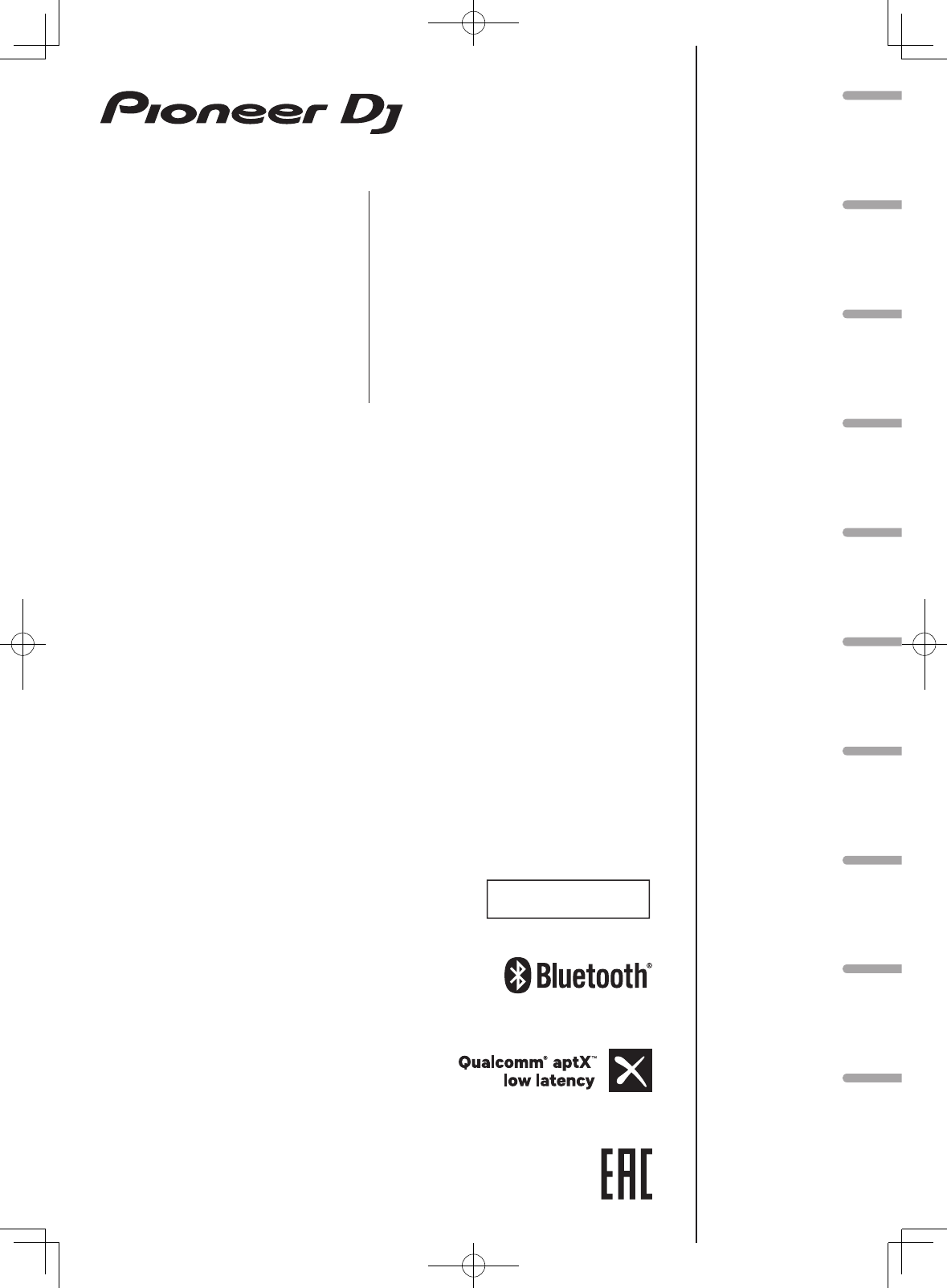
DM-40BT
DM-40BT-W
Active Monitor Speaker
Haut-parleur de Moniteur Actif
Aktiver Monitorlautsprecher
Diffusore Monitor Attivo
Actieve Monitorluidspreker
Altavoz Monitor Activo
Coluna de Monitor Ativa
Активная Акустическая Система
ᆀ઼ԥྜඵᖑᏣ
アクティブモニタースピーカー
Operating Instructions
Mode d’emploi
Bedienungsanleitung
Istruzioni per l’uso
Handleiding
Manual de instrucciones
Manual de instruções
Инструкции по эксплуатации
ᐈձКь
取扱説明書
pioneerdj.com/support/
The Pioneer DJ support site shown above offers FAQs, information on software and various other types of
information and services to allow you to use your product in greater comfort.
Le site de support DJ de Pioneer indiqué ci-dessus propose une FAQ, des informations sur le logiciel et divers
types d’informations et de services qui permettent une utilisation plus confortable de ce produit.
Die oben gezeigte Pioneer DJ-Support-Website enthält häufig gestellte Fragen, Informationen über Software
und andere wichtige Informationen und Dienste, die Ihnen helfen, Ihr Produkt optimal zu verwenden.
Il sito di supporto DJ Pioneer indicato qui sopra offre una sezione FAQ, informazioni sul software ed
informazioni e servizi di vario tipo, per permettere un uso più confortevole dei nostri prodotti.
De bovengenoemde Pioneer DJ ondersteuningswebsite biedt een overzicht van de vaak gestelde vragen,
informatie over software en allerlei andere soorten informatie en diensten die u in staat stellen dit product met
meer gemak te gebruiken.
El sitio de asistencia Pioneer DJ mostrado arriba ofrece las preguntas frecuentes, información del software y
varios otros tipos de información y servicios que le permitirán usar su producto con mayor confort.
O site de suporte da Pioneer DJ mostrado acima oferece FAQs, informações sobre o software e outros tipos
de informações e serviços para permitir utilizar o produto com um maior conforto.
На указанном выше сайте поддержки Pioneer DJ содержатся раздел часто задаваемых вопросов,
информация по программному обеспечению, а также различные другие типы информации и услуг,
позволяющие использовать ваше изделие более лучшим образом.
αРᡘұޠӒᎣEKМනᆪયණٽGBRȃᡞၦଊІөԓڐуޠၦଊᇅ݉ଡ଼ȂѠᡲ்Р߰ޠٻңࠣȄ
上記のPioneerDJサポート サイトでは、困ったときのよくある質問やソフトウェアの情報など、より快適に製品をお使い
いただくための各種情報やサービスを提供しております。
商品相談・修理受付・付属品購入窓口のご案内
お取り扱いにお困りのとき、本書の巻末をご覧ください。 保証書付き
日本語Français DeutschItaliano
English NederlandsEspañolPortuguêsРусскийϜН
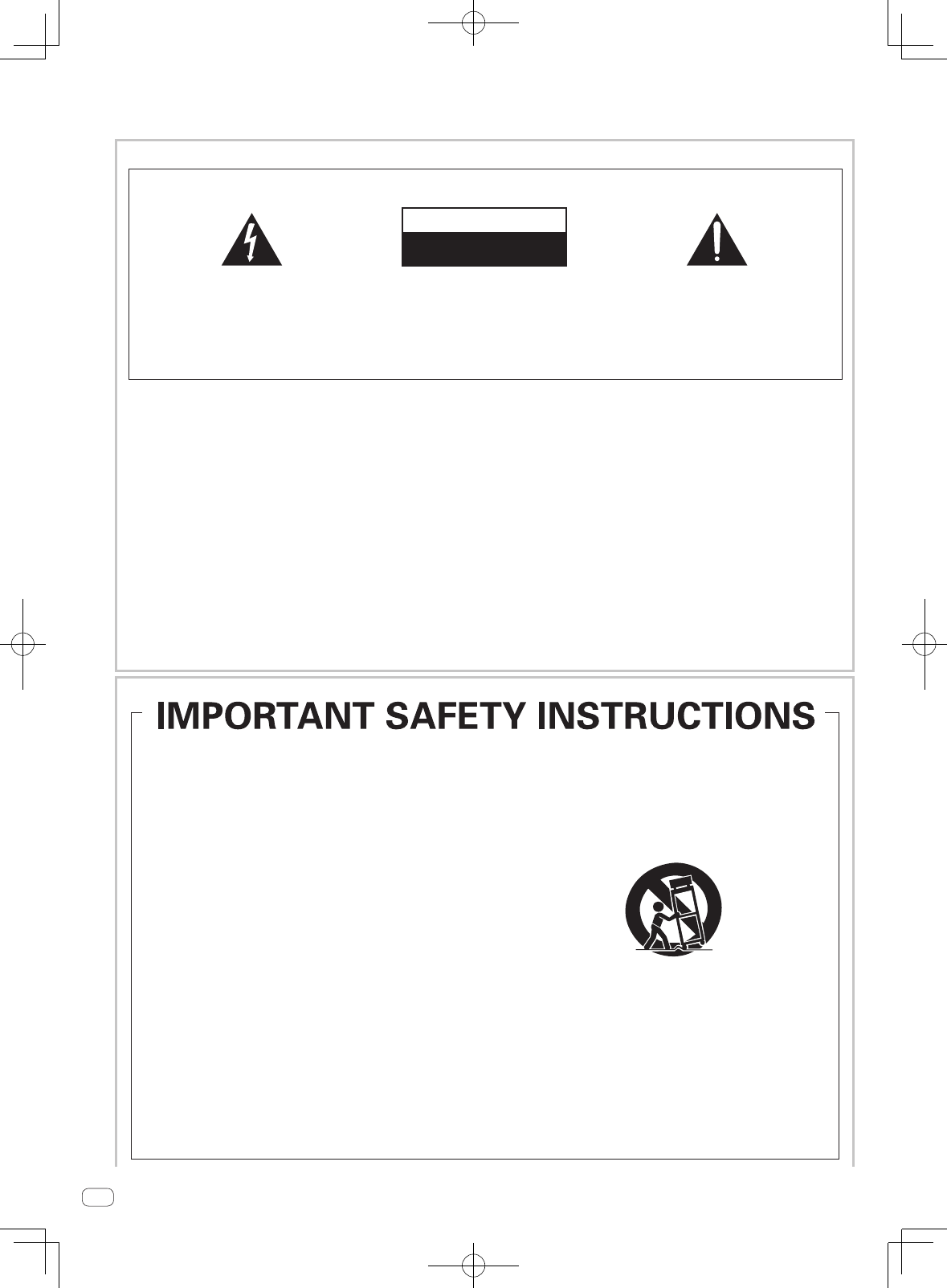
En
2
Thank you for buying this Pioneer DJ product.
Please read through these operating instructions so you will know how to operate your model properly.
After you have finished reading the instructions, put them away in a safe place for future reference.
[For American Users and Canadian Users]
The exclamation point within an equilateral
triangle is intended to alert the user to the
presence of important operating and
maintenance (servicing) instructions in the
literature accompanying the appliance.
The lightning flash with arrowhead symbol,
within an equilateral triangle, is intended to
alert the user to the presence of uninsulated
“dangerous voltage” within the product’s
enclosure that may be of sufficient
magnitude to constitute a risk of electric
shock to persons.
CAUTION:
TO PREVENT THE RISK OF ELECTRIC
SHOCK, DO NOT REMOVE COVER (OR
BACK). NO USER-SERVICEABLE PARTS
INSIDE. REFER SERVICING TO QUALIFIED
SERVICE PERSONNEL.
CAUTION
RISK OF ELECTRIC SHOCK
DO NOT OPEN
IMPORTANT
D3-4-2-1-1b_A1_En
The Safety of Your Ears is in Your Hands
Get the most out of your equipment by playing it at a safe level – a level that lets the sound come through clearly without
annoying blaring or distortion and, most importantly, without affecting your sensitive hearing. Sound can be deceiving.
Over time, your hearing “comfort level” adapts to higher volumes of sound, so what sounds “normal” can actually be
loud and harmful to your hearing. Guard against this by setting your equipment at a safe level BEFORE your hearing
adapts.
ESTABLISH A SAFE LEVEL:
• Set your volume control at a low setting.
• Slowly increase the sound until you can hear it comfortably and clearly, without distortion.
• Once you have established a comfortable sound level, set the dial and leave it there.
BE SURE TO OBSERVE THE FOLLOWING GUIDELINES:
• Do not turn up the volume so high that you can’t hear what’s around you.
• Use caution or temporarily discontinue use in potentially hazardous situations.
• Do not use headphones while operating a motorized vehicle; the use of headphones may create a traffic hazard and is
illegal in many areas. S001a_A1_En
[For American Users]
Read these instructions.
Keep these instructions.
Heed all warnings.
Follow all instructions.
Do not use this apparatus near water.
Clean only with dry cloth.
Do not block any ventilation openings. Install in
accordance with the manufacturer’s
instructions.
Do not install near any heat sources such as
radiators, heat registers, stoves, or other
apparatus (including amplifiers) that produce
heat.
Do not defeat the safety purpose of the polarized
or grounding-type plug. A polarized plug has two
blades with one wider than the other. A
grounding type plug has two blades and a third
grounding prong. The wide blade or the third
prong are provided for your safety. If the provided
plug does not fit into your outlet, consult an
electrician for replacement of the obsolete outlet.
Protect the power cord from being walked on or
pinched particularly at plugs, convenience
receptacles, and the point where they exit from
the apparatus.
1)
2)
3)
4)
5)
6)
7)
8)
9)
10)
Only use attachments/accessories specified by
the manufacturer.
Use only with the cart, stand, tripod, bracket, or
table specified by the manufacturer, or sold with
the apparatus. When a cart is used, use caution
when moving the cart/apparatus combination to
avoid injury from tip-over.
Unplug this apparatus during lightning storms
or when unused for long periods of time.
Refer all servicing to qualified service personnel.
Servicing is required when the apparatus has
been damaged in any way, such as power-supply
cord or plug is damaged, liquid has been spilled
or objects have fallen into the apparatus, the
apparatus has been exposed to rain or moisture,
does not operate normally, or has been dropped.
D3-7-13-69_En
11)
12)
13)
14)
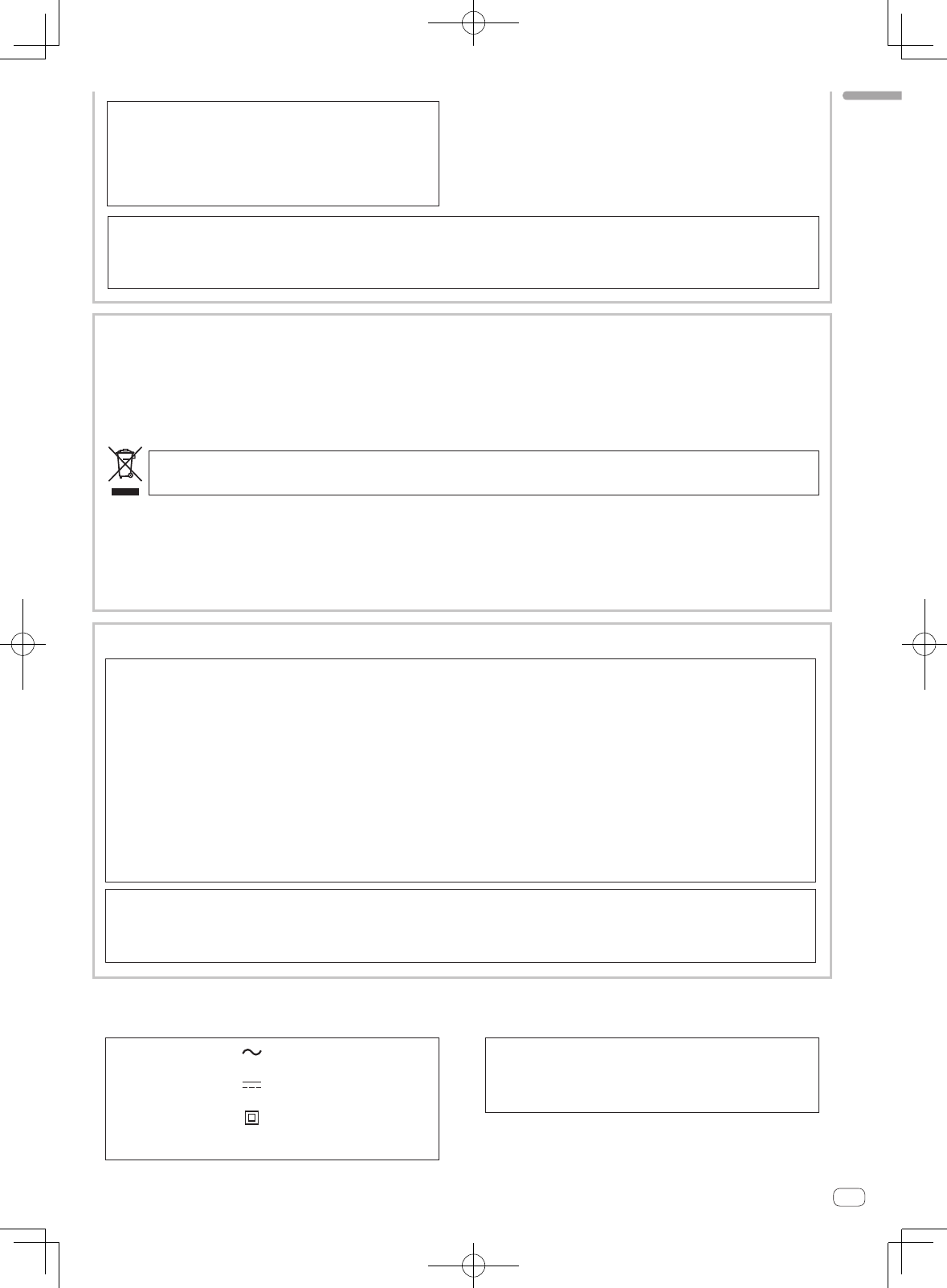
En 3
[For European Users]
If you want to dispose this product, do not mix it with general household waste. There is a separate collection system for used
electronic products in accordance with legislation that requires proper treatment, recovery and recycling.
Private households in the member states of the EU, in Switzerland and Norway may return their used electronic products free of charge to
designated collection facilities or to a retailer (if you purchase a similar new one).
For countries not mentioned above, please contact your local authorities for the correct method of disposal.
By doing so you will ensure that your disposed product undergoes the necessary treatment, recovery and recycling and thus prevent potential
negative effects on the environment and human health.
K058b_A1_En
CAUTION
TO PREVENT THE RISK OF ELECTRIC SHOCK, DO NOT
REMOVE COVER (OR BACK). NO USER-SERVICEABLE
PARTS INSIDE. REFER SERVICING TO QUALIFIED
SERVICE PERSONNEL. D3-4-2-1-1_B1_En
IMPORTANT NOTICE
THE MODEL NUMBER AND SERIAL NUMBER OF THIS EQUIPMENT ARE ON THE REAR OR BOTTOM.
RECORD THESE NUMBERS ON PAGE 11 FOR FUTURE REFERENCE.
D36-AP9-3*_A1_En
Caution
To prevent fire hazard, the Class 2 Wiring Cable
should be used for connection with speaker, and
should be routed away from hazards to avoid damage
to the insulation of the cable.
D3-7-13-67*_A1_En
NOTE:
This equipment has been tested and found to comply with the limits for a Class B digital device, pursuant to Part 15
of the FCC Rules. These limits are designed to provide reasonable protection against harmful interference in a
residential installation. This equipment generates, uses, and can radiate radio frequency energy and, if not installed
and used in accordance with the instructions, may cause harmful interference to radio communications. However,
there is no guarantee that interference will not occur in a particular installation. If this equipment does cause
harmful interference to radio or television reception, which can be determined by turning the equipment off and on,
the user is encouraged to try to correct the interference by one or more of the following measures:
— Reorient or relocate the receiving antenna.
— Increase the separation between the equipment and receiver.
— Connect the equipment into an outlet on a circuit different from that to which the receiver is connected.
— Consult the dealer or an experienced radio/TV technician for help.
D8-10-1-2_A1_En
Information to User
Alterations or modifications carried out without appropriate authorization may invalidate the user’s right to operate
the equipment.
D8-10-2_A1_En
[For American Users and Others]
The graphical symbol placed on the product
means alternating current.
The graphical symbol placed on the product
means direct current.
The graphical symbol placed on the product
means Class II equipment.
D3-8-2-4_A1_En
CAUTION
This product is evaluated in moderate climate
condition.
D3-8-2-1-7b_A1_En
English

En
4
WARNING
This equipment is not waterproof. To prevent a fire or
shock hazard, do not place any container filled with
liquid near this equipment (such as a vase or flower
pot) or expose it to dripping, splashing, rain or
moisture.
D3-4-2-1-3_A1_En
WARNING
To prevent a fire hazard, do not place any naked flame
sources (such as a lighted candle) on the equipment.
D3-4-2-1-7a_A1_En
VENTILATION CAUTION
When installing this unit, make sure to leave space
around the unit for ventilation to improve heat radiation
(at least 15 cm at top, 15 cm at rear, and 15 cm at each
side).
D3-4-2-1-7d*_A1_En
POWER-CORD CAUTION
Handle the power cord by the plug. Do not pull out the
plug by tugging the cord and never touch the power
cord when your hands are wet as this could cause a
short circuit or electric shock. Do not place the unit, a
piece of furniture, etc., on the power cord, or pinch the
cord. Never make a knot in the cord or tie it with other
cords. The power cords should be routed such that they
are not likely to be stepped on
. A damaged power cord
can cause a fire or give you an electrical shock. Check
the power cord once in a while. When you find it
damaged, ask your nearest se
rvice center or your
dealer for a replacement.
S002*_A1_En
Precaution for the DM-40BT/DM-40BT-W
Do not connect this speaker to any amplifier other
than the one supplied with this system. Connection
to any other amplifier may result in a malfunction or
a fire.
SGK006_A1_En
This product is for general household purposes. Any
failure due to use for other than household purposes
(such as long-term use for business purposes in a
restaurant or use in a car or ship) and which requires
repair will be charged for even during the warranty
period.
K041_A1_En
Do not attach these speakers to the wall or ceiling, as
they may cause injury in the event of a fall.
SGK007_A1_En
Operating Environment
Operating environment temperature and humidity:
+5 °C to +35 °C (+41 °F to +95 °F); less than 85 %RH
(cooling vents not blocked)
Do not install this unit in a poorly ventilated area, or in
locations exposed to high humidity or direct sunlight (or
strong artificial light).
D3-4-2-1-7c*_A2_En
WARNING
Slots and openings in the cabinet are provided for
ventilation to ensure reliable operation of the product,
and to protect it from overheating. To prevent fire
hazard, the openings should never be blocked or
covered with items (such as newspapers, table-cloths,
curtains) or by operating the equipment on thick carpet
or a bed.
D3-4-2-1-7b*_A1_En
This transmitter must not be co-located or operated
in conjunction with any other antenna or transmitter.
D8-9-2-5_A1_En
This equipment complies with FCC radiation
exposure limits set forth for an uncontrolled
environment and meets the FCC radio frequency (RF)
Exposure Guidelines. This equipment has very low
levels of RF energy that it deemed to comply without
maximum permissive exposure evaluation (MPE). But
it is desirable that it should be installed and operated
keeping the radiator at least 20 cm or more away
from person’s body (excluding extremities: hands,
wrists, feet and ankles).
D8-9-2-7-1_A2_En
This equipment complies with IC radiation exposure
limits set forth for an uncontrolled environment and
meets RSS-102 of the IC radio frequency (RF)
Exposure rules. This equipment has very low levels of
RF energy that it deemed to comply without
maximum permissive exposure evaluation (MPE). But
it is desirable that it should be installed and operated
keeping the radiator at least 20 cm or more away
from person’s body (excluding extremities: hands,
wrists, feet and ankles).
D8-9-2-7-3_A1_En
This device complies with Industry Canada
licence-exempt RSS standard(s). Operation is subject
to the following two conditions: (1) this device may
not cause interference, and (2) this device must
accept any interference, including interference that
may cause undesired operation of the device.
D8-9-10-1_A1_En
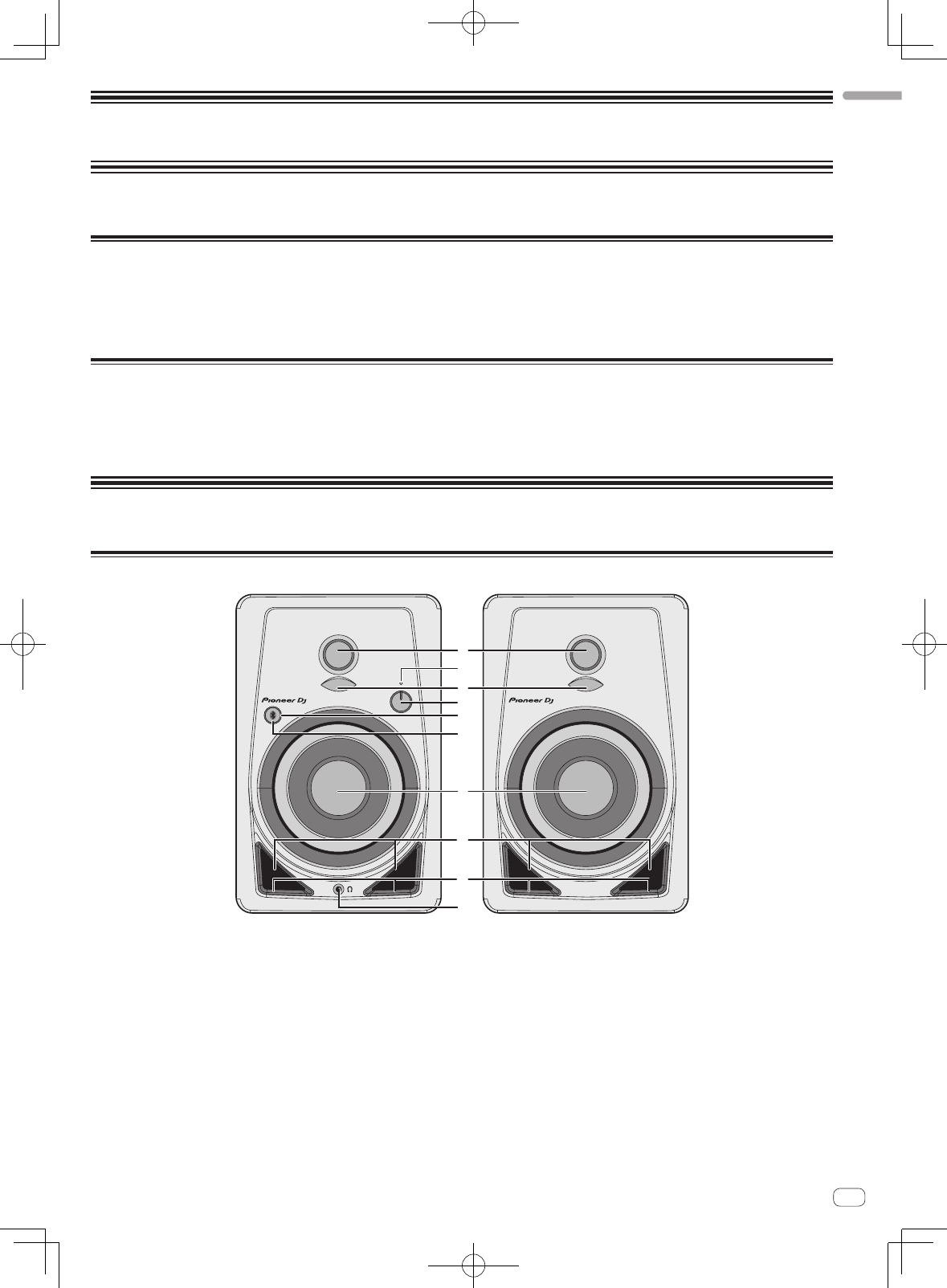
En 5
Read Before Use (Important)
Before start
Features
! A bass reflex duct at the front and the Groove technology produce a powerful kick sound.
! A convex diffuser on a new shape waveguide improves the sound directivity of high frequencies and provides spacious sound.
! Rich bass sound and clearer sound quality achieved despite its compact desktop size.
! Compatible with AAC and Qualcomm® aptX™ for higher quality sound playback over Bluetooth.
! A pairing button on the front panel enables pairing with one touch.
Checking the accessories
! Power cord x1
! Operating instructions (this document)
! Audio converter cable (3.5 mm stereo mini plug to RCA) x1
! Speaker cord x1
! Bottom cushion x8
Names and functions of parts
Front panel
1
2
3
4
7
8
9
a
5
6
1 3/4 inch soft dome tweeters
2 POWER indicator
Lighting is linked to turning on/off the power. The indicator is off in
standby.
3 Diffusers
Improve the sound directivity of high frequencies and provide spa-
cious sound.
4 LEVEL control
Adjusts the volume.
5 Pairing button
Performs pairing with a Bluetooth device.
The button also performs the pause and play operations during
music playback via Bluetooth.
For details, refer to “Listening to the Music of a Bluetooth Device”
(page 8).
6 Pairing indicator ( page 8)
When flashing: Pairing operation is performed or waiting to connect
When lit: Connected with Bluetooth device
7 4 inch glass fiber woofers
8 Bass reflex ducts
9 Grooves
Adjust the airflow of the bass reflex ducts to radiate low frequencies
smoothly.
a Headphone terminal
This is a 3.5 mm stereo mini plug type output terminal.
Connecting headphones mutes the sound output from the speakers
and outputs sound only from the headphones.
English
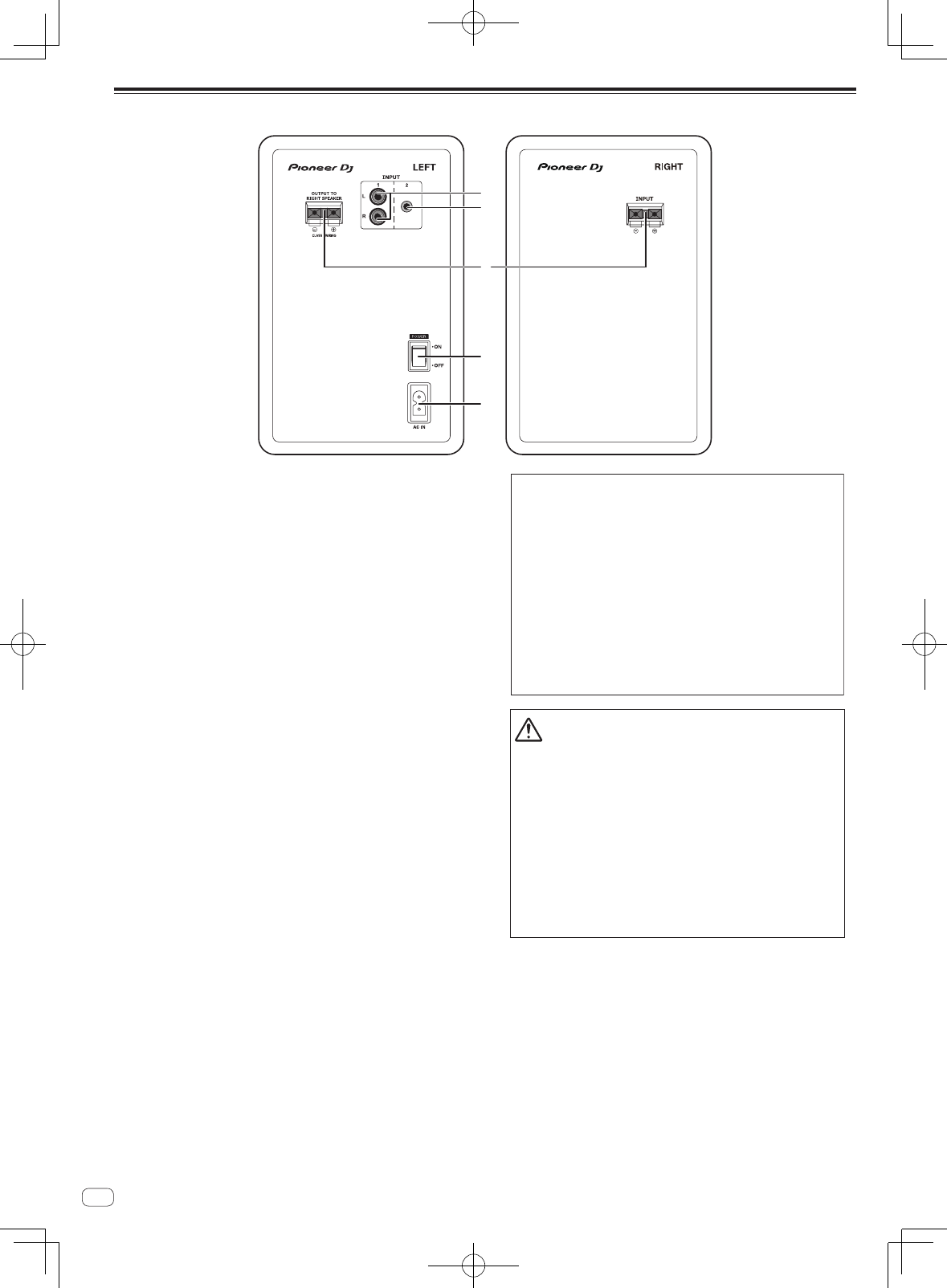
En
6
Rear panel
2
4
5
1
3
1 INPUT 1 terminals (stereo)
These are RCA pin type unbalanced input terminals.
2 INPUT 2 terminals (stereo)
This is a 3.5 mm stereo mini plug type unbalanced input terminal.
3 Speaker connection connectors
Connect the left and right speakers using the included cord.
Do not connect these speakers to an amplifier other than that of this
system. Doing so may cause a damage or fire.
4 POWER switch
Turns this unit’s power on and off.
5 AC IN
Connect the power cord to AC IN and then to the power outlet.
Connect the power cord after all the connections between devices
have been completed.
Be sure to use the included power cord.
CAUTION
The POWER switch on this unit will not completely
shut off all power from the AC outlet. Since the power
cord serves as the main disconnect device for the
unit, you will need to unplug it from the AC outlet to
shut down all power. Therefore, make sure the unit
has been installed so that the power cord can be
easily unplugged from the AC outlet in case of an
accident. To avoid fire hazard, the power cord should
also be unplugged from the AC outlet when left
unused for a long period of time (for example, when
on vacation).
D3-4-2-2-2a*_A1_En
CAUTION
!This product is provided with an auto standby function. If a
state of no sound continues for a set time (approximately 30
minutes) during use, the product automatically turns off the
POWER indicator and enters a standby state with low power
consumption regardless of whether there is a Bluetooth
connection.
!If the product enters the standby state when there is
a Bluetooth connection, the Bluetooth connection is
disconnected and the Bluetooth indicator also turns off.
!When an audio signal is input from the input terminals in the
standby state, the product automatically enters the power-on
state. Furthermore, the product also enters the power-on state
if the Bluetooth pairing button is pressed while in standby.
!This auto standby function cannot be disabled.
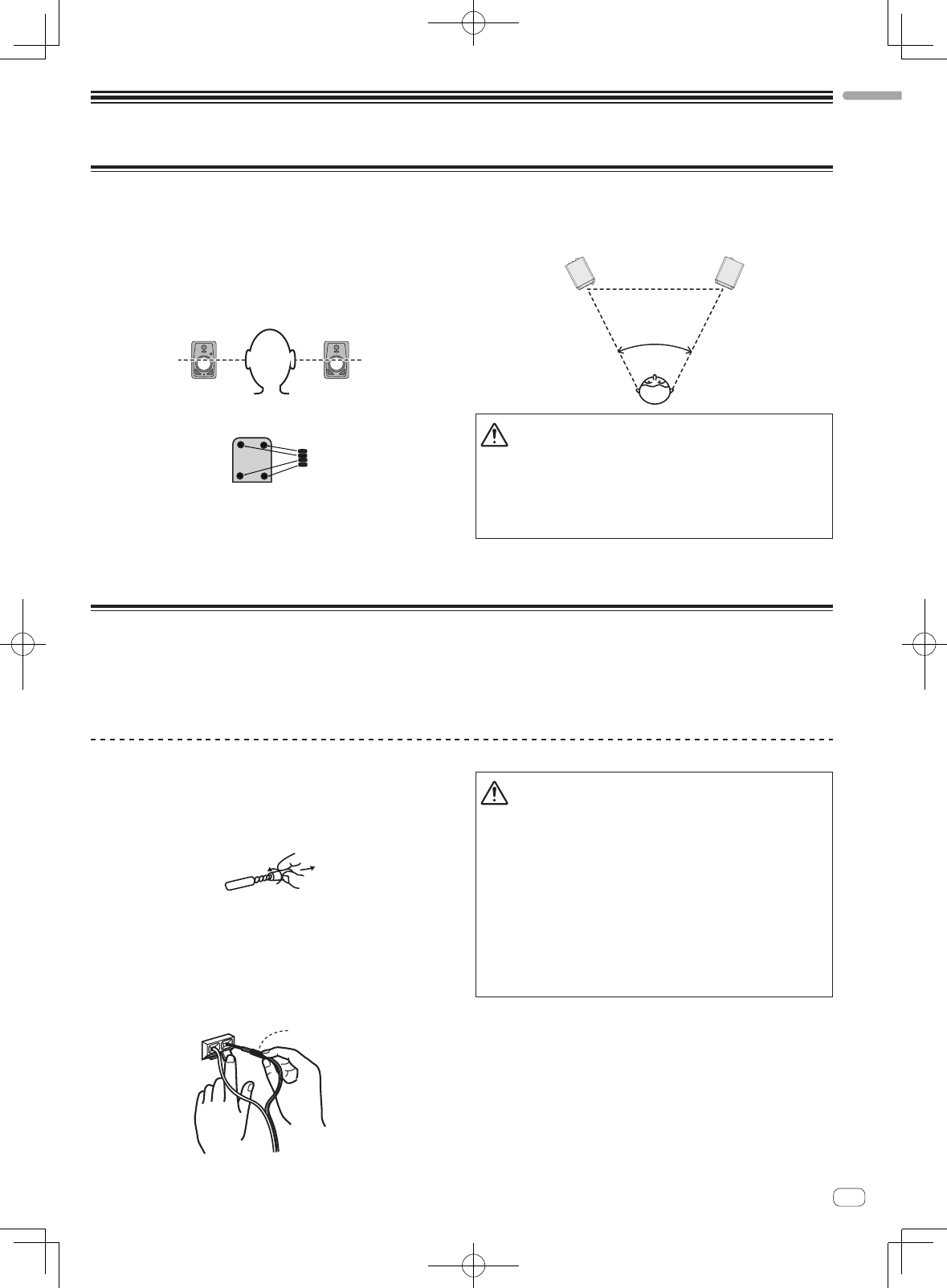
En 7
Installation and Connections
Installation Procedure
A speaker’s playback sound is delicately influenced by conditions in
the listening room. To produce optimum listening conditions, take due
consideration of the conditions of your installation location before begin-
ning actual installation.
! Place the speakers at ear level.
! For a natural stereo effect, the right and left speakers should be
installed in symmetrical and equidistant positions from the listening
position.
! Affix the supplied cushions to the bottom of the unit to prevent
slipping.
WARNING
Store small parts out of the reach of children and
infants. If accidentally swallowed, contact a doctor
immediatel
y.
D41-6-4_A1_En
! Install the speakers facing inward with a total angle of 60 degrees
from the listening position, 30 degrees for each of the left and right
speakers.
50 ° to 60 °
CAUTION
To promote proper cooling, please assure that sufficient spaceis pre-
served between the speakers and nearby walls or othercomponents
(minimum 15 cm or more above, behind, and toright and left sides of
each speaker). Leaving insufficient spacebetween the speaker and
walls or other components may lead torising interior temperatures,
leading to malfunction or damage.
Connections
! Be sure to turn off the power and unplug the power cord from the
power outlet whenever making or changing connections.
! Refer to the operating instructions for the component to be
connected.
! Connect the power cord after all the connections between devices
have been completed.
! Be sure to use the included power cord.
! Be careful with regard to the volume because the signals input from
the [INPUT 1] terminal, [INPUT 2] terminal, and Bluetooth are mixed.
Connecting cords
Connect the included speaker cord to the speakers.
1 Strip about 1 cm of the head of the included speaker
cord and twist and remove the exposed insulator.
After removing the insulator, thoroughly twist the core wires.
2 Connect the included speaker cord to the speaker
terminals on the LEFT and RIGHT sides.
3 Insert the core wires into the terminals while pressing
the claw on the speaker terminal.
Connect the speaker cord with the red line into the + terminal side (red)
and the speaker cord without the red line into the – terminal side (black).
Red +
Black
−
With the red line
CAUTION
! After connecting to the terminals, lightly pull the speaker cord to
make sure that heads of the speaker cord are securely connected
to the terminals. A loose connection might cause audio output to
be interrupted or noise to be output.
! When connecting the speaker cord, thoroughly twist the core
wires, and make sure that the core wires are not protruding out of
the speaker terminals. Core wires protruding out of the speaker
terminals may come into contact with the rear panel or with each
other. This may cause an excessive load to be placed on the ampli-
fier which results in operation stopping or a malfunction.
! If a mistake is made with the polarities (+, –) on the LEFT and
RIGHT sides when connecting the LEFT and RIGHT speaker cord,
normal stereo effect can no longer be obtained.
English
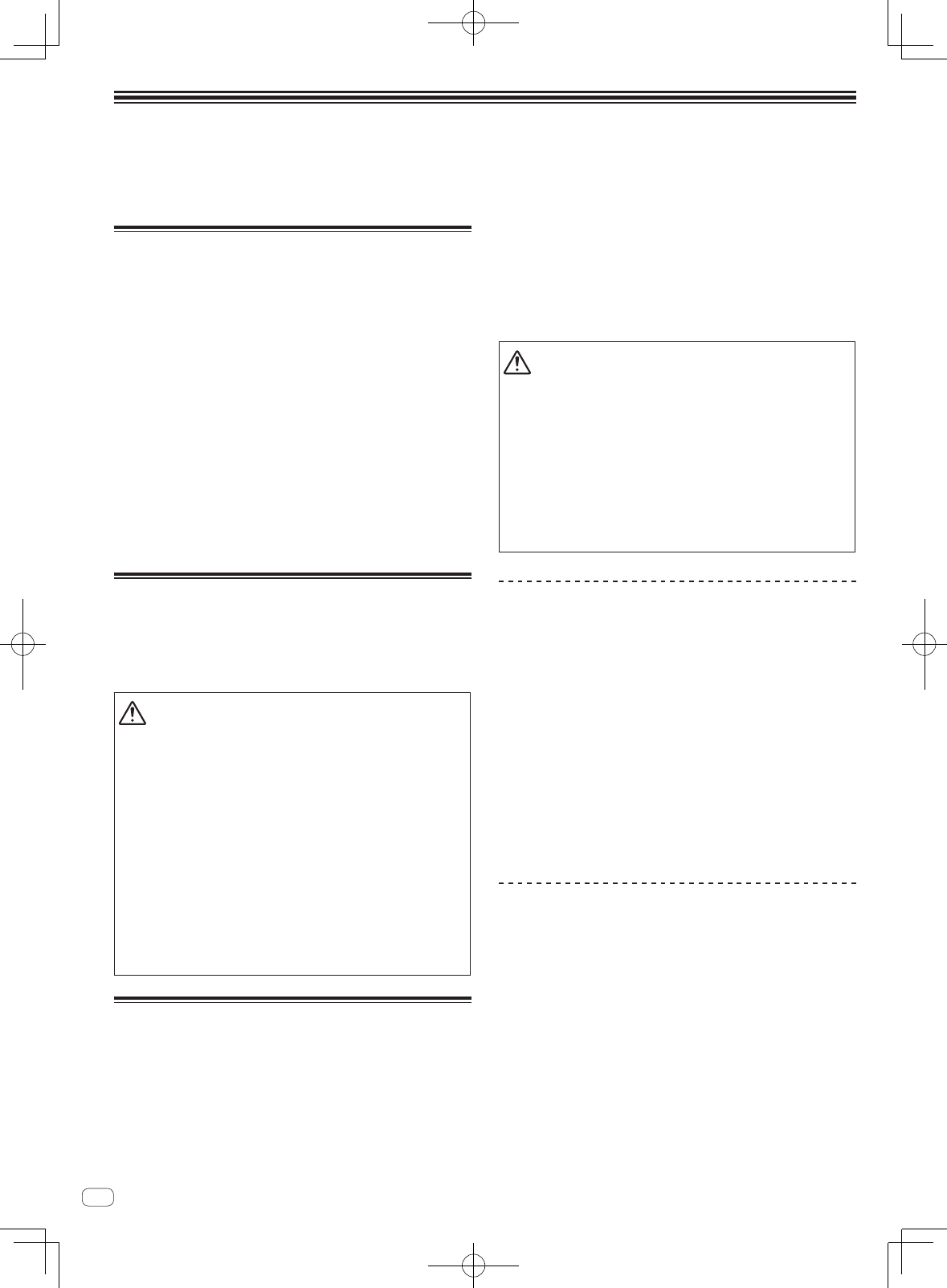
En
8
Listening to the Music of a Bluetooth Device
These speakers allow you to wirelessly enjoy tracks saved to a Bluetooth device.
When using the speakers for the first time or when connecting a new Bluetooth device to the speakers, you need to pair the speakers and Bluetooth
device.
Pairing (device mutual registration) is the operation required to connect a Bluetooth device and the speakers.
! Microwave-based health aids
! Some baby monitors
Other, less common, equipment that may operate on the same
frequency:
! Anti-theft systems
! Amateur radio stations (HAM)
! Warehouse logistic management systems
! Discrimination systems for train or emergency vehicles
CAUTION
! In the event noise appears in your television image, there is the
possibility that a Bluetooth device or this unit (including products
supported by this unit) are causing signal interference with the
antenna input connector of your television, video, satellite tuner,
etc. In this event, increase the distance between the antenna input
connector and the Bluetooth device or this unit (including prod-
ucts supported by this unit).
! If there is something obstructing the path between this unit
(including devices supported by this unit) and the device equipped
with Bluetooth wireless technology (such as a metal door, concrete
wall, or insulation containing tinfoil), you may need to change the
location of your system to prevent signal noise and interruptions.
Scope of operation
Use of this unit is limited to home use. (Transmission distances may be
reduced depending on communication environment).
In the following locations, poor condition or inability to receive radio
waves may cause the audio to be interrupted or stopped:
! In reinforced concrete buildings or steelframed or ironframed
buildings.
! Near large metallic furniture.
! In a crowd of people or near a building or obstacle.
! In a location exposed to the magnetic field, static electricity or radio
wave interference from radio communication equipment using the
same frequency band (2.4 GHz) as this unit, such as a 2.4 GHz wire-
less LAN device or microwave oven.
! If you live in a heavily populated residential area (apartment, town-
house, etc.) and if your neighbor’s microwave is placed near your
system, you may experience radio wave interference. If this occurs,
move your unit to a different place. When the microwave is not in
use, there will be no radio wave interference.
Radio wave reflections
The radio waves received by this unit include the radio wave coming
directly from the device equipped with Bluetooth wireless technology
(direct wave) and waves coming from various directions due to reflec-
tions by walls, furniture and building (reflected waves). The reflected
waves (due to obstacles and reflecting objects) further produce a variety
of reflected waves as well as variation in reception condition depending
on locations. If the audio cannot be received properly due to this phe-
nomenon, try moving the location of the device equipped with Bluetooth
wireless technology a little. Also note that audio may be interrupted
due to the reflected waves when a person crosses or approaches the
space between this unit and the device equipped with Bluetooth wireless
technology.
Pairing and Connection Procedure
1 Turn on the [POWER] switch to power on the
speakers.
! The Bluetooth indicator flashes for approximately 30 seconds and the
speakers enter the pairing state.
! If the Bluetooth indicator is off, press the pairing button for at least 2
seconds to switch to the pairing state again.
2 Perform the pairing operation on the Bluetooth
device.
Perform the operation while the speakers are in the pairing state. For
details, see the operating instructions of your Bluetooth device.
3 When the Bluetooth indicator changes from the
flashing to lit state, pairing (connecting) is complete.
If pairing could not be performed within 30 seconds, the Bluetooth indi-
cator changes from the flashing to off state.
! A Bluetooth device that has already been paired can be connected by
performing the connection operation on the Bluetooth device side if
the speakers are powered on.
Playback
When you play music on a connected Bluetooth device, the music play-
ing on the Bluetooth device is output from the speakers.
! Pressing the pairing button during music playback on the Bluetooth
device allows you to perform the pause/play operation (same func-
tion as the pause/play button of the Bluetooth device).
CAUTION
! When pairing (connecting), move the Bluetooth device close to the
speakers.
! Loud sound may be output when the playback operation is per-
formed for the first time after connecting completes so we recom-
mend lowering the volume before playback.
! The pause/play operation may not be possible with the pairing but-
ton depending on the application used.
! Connecting with the speakers may not be possible depending on
the Bluetooth device.
! If you wish to pair the speakers with a different Bluetooth device,
turn off the Bluetooth function of the currently connected
Bluetooth device or disconnect the connection before performing
the pairing operation.
! The speakers store the pairing information of up to eight Bluetooth
devices, and attempt to connect to the last paired device if the pair-
ing button is pressed in the state of no connection with a Bluetooth
device.
Radio wave caution
Radio wave caution
This unit uses a 2.4 GHz radio wave frequency, which is a band used by
other wireless systems (see list below). To prevent noise or interrupted
communication, do not use this unit nearby such devices, or make sure
these devices are switched off during use.
! Cordless phones
! Cordless facsimiles
! Microwave ovens
! Wireless LAN devices (IEEE802.11b/g)
! Wireless AV equipment
! Wireless controllers for game systems

En 9
Additional information
Troubleshooting
! Sometimes the problem may lie in another component. Inspect the other components and electrical appliances being used. If the problem cannot
be rectified, ask your nearest Pioneer authorized service center or your dealer to carry out repair work.
! This unit may not operate properly due to static electricity or other external factors. In this case, normal operation may be restored by unplugging
the power cord, waiting about 5 seconds or more, then plugging the power cord back in.
Common
Problem Check Remedy
The power is not turned on. Is the power cord properly connected? Plug in the power cord to an AC outlet.
No sound is output from the connected
device or the sound is low.
Is the connected device set properly? Set the device external input and volume properly.
Is the volume set to the proper position? Turn the [LEVEL] control on the front panel of this unit clockwise to increase
the volume.
Is the power turned on? Turn on the [POWER] switch on the rear panel of this unit.
The POWER indicator (white) does not
light.
Is the power turned on? Turn on the [POWER] switch on the rear panel of this unit.
Are the speakers in the standby state?
Turn off the [POWER] switch on the rear panel of this unit once and then turn
it back on after a few seconds. Or press the pairing button on the front panel
of this unit.
This unit does not recover (power-on)
from the standby state. Is the input signal level low? Increase the input signal level.
Distorted sound.
Is the volume set to the proper position? Turn the [LEVEL] control on the front panel of this unit counterclockwise to
reduce the volume.
Is the level for input from the connected device
appropriate? Adjust the output level of the connected device properly.
Oscillates (loud sound is output
continuously). Is the volume set to the proper position? Turn the [LEVEL] control on the front panel of this unit counterclockwise to
reduce the volume.
Sound is only output from the left
speaker. Is the speaker cord connected properly? Connect the left and right speakers properly.
The power turns off (standby state)
automatically.
Did a state of no sound continue for a set time
(approximately 30 minutes) or longer?
Input a signal from the RCA or stereo mini plug input terminal.
Or press the pairing button on the front panel of this unit.
Is the input signal level low? Increase the input signal level.
When connected to INPUT 1 or INPUT 2 terminals
Problem Check Remedy
No sound is output from the connected
device or the sound is low.
Are the connection cables properly connected? Connect the connection cables properly.
Are the terminals and plugs dirty? Clean the terminals and plugs before making connections.
Sound is only output from one speaker. Is the device connected properly? Connect the device to both the left and right input terminals.
Sound is interrupted or noise can be
heard. Is there a contact problem with the connection cables? Reconnect the connection cables.
When connected via Bluetooth
Problem Check Remedy
Cannot connect or sound is interrupted
or noise can be heard.
Is there a device producing electromagnetic waves
in the 2.4 GHz band (microwave oven, wireless
LAN device, other Bluetooth device, etc.) nearby?
Either install the unit away from this device or stop using the other device
producing electromagnetic waves.
Is the distance from the Bluetooth device too far?
Or is there a wall or obstacle blocking the signal in
the space between?
Move this unit and the connected Bluetooth device close to each other. Or
change the position of the Bluetooth device or this unit.
Is an application other than a music playback
application running on the Bluetooth device?
Exit any application on the Bluetooth device other than the music playback
application.
Does the Bluetooth device you wish to connect
support A2DP? Use a Bluetooth device that supports A2DP.
Has pairing with the Bluetooth device been per-
formed properly?
Turn the power of this unit and Bluetooth device off and back on, and then
perform pairing again.
English
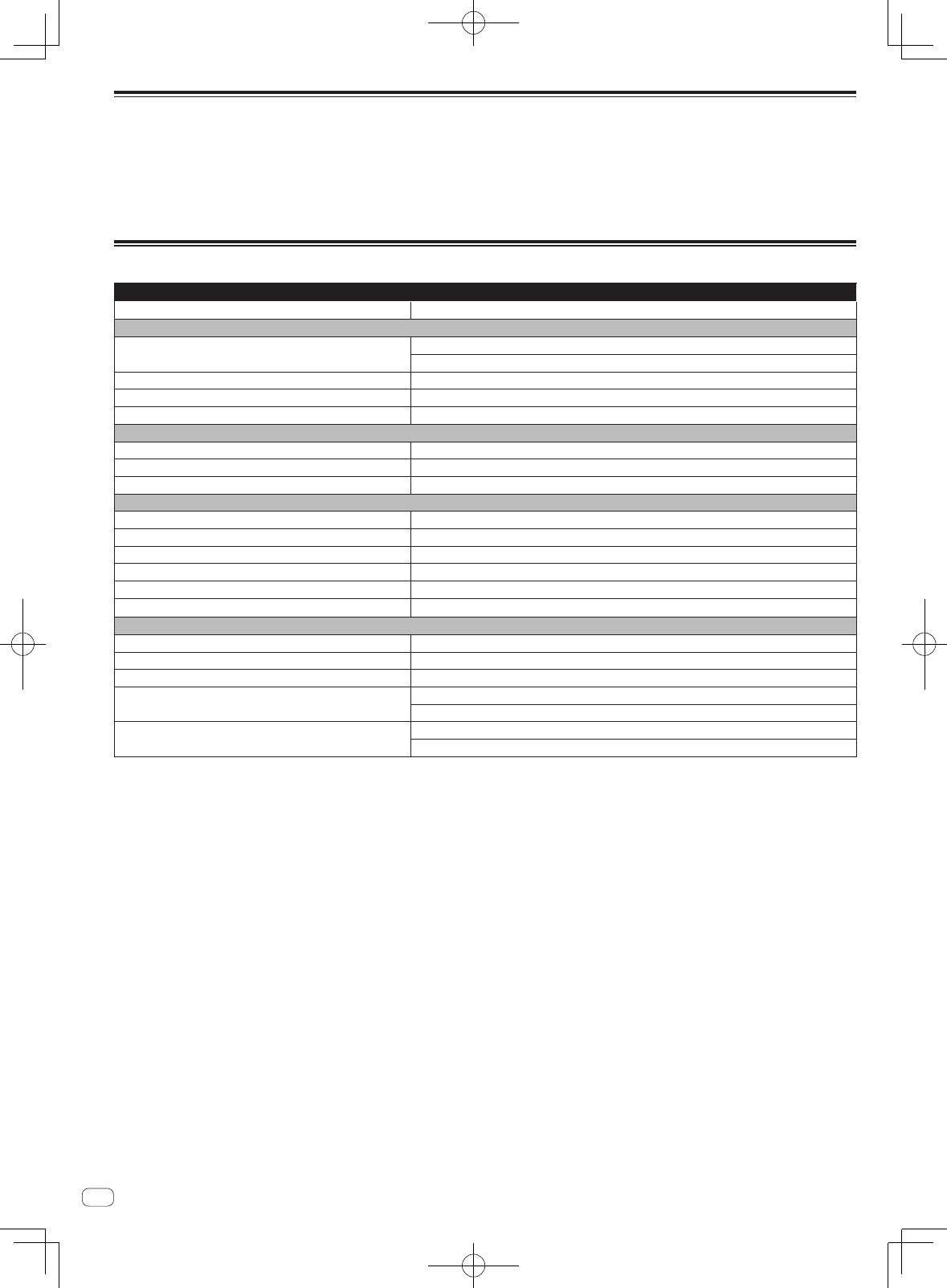
En
10
About trademarks and registered trademarks
! "Pioneer DJ" is a trademark of PIONEER CORPORATION, and is used under license.
! The names of companies and products mentioned herein are trademarks or registered trademarks of their respective owners.
! The Bluetooth® word mark and logos are registered trademarks owned by Bluetooth SIG, Inc. and any use of such marks by PIONEER DJ
Corporation is under license. Other trademarks and trade names are those of their respective owners.
! Qualcomm aptX is a product of Qualcomm Technologies International, Ltd. Qualcomm is a trademark of Qualcomm Incorporated, registered in
the United States and other countries, used with permission. aptX is a trademark of Qualcomm Technologies International, Ltd., registered in the
United States and other countries, used with permission.
Specifications
DM-40BT/DM-40BT-W
Model 2-Way Active Speaker
Amplifier section
Amplifier output Lch: 21 W/4 W, Class AB
Rch: 21 W/4 W, Class AB
Input terminals RCA × 1, 3.5 mm stereo mini plug × 1
Input impedance 10 kW
Output terminals Headphone × 1
Speaker section
Enclosure Bass reflex type/vinyl-laminated MDF
Woofer (LF driver) 4 inch (102 mm) cone
Tweeter (HF driver) 3/4 inch (19 mm) soft dome
Bluetooth section
Version Bluetooth Specification Ver. 4.2
Output Bluetooth Specification Class 2
Frequency used 2.4 GHz
Modulation FH-SS (Frequency Hopping Spread Spectrum)
Supported Bluetooth profiles A2DP, AVRCP
Supported Codec SBC, AAC, Qualcomm® aptX™, Qualcomm® aptX™ Low Latency
Power supply section / other
Supported voltages AC 110 V to 240 V, 50 Hz/60 Hz
Power consumption 35 W
Power consumption when waiting (standby status) 0.3 W
External dimensions W × H × D Lch: 146 mm × 227 mm × 223 mm
Rch: 146 mm × 227 mm × 210 mm
Weight Lch: 2.7 kg
Rch: 2.2 kg
! The specifications and design of this product are subject to change without notice.
! © 2017 Pioneer DJ Corporation. All rights reserved.
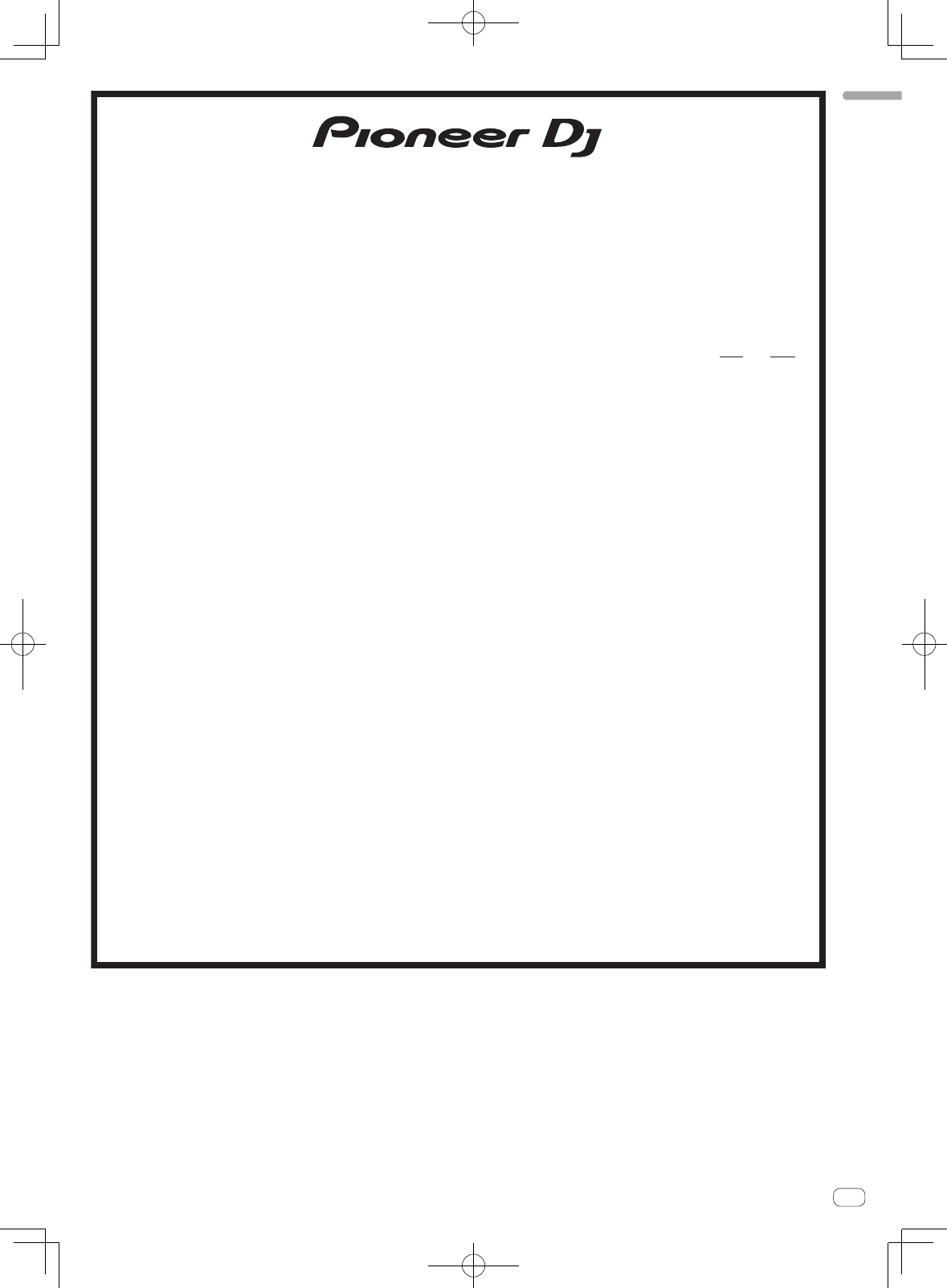
En
English
UCP0516
Pioneer DJ Americas, Inc.
LIMITED WARRANTY
WARRANTY VALID ONLY IN THE U.S.A. AND CANADA
WARRANTY
Pioneer DJ Americas, Inc. (PDJA) warrants that products distributed by PDJA in the U.S.A. and Canada that fail to function properly under normal use due to a manufacturing
defect when installed and operated according to the owner’s manual enclosed with the unit will be repaired or replaced with a unit of comparable value, at the option of PDJA,
without charge to you for parts or actual repair work. Parts supplied under this warranty may be new or rebuilt at the option of PDJA.
THIS LIMITED WARRANTY APPLIES TO THE ORIGINAL OR ANY SUBSEQUENT OWNER OF THIS PIONEER DJ PRODUCT DURING THE WARRANTY PERIOD PROVIDED THE
PRODUCT WAS PURCHASED FROM AN AUTHORIZED PIONEER DJ DISTRIBUTOR/DEALER IN THE U.S.A. OR CANADA. YOU WILL BE REQUIRED TO PROVIDE A SALES
RECEIPT OR OTHER VALID PROOF OF PURCHASE SHOWING THE DATE OF ORIGINAL PURCHASE OR, IF RENTED, YOUR RENTAL CONTRACT SHOWING THE PLACE AND
DATE OF FIRST RENTAL. IN THE EVENT SERVICE IS REQUIRED, THE PRODUCT MUST BE DELIVERED WITHIN THE WARRANTY PERIOD, TRANSPORTATION PREPAID,
ONLY FROM WITHIN THE U.S.A. AS EXPLAINED IN THIS DOCUMENT. YOU WILL BE RESPONSIBLE FOR REMOVAL AND INSTALLATION OF THE PRODUCT. PDJA WILL PAY
TO RETURN THE REPAIRED OR REPLACEMENT PRODUCT TO YOU WITHIN THE U.S.A.
PRODUCT WARRANTY PERIOD Parts Labor
Audio and Video .............................................................................................................................................................................................. 1 Year 1 Year
The warranty period for retail customers who rent the product commences upon the date product is first put into use (a) during the rental period or (b) retail sale, whichever occurs first.
WHAT IS NOT COVERED
IF THIS PRODUCT WAS PURCHASED FROM AN UNAUTHORIZED DISTRIBUTOR, THERE ARE NO WARRANTIES, EXPRESS OR IMPLIED, INCLUDING THE IMPLIED WARRANTY
OF MERCHANTABILITY AND THE IMPLIED WARRANTY OF FITNESS FOR A PARTICULAR PURPOSE AND THIS PRODUCT IS SOLD STRICTLY “AS IS” AND “WITH ALL FAULTS".
PIONEER DJ SHALL NOT BE LIABLE FOR ANY CONSEQUENTIAL AND/OR INCIDENTAL DAMAGES.
THIS WARRANTY DOES NOT APPLY IF THE PRODUCT HAS BEEN SUBJECTED TO POWER IN EXCESS OF ITS PUBLISHED POWER RATING.
THIS WARRANTY DOES NOT COVER THE CABINET OR ANY APPEARANCE ITEM, USER ATTACHED ANTENNA, ANY DAMAGE TO RECORDS OR RECORDING TAPES OR DISCS, ANY
DAMAGE TO THE PRODUCT RESULTING FROM ALTERATIONS, MODIFICATIONS NOT AUTHORIZED IN WRITING BY PIONEER DJ, ACCIDENT, MISUSE OR ABUSE, DAMAGE DUE TO
LIGHTNING OR TO POWER SURGES, SUBSEQUENT DAMAGE FROM LEAKING, DAMAGE FROM INOPERATIVE BATTERIES, OR THE USE OF BATTERIES NOT CONFORMING TO THOSE
SPECIFIED IN THE OWNER’S MANUAL.
THIS WARRANTY DOES NOT COVER THE COST OF PARTS OR LABOR WHICH WOULD BE OTHERWISE PROVIDED WITHOUT CHARGE UNDER THIS WARRANTY OBTAINED FROM
ANY SOURCE OTHER THAN A PIONEER DJ AUTHORIZED SERVICE COMPANY OR OTHER DESIGNATED LOCATION. THIS WARRANTY DOES NOT COVER DEFECTS OR DAMAGE CAUSED
BY THE USE OF UNAUTHORIZED PARTS OR LABOR OR FROM IMPROPER MAINTENANCE.
ALTERED, DEFACED, OR REMOVED SERIAL NUMBERS VOID THIS ENTIRE WARRANTY
NO OTHER WARRANTIES
PIONEER DJ LIMITS ITS OBLIGATIONS UNDER ANY IMPLIED WARRANTIES INCLUDING, BUT NOT LIMITED TO, THE IMPLIED WARRANTIES OF MERCHANTABILITY AND
FITNESS FOR A PARTICULAR PURPOSE, TO A PERIOD NOT TO EXCEED THE WARRANTY PERIOD. NO WARRANTIES SHALL APPLY AFTER THE WARRANTY PERIOD.
SOME STATES DO NOT ALLOW LIMITATIONS ON HOW LONG AN IMPLIED WARRANTY LASTS AND SOME STATES DO NOT ALLOW THE EXCLUSIONS OR LIMITATIONS
OF INCIDENTAL OR CONSEQUENTIAL DAMAGES, SO THE ABOVE LIMITATIONS OR EXCLUSIONS MAY NOT APPLY TO YOU. THIS WARRANTY GIVES YOU SPECIFIC LEGAL
RIGHTS AND YOU MAY HAVE OTHER RIGHTS WHICH MAY VARY FROM STATE TO STATE.
TO OBTAIN SERVICE
PDJA has appointed a number of Authorized Service Companies throughout the U.S.A. and Canada should your product require service. To receive warranty service you
need to present your sales receipt or, if rented, your rental contract showing place and date of original owner’s transaction. If shipping the unit you will need to package it
carefully and send it, transportation prepaid by a traceable, insured method, to an Authorized Service Company. Package the product using adequate padding material to
prevent damage in transit. The original container is ideal for this purpose. Include your name, address and telephone number where you can be reached during business
hours.
On all complaints and concerns in the U.S.A. and Canada call Customer Support at 1-800-872-4159.
For hook-up and operation of your unit or to locate an
Authorized Service Company, please call or write:
CUSTOMER SUPPORT
PIONEER ELECTRONICS (USA) INC.
P.O. BOX 1720
LONG BEACH, CALIFORNIA 90801
1-800-872-4159
http://www.pioneerelectronics.com
DISPUTE RESOLUTION
Following our response to any initial request to Customer Support, should a dispute arise between you and Pioneer DJ, Pioneer DJ makes available its Complaint Resolution
Program to resolve the dispute. The Complaint Resolution Program is available to you without charge. You are required to use the Complaint Resolution Program before you exercise
any rights under, or seek any remedies, created by Title I of the Magnuson-Moss Warranty-Federal Trade Commission Improvement Act, 15 U.S.C. 2301 et seq.
To use the Complaint Resolution Program call 1-800-872-4159 and explain to the customer service representative the problem you are experiencing, steps you have taken
to have the product repaired during the warranty period and the name of the authorized Distributor/Dealer from whom the Pioneer DJ product was purchased. After the
complaint has been explained to the representative, a resolution number will be issued. Within 40 days of receiving your complaint, Pioneer DJ will investigate the dispute
and will either: (1) respond to your complaint in writing informing you what action Pioneer DJ will take, and in what time period, to resolve the dispute; or (2) respond to your
complaint in writing informing you why it will not take any action.
RECORD THE PLACE AND DATE OF PURCHASE FOR FUTURE REFERENCE
Model No. ____________________________________________ Serial No. _________________________________________ Purchase Date ______________________
Purchased From ____________________________________________________________________________________________________________________________
_
KEEP THIS INFORMATION AND YOUR SALES RECEIPT IN A SAFE PLACE
11
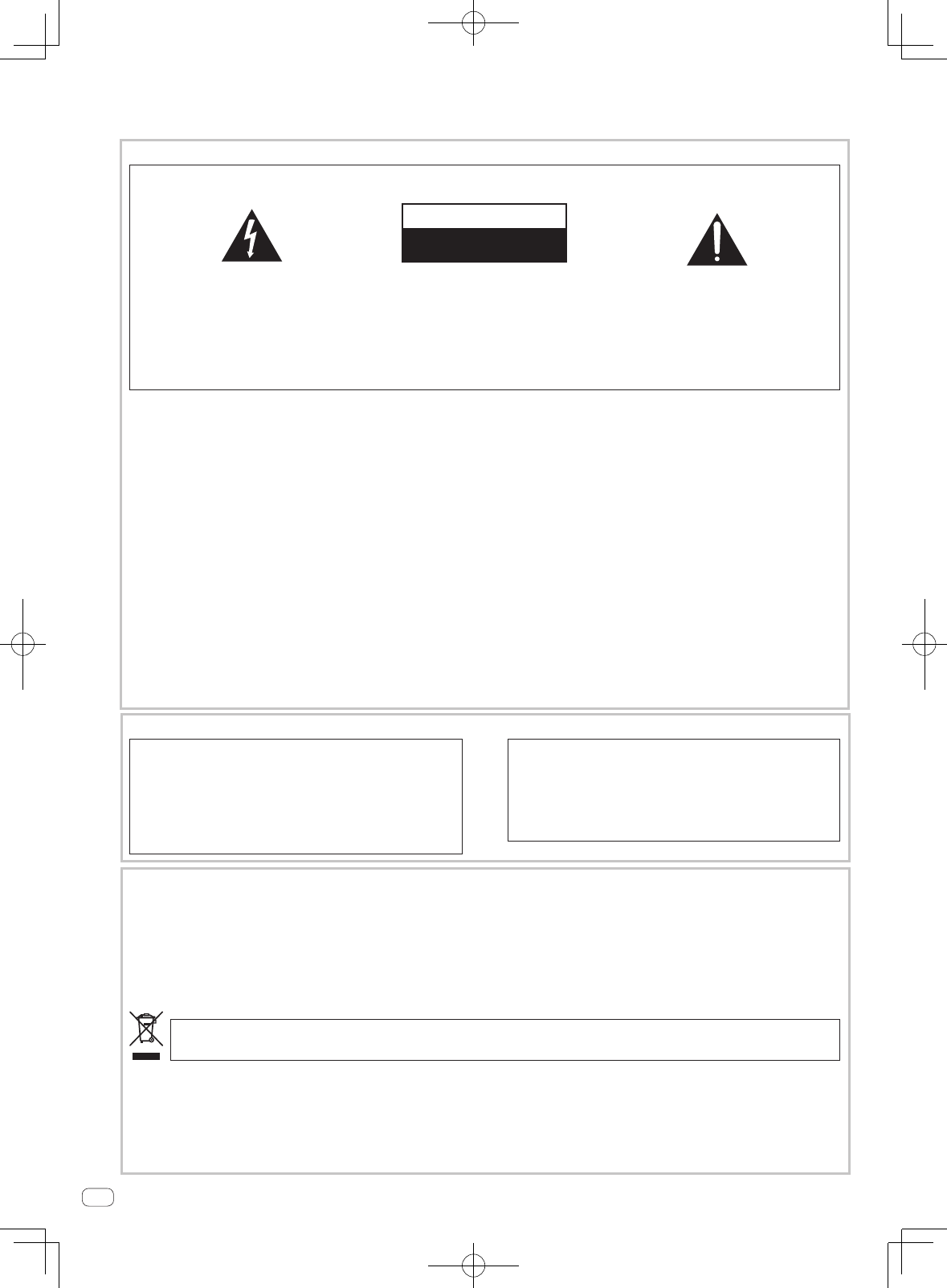
Fr
2
Nous vous remercions d’avoir acheté ce produit Pioneer DJ.
Veuillez lire attentivement ce mode d’emploi de manière à pouvoir utiliser votre modèle correctement. Après avoir lu ces
explications, conservez-les en lieu sûr pour éventuellement les consulter plus tard.
[Pour les utilisateurs en Europe]
[Pour les utilisateurs aux États-Unis et au Canada]
[Pour les utilisateurs aux États-Unis]
Ce point d’exclamation, placé dans un
triangle équilatéral, a pour but d’attirer
l’attention de l’utilisateur sur la présence,
dans les documents qui accompagnent
l’appareil, d’explications importantes du
point de vue de l’exploitation ou de
l’entretien.
Ce symbole de l’éclair, placé dans un
triangle équilatéral, a pour but d’attirer
l’attention de l’utilisateur sur la présence, à
l’intérieur du coffret de l’appareil, de
“tensions dangereuses” non isolées d’une
grandeur suffisante pour représenter un
risque d’électrocution pour les êtres
humains.
ATTENTION :
POUR ÉVITER TOUT RISQUE
D’ÉLECTROCUTION, NE PAS ENLEVER LE
COUVERCLE (NI LE PANNEAU ARRIÈRE).
AUCUNE PIÈCE RÉPARABLE PAR
L’UTILISATEUR NE SE TROUVE À
L’INTÉRIEUR. CONFIER TOUT ENTRETIEN À
UN PERSONNEL QUALIFIÉ UNIQUEMENT.
ATTENTION
DANGER D´ELECTROCUTION
NE PAS OUVRIR
IMPORTANT
D3-4-2-1-1b_A1_Fr
La protection de votre ouïe est entre vos mains
Pour assurer le rendement optimal de votre matériel
et – plus important encore – la protection de votre ouïe, réglez le volume à un niveau raisonnable. Pour ne pas altérer
votre sens de la perception, le son doit être clair mais ne produire aucun vacarme et être exempt de toute distorsion.
Votre ouïe peut vous jouer des tours. Avec le temps, votre système auditif peut en effet s’adapter à des volumes
supérieurs, et ce qui vous semble un « niveau de confort normal » pourrait au contraire être excessif et contribuer à
endommager votre ouïe de façon permanente. Le réglage de votre matériel à un volume sécuritaire AVANT que votre
ouïe s’adapte vous permettra de mieux vous protéger.
CHOISISSEZ UN VOLUME SÉCURITAIRE:
• Réglez d’abord le volume à un niveau inférieur.
• Montez progressivement le volume jusqu’à un niveau d’écoute confortable ; le son doit être clair et exempt de
distorsions.
• Une fois que le son est à un niveau confortable, ne touchez plus au bouton du volume.
N’OUBLIEZ PAS DE RESPECTER LES DIRECTIVES SUIVANTES:
• Lorsque vous montez le volume, assurez-vous de pouvoir quand même entendre ce qui se passe autour de vous.
• Faites très attention ou cessez temporairement l’utilisation dans les situations pouvant s’avérer dangereuses.
• N’utilisez pas des écouteurs ou un casque d’écoute lorsque vous opérez un véhicule motorisé ; une telle utilisation
peut créer des dangers sur la route et est illégale à de nombreux endroits. S001a_A1_Fr
Attention
Pour éviter les risques d’incendie, des fils de câblage
de Classe 2 doivent être utilisés pour le branchement
de haut-parleurs et ils doivent être acheminés à
l’écart de dangers potentiels afin d’éviter
d’endommager leur isolant. D3-7-13-67*_A1_Fr
REMARQUE IMPORTANTE
LE NUMÉRO DE MODÈLE ET LE NUMÉRO DE SÉRIE
SE TROUVENT À L’ARRIÈRE OU SUR LE FOND DE
CET APPAREIL. NOTEZ CES NUMÉROS À LA PAGE
11 POUR VOUS Y RÉFÉRER ULTÉRIEUREMENT.
D36-AP9-3*_A1_Fr
Si vous souhaitez vous débarrasser de cet appareil, ne le mettez pas à la poubelle avec vos ordures ménagères. Il existe un système de
collecte séparé pour les appareils électroniques usagés, qui doivent être récupérés, traités et recyclés conformément à la législation.
Les habitants des états membres de l’UE, de Suisse et de Norvège peuvent retourner gratuitement leurs appareils électroniques usagés aux
centres de collecte agréés ou à un détaillant (si vous rachetez un appareil similaire neuf).
Dans les pays qui ne sont pas mentionnés ci-dessus, veuillez contacter les autorités locales pour savoir comment vous pouvez vous débarrasser
de vos appareils.
Vous garantirez ainsi que les appareils dont vous vous débarrassez sont correctement récupérés, traités et recyclés et préviendrez de cette façon
les impacts néfastes possibles sur l’environnement et la santé humaine. K058b_A1_Fr
ATTENTION
POUR ÉVITER TOUT RISQUE D’ÉLECTROCUTION, NE
PAS ENLEVER LE COUVERCLE (NI LE PANNEAU
ARRIÈRE). AUCUNE PIÈCE RÉPARABLE PAR
L’UTILISATEUR NE SE TROUVE À L’INTÉRIEUR.
CONFIER TOUT ENTRETIEN À UN PERSONNEL
QUALIFIÉ UNIQUEMENT. D3-4-2-1-1_B1_Fr
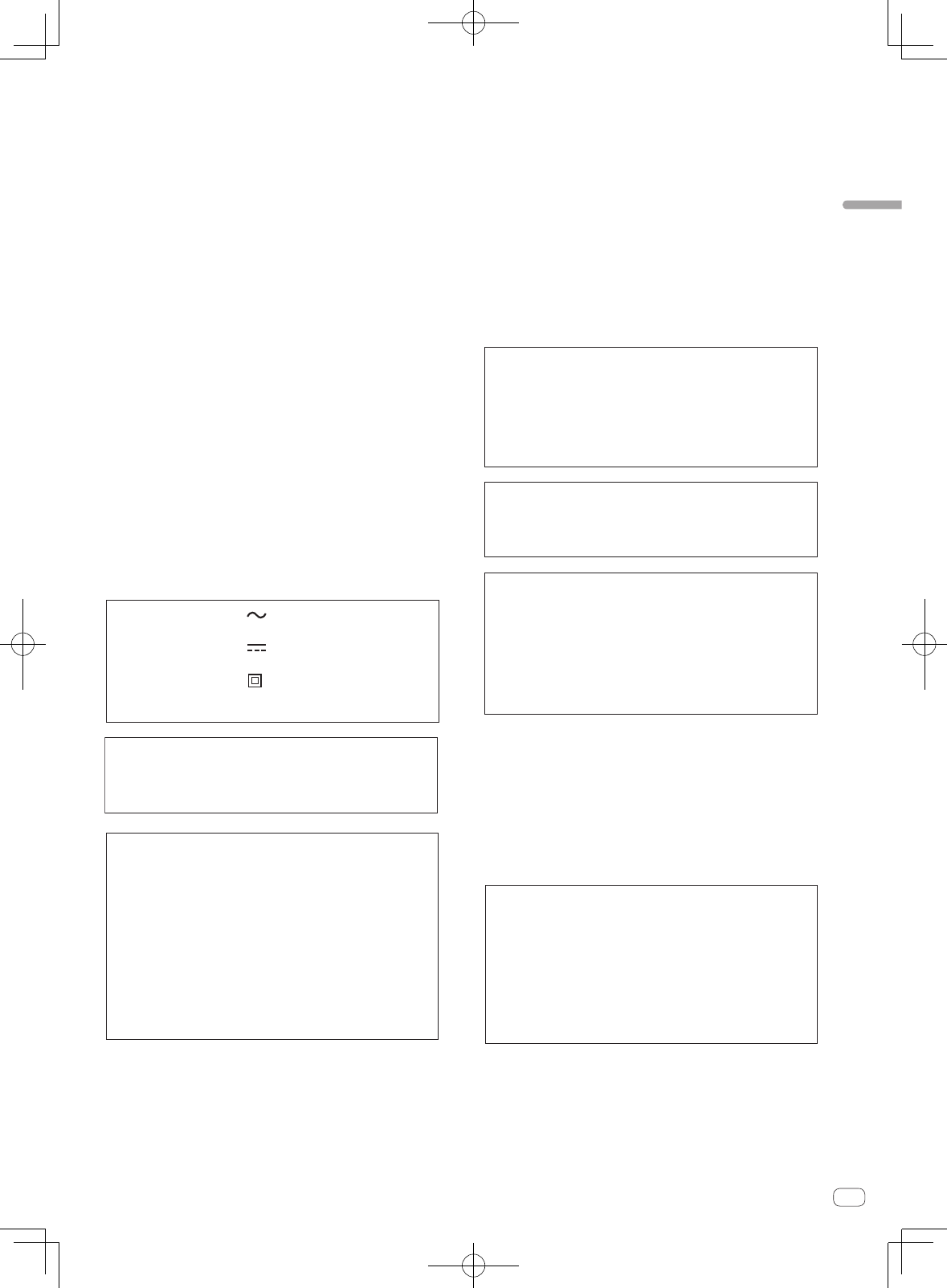
Fr 3
PRÉCAUTION DE VENTILATION
Lors de l’installation de l’appareil, veillez à laisser un
espace suffisant autour de ses parois de manière à
améliorer la dissipation de chaleur (au moins 15 cm sur
le dessus, 15 cm à l’arrière et 15 cm de chaque côté).
D3-4-2-1-7d*_A1_Fr
Milieu de fonctionnement
Te
mpérature et humidité du milieu de fonctionnement :
De +5 °C à +35 °C (de +41 °F à +95 °F) ; Humidité
relative inférieure à 85 % (orifices de ventilation non
obstrués
)
N’installez pas l’appareil dans un endroit mal ventilé ou
un lieu soumis à une forte humidité ou en plein soleil
(ou à une forte lumière artificielle).
D3-4-2-1-7c*_A1_Fr
AVER
TISSEMENT
P
our éviter les risques d’incendie, ne placez aucune
flamme nue (telle qu’une bougie allumée) sur
l’appareil.
D3-4-2-1-7a_A1_Fr
AVERTISSEMENT
Cet appareil
n’est pas étanche. Pour éviter les risques
d’incendie et de décharge électrique, ne placez près de
lui un récipient rempli d’eau, tel qu’un vase ou un pot
de fleurs, et ne l’exposez pas à des gouttes d’eau, des
éclaboussures, de la pluie ou de l’humidité.
D3-4-2-1-3_A1_Fr
Précautions concernant les enceintes
DM-40BT/DM-40BT-W
Ne reliez pas cette enceinte à un amplificateur autre
que celui fourni avec l’ensemble, faute de quoi vous
pouvez provoquer une anomalie de fonctionnement,
voire un incendie.
SGK006*_A1_Fr
N’attachez pas ces enceintes sur un mur ou au
plafond car, en tombant, elles pourraient causer des
blessures.
SGK007_A1_Fr
Ce produit est destiné à une utilisation domestique
générale. Toute panne due à une utilisation autre qu'à
des fins privées (comme une utilisation à des fins
commerciales dans un restaurant, dans un autocar
ou sur un bateau) et qui nécessite une réparation
sera aux frais du client, même pendant la période de
garantie.
K041_A1_Fr
NOTE IMPORTANTE SUR LE CABLE
D’ALIMENTATION
Tenir le câble d’alimentation par la fiche. Ne pas
débrancher la prise en tirant sur le câble et ne pas
toucher le câble avec les mains mouillées. Cela risque
de provoquer un court-circuit ou un choc électrique. Ne
pas poser l’appareil ou un meuble sur le câble. Ne pas
pincer le câble. Ne pas faire de noeud avec le câble ou
l’attacher à d’autres câbles. Les câbles d’alimentation
doivent être posés de façon à ne pas être écrasés. Un
câble abîmé peut provoquer un risque d’incendie ou un
choc électrique. Vérifier le câble d’alimentation de
temps en temps. Contacter le service après-vente le
plus proche ou le revendeur pour un remplacement.
S002*_A1_Fr
AVERTISSEMENT
Les fentes et ouvertures du coffret sont prévues pour la
ventilation, pour assurer un fonctionnement stable de
l’appareil et pour éviter sa surchauffe. Pour éviter les
risques d’incendie, ne bouchez jamais les ouvertures et
ne les recouvrez pas d’objets, tels que journaux, nappes
ou rideaux, et n’utilisez pas l’appareil posé sur un tapis
épais ou un lit.
D3-4-2-1-7b*_A1_Fr
Le symbole graphique indiqué sur le produit
représente le courant alternatif.
Le symbole graphique indiqué sur le produit
représente le courant continu.
Le symbole graphique indiqué sur le produit
représente un équipement de Classe II.
D3-8-2-4_A1_Fr
ATTENTION
Ce produit a été testé dans des conditions de climat
tempéré.
D3-8-2-1-7b_A1_Fr
Cet équipement est conforme aux limites
d’exposition aux rayonnements énoncées pour un
environnement non contrôlé et respecte les règles
d’exposition aux fréquences radioélectriques (RF)
CNR-102 de l’IC. Cet équipement émet une énergie
RF très faible qui est considérée conforme sans
évaluation de l’exposition maximale autorisée.
Cependant, cet équipement doit être installé et utilisé
en gardant une distance de 20 cm ou plus entre le
dispositif rayonnant et le corps (à l’exception des
extrémités : mains, poignets, pieds et chevilles).
D8-9-2-7-3_A1_Fr
Le présent appareil est conforme aux CNR d’Industrie
Canada applicables aux appareils radio exempts de
licence. L’exploitation est autorisée aux deux
conditions suivantes : (1) l’appareil ne doit pas
produire de brouillage, et (2) l’utilisateur de l’appareil
doit accepter tout brouillage radioélectrique subi,
même si le brouillage est susceptible d’en
compromettre le fonctionnement.
D8-9-10-1_A1_Fr
Français
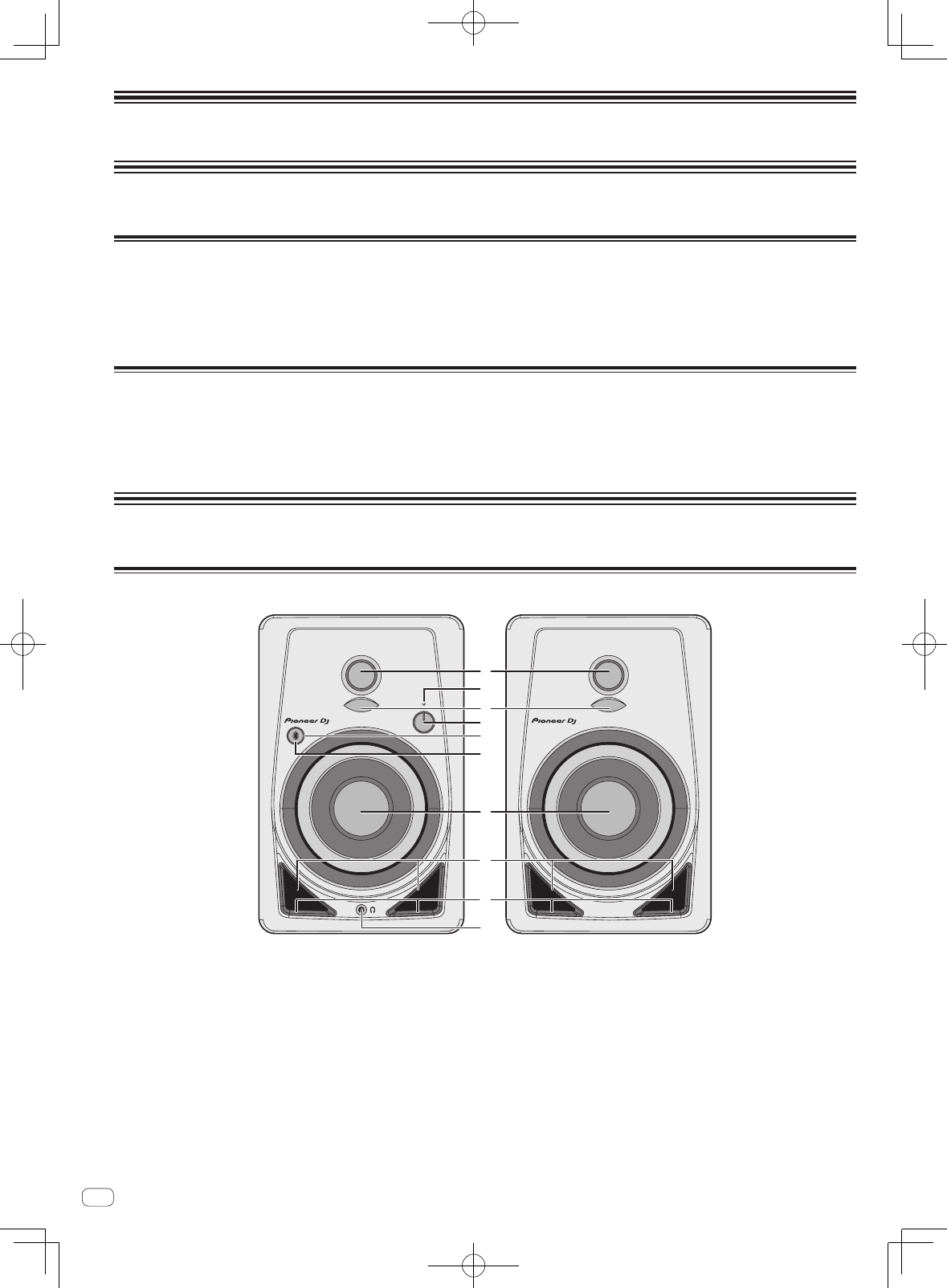
Fr
4
A lire avant l’utilisation (Important)
Informations préliminaires
Caractéristiques
! Reproduction d'un son de grosse caisse puissant grâce à un canal bass-reflex à l'avant et à la technologie Groove.
! Diffuseur convexe doté d'un guide d'ondes d'une forme nouvelle optimisant la directivité des hautes fréquences et la spatialité du son.
! Obtention d'un son riche en basses et d'une qualité sonore plus claire malgré son format de bureau compact.
! Compatible avec AAC et Qualcomm® aptX™ pour une lecture audio de qualité supérieure via Bluetooth.
! Bouton d’appairage sur la face avant permettant d’appairer d’une simple pression.
Vérification des accessoires
! Cordon d’alimentation x1
! Mode d’emploi (ce document)
! Câble de conversion audio (mini-jack stéréo de 3,5 mm vers RCA) x1
! Cordon de haut-parleur x1
! Coussinets antidérapants x8
Noms et fonctions des organes
Face avant
1
2
3
4
7
8
9
a
5
6
1 Tweeters à dôme souple de 3/4 pouces
2 Indicateur POWER
L’éclairage est lié à la mise sous/hors tension. Le voyant est éteint en veille.
3 Diffuseurs
Améliorez la directivité sonore des hautes fréquences et offrez un
son ample.
4 Commande LEVEL
Ajuste le volume.
5 Bouton d’appairage
Permet d’appairer avec un appareil Bluetooth.
Le bouton permet également de mettre en pause et de lire pendant la
lecture de musique via Bluetooth.
Pour plus de détails, reportez-vous à “Écoute de la musique d’un
appareil Bluetooth” (page 7).
6 Indicateur d’appairage (page 7)
Clignotant : Opération d’appairage en cours d’exécution ou en
attente de connexion
Allumé : Connecté à l’appareil Bluetooth
7 Caissons en fibre de verre de 4 pouces
8 Canaux basse réflex
9 Rainures
Ajustez la circulation de l’air des canaux basse réflex pour émettre
en douceur les basses fréquences.
a Prise de casque
Il s’agit d’une prise de sortie de type mini-jack stéréo de 3,5 mm.
Le raccordement d’un casque coupe le son provenant des haut-
parleurs, et le son provient uniquement du casque.
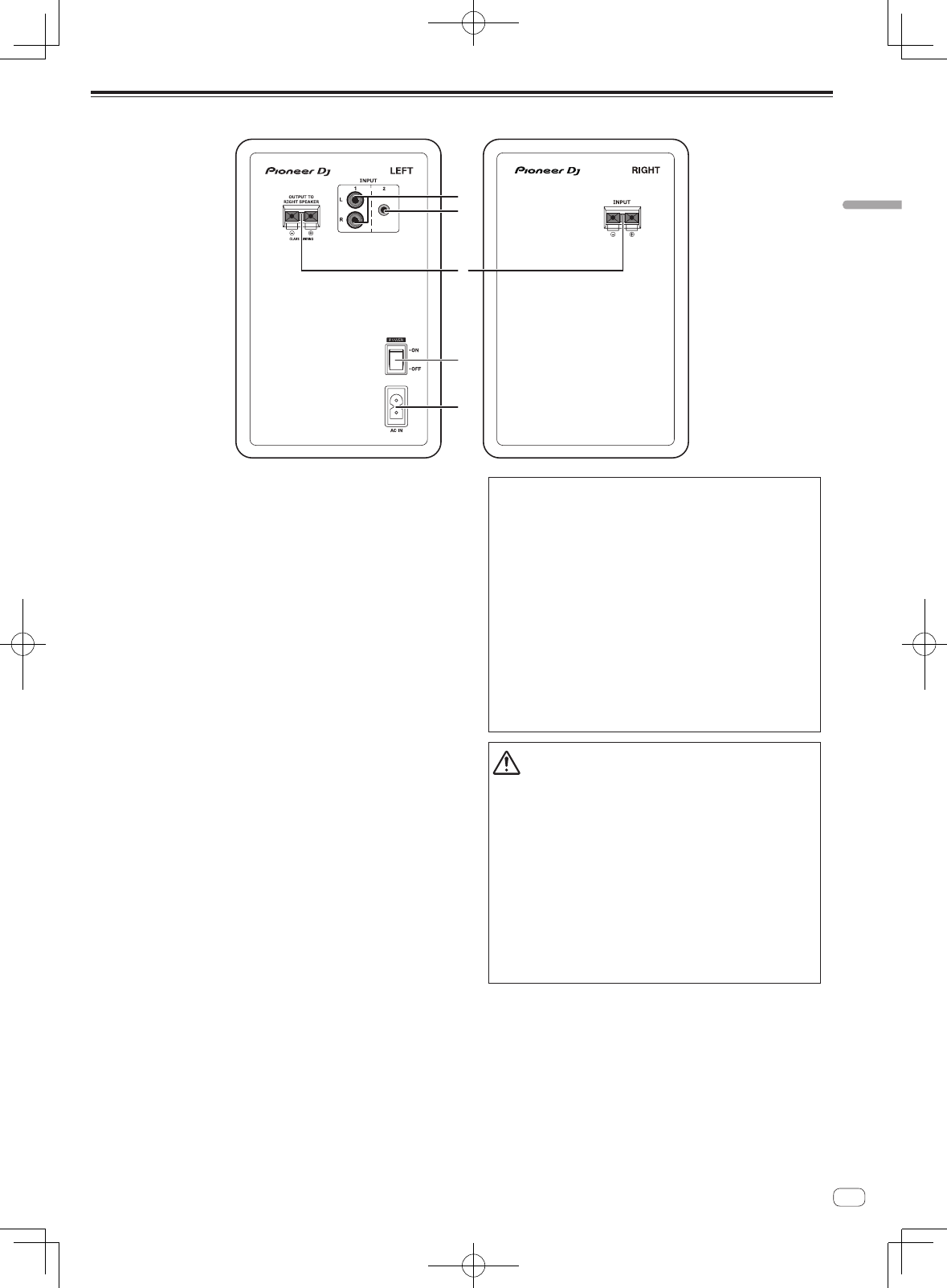
Fr 5
Panneau arrière
2
4
5
1
3
1 Prises INPUT 1 (stéréo)
Il s’agit de prises d’entrée asymétriques de type prise RCA.
2 Prises INPUT 2 (stéréo)
Il s’agit d’une prise d’entrée asymétrique de type mini-jack stéréo
de 3,5 mm.
3 Connecteurs de raccordement de haut-parleur
Raccordez les haut-parleurs gauche et droit à l’aide du cordon
fourni.
Ne raccordez pas ces haut-parleurs à un amplificateur autre que
celui de ce système. Ceci pourrait endommager le produit ou provo-
quer un incendie.
4 Commutateur POWER
Pour allumer et éteindre cet appareil.
5 AC IN
Branchez le cordon d’alimentation à AC IN et à la prise électrique.
Lorsque tous les appareils ont été raccordés, vous pouvez brancher
le cordon d’alimentation.
Veillez à utiliser le cordon d’alimentation fourni.
ATTENTION
L’interrupteur POWER de cet appareil ne coupe pas
complètement celui-ci de sa prise secteur. Comme le
cordon d’alimentation fait office de dispositif de
déconnexion du secteur, il devra être débranché au
niveau de la prise secteur pour que l’appareil soit
complètement hors tension. Par conséquent, veillez à
installer l’appareil de telle manière que son cordon
d’alimentation puisse être facilement débranché de
la prise secteur en cas d’accident. Pour éviter tout
risque d’incendie, le cordon d’alimentation sera
débranché au niveau de la prise secteur si vous
prévoyez une période prolongée de non utilisation
(par exemple avant un départ en vacances).
D3-4-2-2-2a*_A1_Fr
ATTENTION
!Ce produit inclut une fonction de veille automatique.
En cas d’absence de son pendant une durée définie
(30 minutes environ) pendant l’utilisation, le produit éteint
automatiquement l’indicateur POWER et passe à l’état de
veille et de faible consommation d’énergie qu’une connexion
Bluetooth soit établie ou non.
!Si le produit passe à l’état de veille alors qu’une connexion
Bluetooth est établie, la connexion Bluetooth est déconnectée
et l’indicateur Bluetooth s’éteint également.
!Lorsqu’un signal audio provient des prises d’entrée à l’état
de veille, le produit passe automatiquement à l’état activé. Le
produit passe également à l’état activé si vous appuyez sur le
bouton d’appairage Bluetooth alors qu’il est en veille.
!Cette fonction de veille automatique ne peut pas être
désactivée.
Français
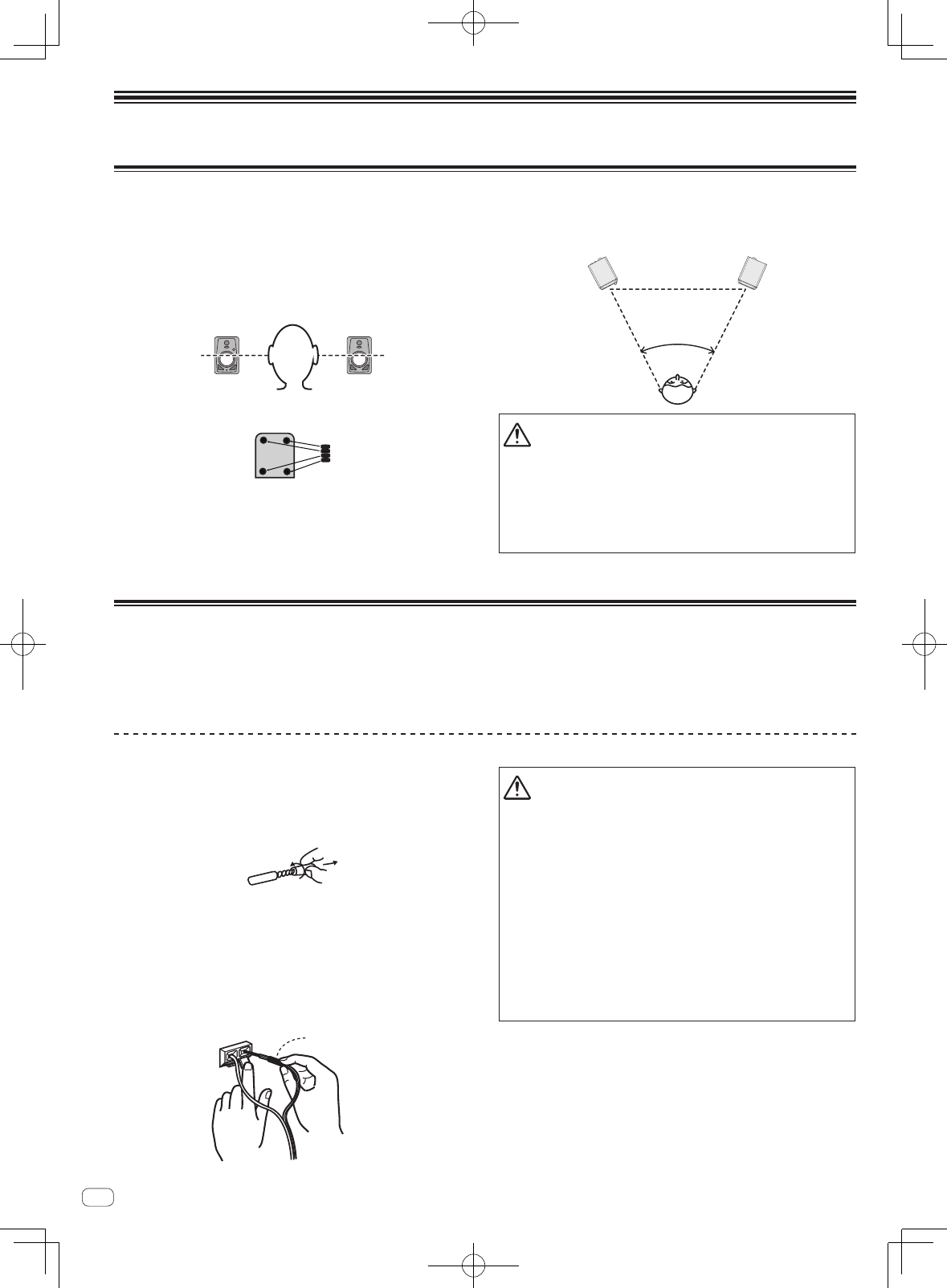
Fr
6
Installation et connexions
Installation
Les sons reproduits par les enceintes sont influencés délicatement
par les conditions du local d’écoute. Pour bénéficier d’un environne-
ment d’écoute optimal, réfléchissez bien aux conditions de l’emplace-
ment avant de commencer l’installation proprement dite.
! Installez les haut-parleurs à hauteur des oreilles.
! Pour obtenir un effet stéréo naturel, les enceintes gauche et droite
doivent être installées à des points symétriques et équidistants de la
position d’écoute.
! Fixez les coussinets fournis sur la surface inférieure de l’appareil
pour éviter tout risque de glissement.
AVERTISSEMENT
Gardez les pièces de petite taille hors de la portée des
bébés et des enfants. En cas d’ingestion accidentelle,
veuillez contacter immédiatement un médecin
.
D41-6-4_A1_Fr
! Installez les haut-parleurs orientés vers l’intérieur à un angle de
60 degrés par rapport à la position d’écoute, 30 degrés pour chacun
des haut-parleurs gauche et droit.
50 ° à 60 °
ATTENTION
Pour permettre un meilleur refroidissement, veillez à ce qu’un espace
suffisant soit laissé entre les haut-parleurs et les murs ou autres
composants à proximité (15 cm minimum au-dessus, derrière et sur
les côtés droit et gauche de chaque haut-parleur). Le fait de ne pas
laisser d’espace suffisant entre le haut-parleur et les murs ou autres
composants peut entraîner une augmentation des températures inté-
rieures, et provoquer un dysfonctionnement ou un endommagement.
Raccordements
! Veillez à toujours éteindre les appareils et à débrancher le cor-
don d’alimentation de la prise secteur avant de raccorder un appareil
ou de changer les liaisons.
! Reportez-vous au mode d’emploi de l’appareil devant être raccordé.
! Lorsque tous les appareils ont été raccordés, vous pouvez brancher
le cordon d’alimentation.
! Veillez à utiliser le cordon d’alimentation fourni.
! Faites attention au volume car les signaux provenant de la prise
[INPUT 1], de la prise [INPUT 2] et de Bluetooth sont combinés.
Cordons de raccordement
Branchez le cordon de haut-parleur fourni aux haut-parleurs.
1 Dénudez sur 1 cm environ de la tête du cordon de
haut-parleur fourni, tordez et retirez l’isolant exposé.
Une fois l’isolant retiré, tordez bien les fils centraux.
2 Branchez le cordon de haut-parleur fourni aux prises
de haut-parleurs à GAUCHE et à DROITE.
3 Introduisez les fils centraux dans les prises tout en
appuyant sur la griffe de la prise de haut-parleur.
Branchez le cordon de haut-parleur avec la ligne rouge sur le côté de la
prise + (rouge) et le cordon de haut-parleur sans la ligne rouge sur le
côté de la prise – (noire).
Rouge +
Noire
−
Avec la ligne rouge
ATTENTION
! Une fois les prises raccordées, tirez légèrement sur le cordon de
haut-parleur pour vous assurer que les têtes de cordon de haut-
parleur sont bien raccordées aux prises. Un raccordement lâche
peut entraîner une interruption de la sortie audio ou l’émission de
bruit.
! Lors du branchement du cordon de haut-parleur, tordez bien les
fils centraux, et assurez-vous que les fils centraux ne dépassent
pas des prises de haut-parleur. Les fils centraux qui dépassent
des prises de haut-parleur peuvent entrer en contact avec le
panneau arrière ou entre eux. Ceci peut entraîner une charge
excessive sur l’amplificateur, provoquant ainsi un arrêt ou un
dysfonctionnement.
! Si les polarités sont inversées (+, –) sur les côtés GAUCHE et
DROIT lors du branchement du cordon de haut-parleur GAUCHE
et DROIT, l’effet stéréo normal ne peut plus être obtenu.
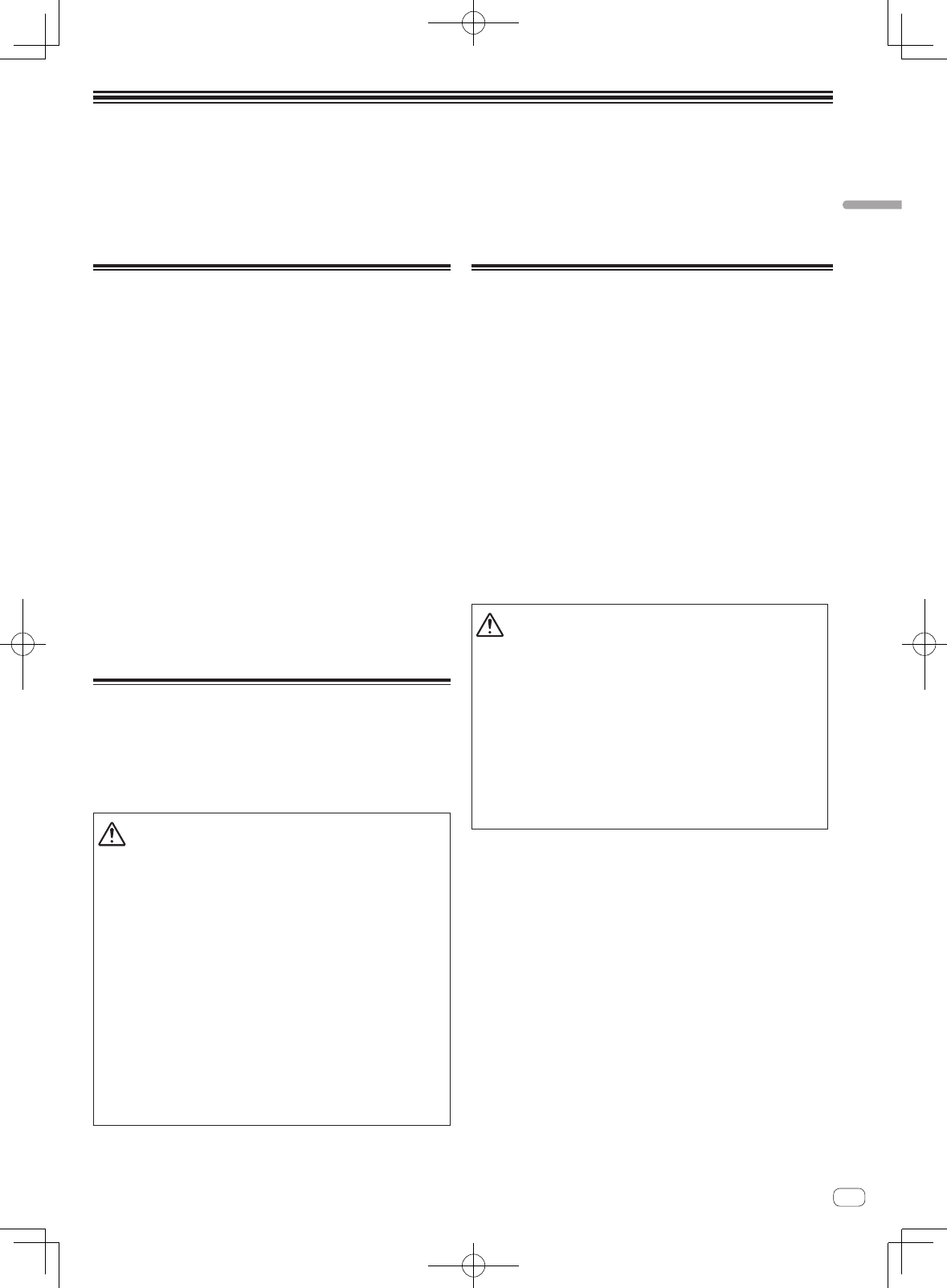
Fr 7
Écoute de la musique d’un appareil
Bluetooth
Ces haut-parleurs vous permettent d’écouter des morceaux enregistrés sur un appareil Bluetooth.
Lorsque vous utilisez les haut-parleurs pour la première fois ou lorsque vous connectez un nouvel appareil Bluetooth aux haut-parleurs, vous devez
appairer les haut-parleurs et l’appareil Bluetooth.
L’appairage (enregistrement mutuel d’appareils) est l’opération nécessaire pour connecter un appareil Bluetooth et les haut-parleurs.
Procédure d’appairage et de
connexion
1 1 Tournez le commutateur [POWER] pour mettre les
haut-parleurs sous tension.
! L’indicateur Bluetooth clignote pendant 30 secondes environ et les
haut-parleurs passent à l’état d’appairage.
! Si l’indicateur Bluetooth est éteint, appuyez sur le bou-
ton d’appairage pendant au moins 2 secondes pour revenir
à l’état d’appairage.
2 Effectuez l’opération d’appairage sur l’appareil
Bluetooth.
Effectuez l’opération lorsque les haut-parleurs sont à l’état d’appairage.
Pour plus de détails, consultez le mode d’emploi de votre appareil
Bluetooth.
3 Lorsque l’indicateur Bluetooth passe de l’état
clignotant à l’état allumé, l’appairage (la connexion) est
terminé.
Si l’appairage n’a pas pu être effectué dans les 30 secondes, l’indicateur
Bluetooth passe de l’état clignotant à l’état éteint.
! Un appareil Bluetooth déjà appairé peut être connecté en effectu-
ant l’opération de connexion sur l’appareil Bluetooth si les haut-
parleurs sont sous tension.
Lecture
Lorsque vous lisez de la musique sur un appareil Bluetooth connecté, la
musique lue sur l’appareil Bluetooth est émise par les haut-parleurs.
! Appuyez sur le bouton d’appairage pendant la lecture de musique
sur l’appareil Bluetooth pour effectuer une opération de mise en
pause/lecture (même fonction que le bouton de pause/lecture
de l’appareil Bluetooth).
ATTENTION
! Pendant l’appairage (la connexion), rapprochez l’appareil
Bluetooth des haut-parleurs.
! Un son fort peut être émis lorsque l’opération de lecture est effec-
tuée pour la première fois après l’établissement de la connexion.
Nous vous recommandons donc de baisser le volume avant la
lecture.
! L’opération de mise en pause/lecture peut ne pas être possible
avec le bouton d’appairage en fonction de l’application utilisée.
! La connexion aux haut-parleurs peut ne pas être possible en fonc-
tion de l’appareil Bluetooth.
! Si vous souhaitez appairer les haut-parleurs à un autre appa-
reil Bluetooth, désactivez la fonction Bluetooth de l’appareil
Bluetooth actuellement connecté ou arrêtez la connexion
avant d’effectuer l’opération d’appairage.
! Les haut-parleurs stockent les informations d’appairage
de huit appareils Bluetooth maximum et tentent de se con-
necter au dernier appareil appairé lorsque vous appuyez sur le
bouton d’appairage en l’absence de connexion à un appareil
Bluetooth.
Précautions relatives aux ondes
radio
Cet appareil utilise une fréquence d’onde radioélectrique de 2,4 GHz,
une bande utilisée aussi par d’autres systèmes sans fil (cf. la liste ci-
dessous). Pour éviter des parasites ou une interruption des communica-
tions, n’utilisez pas cet appareil près de ces dispositifs ou faites en sorte
que ceux-ci soient mis hors tension pendant son utilisation.
! Téléphones sans fil
! Télécopieurs sans fil
! Fours à micro-ondes
! Périphériques LAN sans fil (IEEE802.11b/g)
! Équipement audiovisuel sans fil
! Commandes sans fil pour consoles de jeu
! Instruments médicaux à micro-ondes
! Certains interphones de surveillance
Il se peut que d’autres équipements, moins courants, fonctionnent sur la
même fréquence:
! Systèmes antivol
! Stations de radio amateur (HAM)
! Systèmes de gestion logistique d’entrepôt
! Systèmes de mobilité pour trains et véhicules d’urgence
ATTENTION
! Si du bruit apparaît sur l’image de votre téléviseur, il est possible
qu’un appareil Bluetooth® ou cette unité (y compris les produits
pris en charge par cette unité) génère des interférences de signal
avec le connecteur d’entrée d’antenne de votre téléviseur, lecteur
vidéo, syntoniseur satellite, etc. Dans ce cas, éloignez le con-
necteur d’entrée d’antenne et l’appareil Bluetooth ou cette unité
(y compris les produits pris en charge par cette unité).
! Si un objet fait obstacle sur le parcours entre cet appareil (y com-
pris les produits supportés par cet appareil) et l’appareil adapté
à la technologie sans fil Bluetooth (tel qu’une porte métallique,
un mur de béton ou un isolant contenant une feuille d’étain), il se
peut que vous deviez changer l’emplacement de votre système
pour éviter les parasites et les interruptions.
Français

Fr
8
Portée du fonctionnement
L’emploi de cet appareil est limité à un usage domestique.
(Selon l’environnement des communications, il se peut que les dis-
tances de transmission soient réduites). Dans les endroits suivants, de
mauvaises conditions ou l’incapacité à recevoir les ondes radio peuvent
entraîner une interruption momentanée ou une coupure des sons :
! Dans des immeubles en béton armé, des constructions à charpente
métallique ou en acier.
! Près de grands meubles métalliques.
! Dans une foule de personnes ou près d’un bâtaiment ou d’un
obstacle.
! Dans un endroit exposé à un champ magnétique, à de l’électricité
statique ou aux interférences d’ondes radioélectriques, prov-
enant d’équipements de communication radio utilisant la même
gamme de fréquences (2,4 GHz) que cet appareil, tel qu’un périphéri-
que LAN sans fil de 2,4 GHz ou un four à microondes.
! Si vous vivez dans un quartier densément peuplé (immeu-
ble d’appartements, etc.) et que le four à micro-ondes d’un de vos
voisins se trouve près de votre système, il se peut que des inter-
férences d’ondes radio se produisent. Dans ce cas, déplacez votre
appareil vers un endroit différent. Quand le four à micro-ondes ne
fonctionne pas, aucune interférence ne se produira sur les ondes
radio.
Réflexions des ondes radio
Parmi les ondes radio captées par cet appareil se trouvent celles, prov-
enant directement de l’appareil adapté à la technologie Bluetooth (ondes
directes) et celles qui proviennent de directions diverses par suite de
leur réflexion sur des murs, mobilier et structure (ondes réfléchies).
Les ondes réfléchies (du fait des obstacles et objets réfléchissants)
produisent à leur tour d’autres ondes réfléchies, provoquant des condi-
tions de réception variables selon les endroits. Si les sons ne peuvent
pas être captés correctement en raison de ce phénomène, essayez de
changer légèrement l’emplacement du dispositif adapté à la technolo-
gie Bluetooth. De plus, sachez que les sons peuvent être interrompus
du fait des ondes réfléchies quand une personne s’approche ou tra-
verse l’espace entre cet appareil et le dispositif, adapté à la technologie
Bluetooth.

Fr 9
Informations supplémentaires
En cas de panne
! Parfois, le problème peut provenir d’un autre composant. Examinez les autres composants et les appareils électriques utilisés. Si le problème ne
peut pas être résolu, contactez votre service après-vente agréé Pioneer ou votre revendeur pour une réparation.
! De l’électricité statique ou des facteurs externes ont peut être déréglé cet appareil. Dans ce cas, le fonctionnement normal de l’appareil peut éven-
tuellement être rétabli en débranchant le cordon d’alimentation, attendant 5 secondes ou plus, puis rebranchant le cordon d’alimentation.
Problèmes courants
Problème Vérification Solution
L’appareil ne s’allume pas. Est-ce que le cordon d’alimentation est correcte-
ment raccordé ? Branchez le cordon d’alimentation sur une prise secteur.
Aucun son ne provient de l’appareil
connecté ou le son est faible.
L’appareil connecté est-il correctement défini ? Définissez l’entrée externe et le volume de l’appareil correctement.
Le réglage du volume est-il dans la position
appropriée ?
Tournez la commande [LEVEL] sur le panneau avant de cette unité dans le
sens horaire pour augmenter le volume.
L’alimentation est-elle activée? Tournez le commutateur [POWER] sur le panneau arrière de cette unité.
Le voyant POWER (blanc) ne s’allume
pas.
L’alimentation est-elle activée? Tournez le commutateur [POWER] sur le panneau arrière de cette unité.
Les haut-parleurs sont-ils à l’état de veille ? Désactivez une fois le commutateur [POWER] sur le panneau arrière de cette
unité, puis réactivez-le après quelques secondes.
Cette unité ne ressort pas de l’état de
veille (mise en veille). Le niveau du signal d’entrée est-il faible ? Augmentez le niveau du signal d’entrée.
Distorsion du son.
Le réglage du volume est-il dans la position
appropriée ?
Tournez la commande [LEVEL] sur le panneau avant de cette unité dans le
sens antihoraire pour réduire le volume.
Le niveau d’entrée de l’appareil connecté est-il
approprié ? Ajustez correctement le niveau de sortie de l’appareil raccordé.
Oscillations (un son faible est émis en
continu).
Le réglage du volume est-il dans la position
appropriée ?
Tournez la commande [LEVEL] sur le panneau avant de cette unité dans le
sens antihoraire pour réduire le volume.
Le son est restitué uniquement par le
haut-parleur gauche.
Le cordon de haut-parleur est-il branché
correctement ? Branchez les haut-parleurs gauche et droit correctement.
L’alimentation est coupée automatique-
ment (état de veille).
Est-ce qu’aucun son n’a été émis pendant une
durée définie (30 minutes environ) ou plus ?
Émettez un signal à partir d’une prise d’entrée RCA ou mini-jack stéréo.
Ou appuyez sur le bouton d’appairage sur la face avant de cette unité.
Le niveau du signal d’entrée est-il faible ? Augmentez le niveau du signal d’entrée.
Lors de la connexion aux prises INPUT 1 ou à la prise INPUT 2
Problème Vérification Solution
Aucun son ne provient de l’appareil
connecté ou le son est faible.
Est-ce que les câbles de liaison sont correctement
raccordés ? Raccordez correctement les câbles de liaison.
Est-ce que les prises et fiches sont sales ? Nettoyez les prises et les fiches avant d’effectuer les raccordements.
Le son est restitué uniquement par un
haut-parleur. L’appareil est-il connecté correctement ? Connectez l’appareil sur les prises d’entrée gauche et droite.
Le son est interrompu ou aucun
bruit n’est entendu.
Y-a-t-il un problème de contact avec les câbles de
raccordement ? Rebranchez les câbles de raccordement.
Lors de la connexion via Bluetooth
Problème Vérification Solution
Impossible de se connecter ou le son est
interrompu ou aucun bruit n’est entendu.
Un appareil produisant des ondes électromagné-
tiques dans la bande 2,4 GHz (four à micro-ondes,
appareil LAN sans fil, autre appareil Bluetooth,
etc.) se trouve-t-il à proximité ?
Éloignez l’unité de cet appareil ou cessez d’utiliser l’autre appareil produi-
sant des ondes électromagnétiques.
La distance de l’appareil Bluetooth est-elle trop
importante ? Ou un mur ou un obstacle bloquant
le signal est-il présent entre eux ?
Rapprochez cette unité et l’appareil Bluetooth connecté. Ou déplacez l’appa-
reil Bluetooth ou cette unité.
Une application autre qu’une application de
lecture de musique est-elle exécutée sur l’appareil
Bluetooth ?
Quittez toute application sur l’appareil Bluetooth autre que l’application de
lecture de musique.
L’appareil Bluetooth que vous voulez connecter
prend-il en charge A2DP ? Utilisez un appareil Bluetooth prenant en charge A2DP.
L’appairage à l’appareil Bluetooth a-t-il était effec-
tué correctement ?
Mettez cette unité et l’appareil Bluetooth hors tension puis de nouveau sous
tension, puis effectuez de nouveau l’appairage.
Français
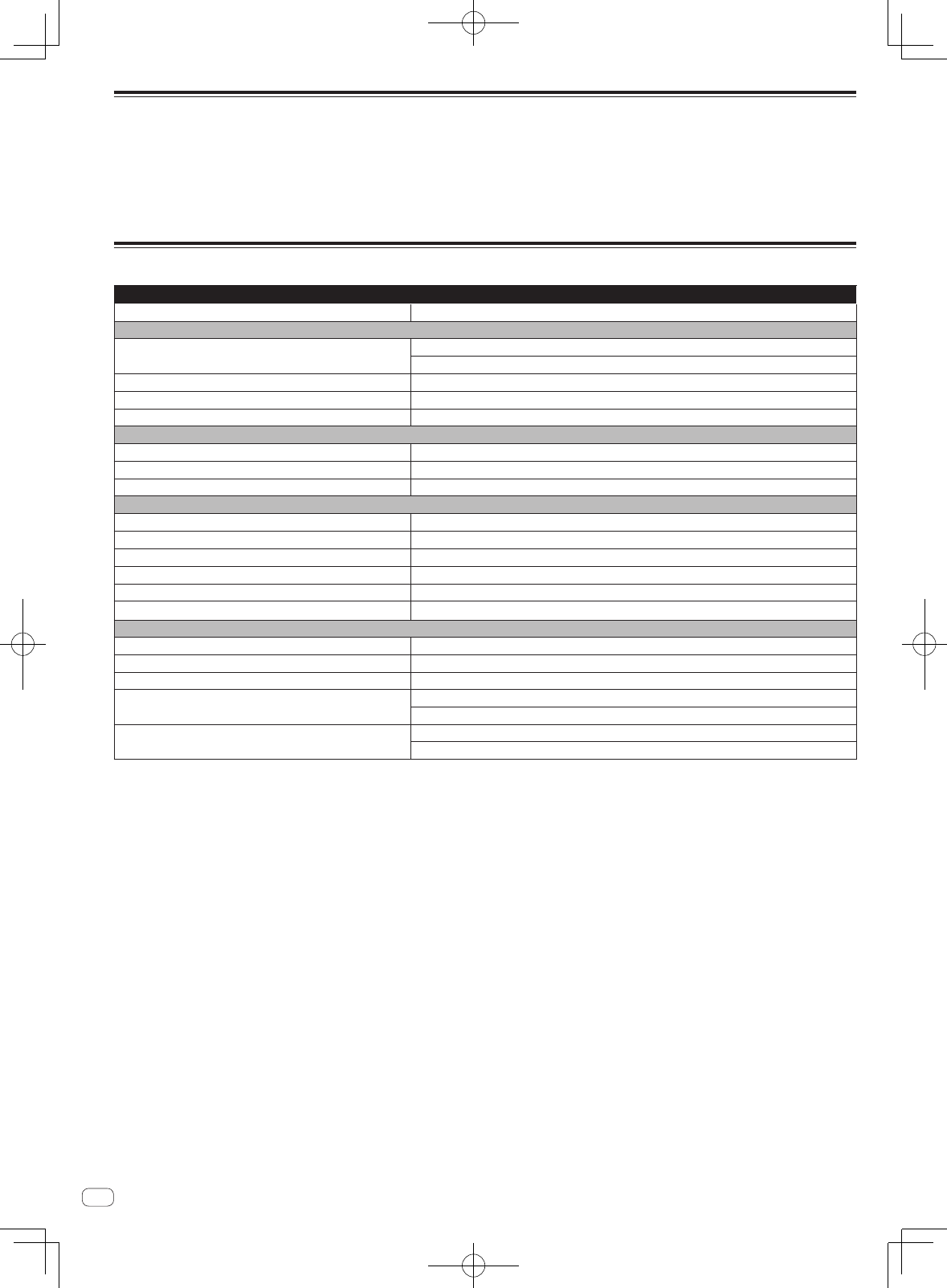
Fr
10
À propos des marques commerciales et des marques déposées
! « Pioneer DJ » est une marque déposée de PIONEER CORPORATION qui est utilisée sous licence.
! Les noms de sociétés et de produits mentionnés ici sont des marques commerciales ou des marques déposées de leurs détenteurs respectifs.
! La marque et les logos Bluetooth® sont des marques déposées appartenant à Bluetooth SIG, Inc. et toute utilisation de ces marques par PIONEER
DJ Corporation est concédée sous licence. Les autres marques commerciales et noms commerciaux appartiennent à leurs détenteurs respectifs.
! Qualcomm aptX est un produit de Qualcomm Technologies International, Ltd. Qualcomm est une marque commerciale de Qualcomm
Incorporated, déposée aux États-Unis et dans d’autres pays, utilisée avec autorisation. aptX est une marque commerciale de Qualcomm
Technologies International, Ltd., déposée aux États-Unis et dans d’autres pays, utilisée avec autorisation.
Spécifications
DM-40BT/DM-40BT-W
Modèle Haut-parleur actif 2 voies
Section d’amplificateur
Sortie d’amplification Lch : 21 W/4 W, Classe AB
Rch : 21 W/4 W, Classe AB
Prises d’entrée RCA ×1, mini-jack stéréo de 3,5 mm ×1
Impédance d’entrée 10 kW
Prises de sortie Casque ×1
Section de haut-parleur
Coffret Type basse réflex/MDF avec finition vinyle
Caisson (circuit LF) Cône de 4 pouces (102 mm)
Tweeter (circuit HF) Dôme souple de 3/4 pouces (19 mm)
Section Bluetooth
Version Bluetooth Specification de Ver. 4.2
Genere Bluetooth Specification Classe 2
Fréquence utilisée 2,4 GHz
Modulation FH-SS (Spectre de Diffusion de Frequence)
Profiles Bluetooth Supportes A2DP, AVRCP
Codec Supporte SBC, AAC, Qualcomm® aptX™, Qualcomm® aptX™ Latence Basse
Section d’alimentation / Autre
Tensions acceptées CA 110 V à 240 V, 50 Hz/60 Hz
Consommation électrique 35 W
Consommation électrique en attente (état de veille) 0,3 W
Dimensions extérieures (l × H × P) Lch : 146 mm × 227 mm × 223 mm
Rch : 146 mm × 227 mm × 210 mm
Poids Lch : 2,7 kg
Rch : 2,2 kg
! Les caractéristiques et la présentation peuvent être modifiées, sans avis préalable, dans un souci d’amélioration.
! © 2017 Pioneer DJ Corporation. Tous droits de reproduction et de traduction réservés.
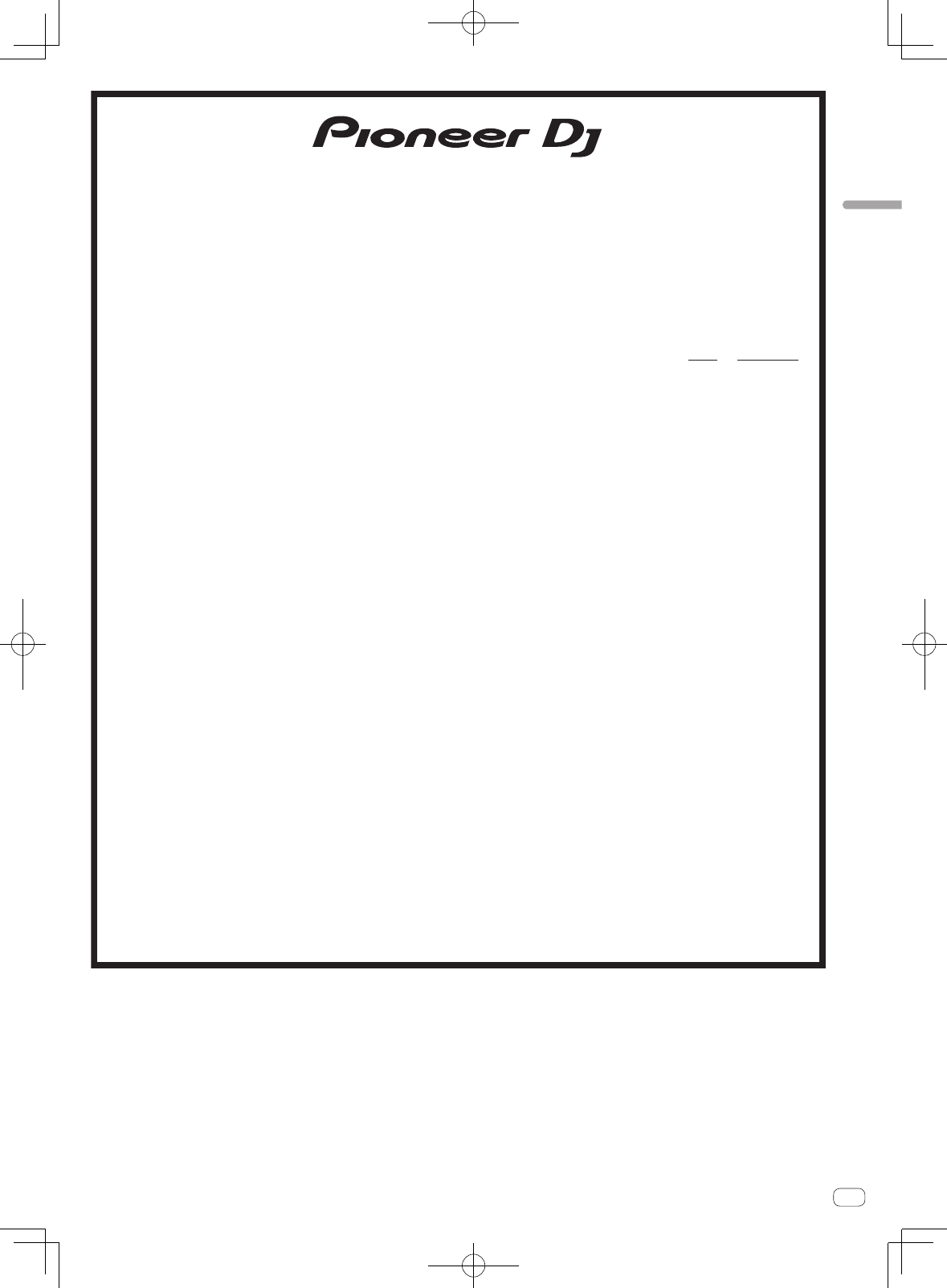
11
Fr
UCP0516
Pioneer DJ Americas, Inc.
GARANTIE LIMITÉE
GARANTIE VALABLE UNIQUEMENT AUX ÉTATS-UNIS ET AU CANADA
GARANTIE
Pioneer DJ Americas, Inc.(PDJA) garantie que les produits distribués par PDJA aux États-Unis ou au Canada qui, bien qu’étant installés et utilisés conformément au Manuel de
l’utilisateur fourni avec le produit, ne fonctionneraient pas correctement dans le cadre d’une utilisation normale en raison d’un défaut de fabrication seront réparés ou remplacés
par un produit de valeur équivalente, au choix de PDJA, sans frais à votre charge pour les pièces et/ou la main d’œuvre de réparation. Les pièces incluses en vertu de la présente
garantie peuvent être neuves ou remises à neuf, au choix de PDJA.
LA PRÉSENTE GARANTIE LIMITÉE S’APPLIQUE AU PROPRIÉTAIRE ORIGINAL AINSI QU’À TOUT PROPRIÉTAIRE SUCCESSIF DE CE PRODUIT PIONEER DJ PENDANT LA
PÉRIODE DE GARANTIE À CONDITION QUE LE PRODUIT AIT ÉTÉ ACHETÉ AUPRÈS D’UN DISTRIBUTEUR/DÉTAILLANT PIONEER DJ AGRÉÉ AUX ÉTATS-UNIS OU AU CANADA.
VOUS DEVREZ FOURNIR UN RELEVÉ DE CAISSE OU UNE AUTRE PREUVE D’ACHAT VALIDE INDIQUANT LA DATE DE L’ ACHAT INITIAL OU, SI VOUS LOUEZ LE PRODUIT,
VOTRE CONTRAT DE LOCATION INDIQUANT L’ENDROIT ET LA DATE DE LA PREMIÈRE LOCATION. EN CAS DE BESOIN DE RÉPARATION, LE PRODUIT DOIT ÊTRE RENVOYÉ
ET LIVRÉ AU COURS DE LA PÉRIODE DE GARANTIE, FRAIS DE PORT PAYÉS ET UNIQUEMENT DEPUIS L’ INTÉRIEUR DES ÉTATS-UNIS. COMME EXPLIQUÉ DANS LE PRÉSENT
DOCUMENT. VOUS ÊTES RESPONSABLE DU DÉMONTAGE ET DE L’ INSTALLATION DU PRODUIT. PDJA PREND À SA CHARGE LES FRAIS D’EXPÉDITION DU PRODUIT RÉPARÉ
OU REMPLACÉ JUSQU’À VOTRE ADRESSE À L’INTÉRIEUR DES ÉTATS-UNIS.
PÉRIODE DE GARANTIE DES PRODUITS Pièces Main-d’oeuvre
Audio et Vidéo ............................................................................................................................................................................................1 an 1 an
La période de garantie pour les clients qui louent le produit commence le jour où le produit est utilisé pour la première fois (a) pendant la période de location ou (b) après la
vente au détail, selon ce qui se produit en premier.
ÉLÉMENTS NON COUVERTS PAR LA GARANTIE
UN PRODUIT ACHETÉ CHEZ UN DISTRIBUTEUR NON AUTORISÉ N’EST COUVERT PAR AUCUNE GARANTIE EXPRESSE OU IMPLICITE, Y COMPRIS QUELQUE GARANTIE
IMPLICITE DE QUALITÉ MARCHANDE OU D’ADAPTATION À UN USAGE PA RTICULIER QUE CE SOIT. DE PLUS, CE PRODUIT EST STRICTEMENT VENDU « TEL QUEL » ET
« AVEC TOUS SES DÉFAUTS ÉVENTUELS ».
Pioneer DJ NE PEUT PAS ÊTRE TENU RESPONSABLE DES DOMMAGES INDIRECTS ET/OU ACCESSOIRES ÉVENTUELS.
LA PRÉSENTE GARANTIE NE S’APPLIQUE PAS SI LE PRODUIT A ÉTÉ SOUMIS À UNE PUISSANCE NOMINALE EXCÉDANT LA PUISSANCE INDIQUÉE DANS LES
SPÉCIFICATIONS FOURNIES.
LA PRÉSENTE GARANTIE NE COUVRE PAS LE BOÎTIER OU LES ÉLÉMENTS ESTHÉTIQUES, LES ANTENNES INSTALLÉES PAR L’UTILISATEUR, LES DOMMAGES AUX DISQUES OU
AUX RUBANS OU DISQUES D’ENREGISTREMENT, LES DOMMAGES AU PRODUIT DÉCOULANT D’UNE RETOUCHE, D’UNE MODIFICATION NON AUTORISÉE PAR ÉCRIT PAR Pioneer
DJ, D’UN ACCIDENT, D’UN USAGE INAPPROPRIÉ OU D’UN USAGE ABUSIF, LES DOMMAGES PRODUITS PAR LA FOUDRE OU LA SURTENSION, LES DOMMAGES SUBSÉQUENTS
DÉCOULANT DE FUITES, LES DOMMAGES DÉCOULANT DE PILES DÉFECTUEUSES OU DE L’ UTILISATION DE PILES NON CONFORMES À CELLES QUI SONT SPÉCIFIÉES DANS LE
MANUEL DE L’UTILISATEUR.
LA PRÉSENTE GARANTIE NE COUVRE PAS LE COÛT DES PIÈCES OU DE LA MAIN-D’OEUVRE QUI SERAIENT AUTREMENT OFFERTES SANS FRAIS EN VERTU DE LA
PRÉSENTE GARANTIE, SI ELLES SONT OBTENUES AUPRÈS D’UNE SOURCE AUTRE QU’UNE SOCIÉTÉ DE SERVICE OU AUTRE AUTORISÉE OU DÉSIGNÉE PAR Pioneer DJ.
LA PRÉSENTE GARANTIE NE COUVRE PAS LES DÉFECTUOSITÉS OU LES DOMMAGES CAUSÉS PAR L’UTILISATION D’UNE MAIN-D’OEUVRE OU DE PIÈCES NON AUTORISÉES, ET/
OU D’UN ENTRETIEN INADÉQUAT.
LES NUMÉROS DE SÉRIE MODIFIÉS, OBLITÉRÉS OU ENLEVÉS ANNULENT LA PRÉSENTE GARANTIE DANS SA TOTALITÉ.
EXCLUSION DE TOUTE AUTRE GARANTIE
Pioneer DJ LIMITE SES OBLIGATIONS EN VERTU DE TOUTE GARANTIE IMPLICITE QUE CE SOIT, Y COMPRIS ENTRE AUTRES LES GARANTIES IMPLICITES DE QUALITÉ
MARCHANDE OU D’ADAPTATION À UN USAGE PARTICULIER, À UNE PÉRIODE N’EXCÉDANT PAS LA PÉRIODE DE GARANTIE. AUCUNE GARANTIE NE S’APPLIQUE APRÈS LA
PÉRIODE DE GARANTIE. CERTAINS ÉTATS NE PERMETTENT PAS LA LIMITATION DE LA DURÉE D’UNE GARANTIE IMPLICITE, ET CERTAINS NE PERMETTENT PAS L’EXCLUSION
OU LA LIMITATION DES DOMMAGES CONSÉCUTIFS OU INDIRECTS. LES LIMITATIONS ET EXCLUSIONS ÉTABLIES CI-DESSUS PEUVENT DONC NE PAS S’APPLIQUER À VOUS.
LA PRÉSENTE GARANTIE VOUS DONNE DES DROITS LÉGAUX SPÉCIFIQUES. VOUS POUVEZ JOUIR D’AUTRES DROITS, QUI PEUVENT VARIER D’UN ÉTAT À L’AUTRE.
SERVICE APRÈS-VENTE
PDJA a autorisé un certain nombre de sociétés de service après-vente agréées à travers les États-Unis et le Canada pour le cas où votre produit
aurait besoin d’être réparé. Pour profiter d’un tel service en vertu de la garantie, vous devez présenter votre ticket de caisse ou, si vous louez
le produit, votre contrat de location indiquant l’endroit et la date de la transaction par le premier propriétaire. Si vous expédiez le produit, vous
devez l’emballer soigneusement et l’envoyer à une société de service autorisée, en port prépayé et selon une méthode de transport incluant un
suivi et une assurance. Emballez le produit au moyen de matériaux de rembourrage appropriés pour éviter tout dommage pendant le transport.
L’emballage d’origine est idéal pour cela. Indiquez votre nom, votre adresse et un numéro de téléphone où nous pouvons vous joindre pendant les heures de bureau.
Pour toute réclamation et/ou question à l’intérieur des États-Unis ou du Canada, appelez le Service Consommateurs au 1-800-872-4159.
Pour toute question concernant la mise en service ou l’utilisation de votre produit,
ou pour trouver une société de service autorisée, appelez ou écrivez à :
CUSTOMER SUPPORT
PIONEER ELECTRONICS (USA) INC.
P.O. BOX 1720
LONG BEACH, CALIFORNIA 90801
1-800-872-4159
http://www.pioneerelectronics.com
RÉSOLUTION DES LITIGES
Si un litige se produit entre vous et Pioneer DJ après la réponse à une demande initiale faite au Service Consommateurs, vous pouvez avoir recours au Programme de résolution des
plaintes de Pioneer DJ pour résoudre le litige. Le Programme de résolution des plaintes vous est offert gratuitement. Vous devez avoir recours au Programme de résolution des plaintes
avant de vous prévaloir de vos droits ou de chercher réparation en vertu du Titre I de la loi Magnuson-Moss Warranty-Federal Trade Commission Improvement Act, 15 U.S.C. 2301 et seq.
Pour utiliser le Programme de résolution des plaintes, appelez le 1-800-872-4159 et expliquez au représentant du Service Consommateurs
le problème que vous rencontrez ainsi que les démarches que vous avez effectuées pour faire réparer le produit pendant la période
de garantie, puis communiquez-lui le nom du distributeur /détaillant autorisé auprès duquel vous avez acheté le produit Pioneer DJ.
Une fois que votre plainte a été expliquée au représentant, un numéro de résolution vous sera communiqué. Pioneer DJ étudiera votre plainte et, dans un délai de quarante (40) jours
après la réception de votre plainte, (1) répondra à votre plainte par écrit pour vous aviser des démarches qui seront entreprises pour résoudre le conflit, et indiquera combien de temps
ces démarches prendront ; ou (2) répondra à votre plainte par écrit pour vous indiquer les raisons pour lesquelles aucune démarche ne sera entreprise.
NOTEZ ET CONSERVER LE LIEU ET LA DATE D’ACHAT POUR RÉFÉRENCE ULTÉRIEURE
N° de modèle : _______________________________________ N° de Série : ________________________________________________________________________
Date d’achat : ________________________________________ Nom du distributeur/détaillant ___________________________________________________________
PRENEZ SOIN DE CONSERVER CES INFORMATIONS ET VOTRE REÇU D’ACHAT EN LIEU SÛR POUR RÉFÉRENCE ULTÉRIEURE
Français
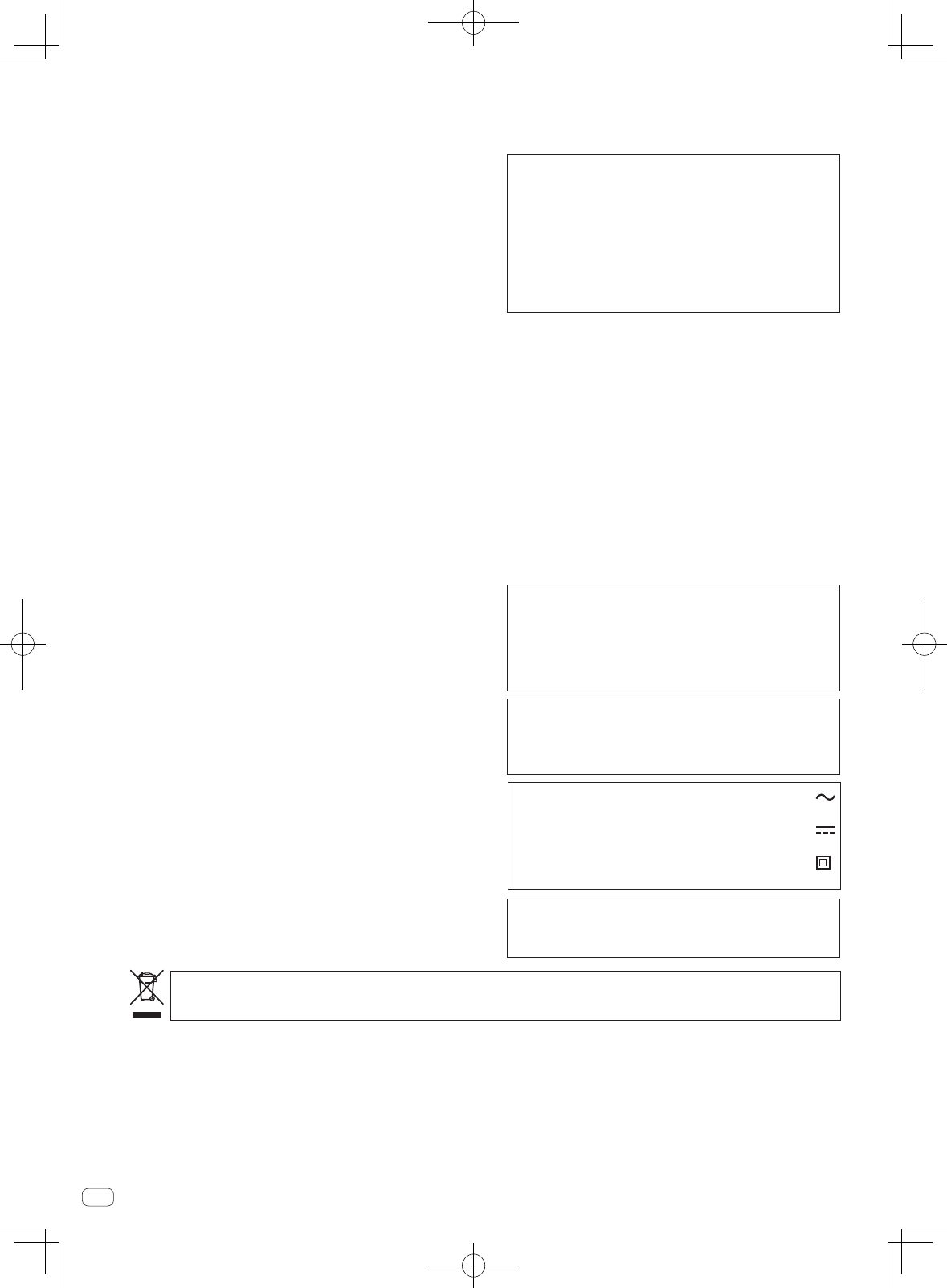
De
2
Vielen Dank, dass Sie sich für dieses Pioneer DJ-Produkt entschieden haben.
Bitte lesen Sie diese Bedienungsanleitung gründlich durch, um sich mit derBedienung des Geräts vertraut zu machen
.
Nachdem Sie die Bedienungsanleitung gelesen habe
n, legen Sie sie griffbereit zum Nachschlagen ab.
ACHTUNG
UM SICH NICHT DER GEF
AHR EINES ELEKTRISCHEN
SCHL
AGES AUSZUSETZEN, DÜRFEN SIE NICHT DEN
DECKEL (ODER DIE RÜCKSEITE) ENTFERNEN. IM
GERÄTEINNEREN BEFINDEN SICH KEINE VOM
BENUTZER REP
ARIERBAREN TEILE. ÜBERLASSEN
SIE REP
ARATUREN DEM QUALIFIZIERTEN
KU
NDENDIENST. D3-4-2-1-1_B1_De
WARNUNG
Dieses Gerät ist nicht wasserdicht. Zur
Vermeidung der
Gefahr von Brand und Stromschlag keine Behälter mit
Flüssigkeiten (z.B. Blumenvasen und -töpfe) in die
Nähe des Gerätes bringen und dieses vor
Tropfwasser,
Spritzwasse
r, Regen und Nässe schützen.
D3-4-2-1-3_A1_De
WARNUNG
Keine Quellen offener Flammen (z.B. eine brennende
Ker
ze) auf dieses Gerät stellen.
D3-4-2-1-7a_A1_De
Betriebsumgebung
Betriebstemperatur und Betriebslu
ftfeuchtigkeit:
+5 °C bis +35 °C, 85 % rel.
Feuchte max.
(V
entilationsschlitze nicht blockiert)
Eine Aufstellung dieses Gerät an einem unzureichend
belü
fteten, sehr feuchten oder heißen Ort ist zu
vermeide
n, und das Gerät darf weder direkter
Sonneneinstrahlung noch starken K
unstlichtquellen
ausgesetzt werden
.
D3-4-2-1-7c*_A1_De
VORSICHTSHINWEIS ZUR BELÜFTUNG
Bei der Aufstellung dieses Gerätes muss für einen
ausreichenden
Freiraum gesorgt werden, um eine
einwandfreie Wärmeabfuhr zu gewährleisten
(mindestens 15 cm oberhalb des Gerätes, 15 cm hinter
dem Gerät und jeweils 15 cm an der Seite des Gerätes)
.
D3-4-2-1-7d*_A1_De
Dieses Gerät ist für den Heimgebrauch vorgesehen.
Falls bei Einsatz zu einem anderem Zweck (z.B.
Langzeitgebrauch zu gewerblichen Zwecken in einem
Restaurant oder Betrieb in einem Fahrzeug bzw.
Schiff) eine Funktionsstörung auftritt, die eine
Reparatur des Gerätes erforderlich macht, werden
die Reparaturkosten dem Kunden selbst dann in
Rechnung gestellt, wenn die Garantiefrist noch nicht
abgelaufen ist. K041_A1_De
Mischen Sie dieses Produkt, wenn Sie es entsorgen wollen, nicht mit gewöhnlichen Haushaltsabfällen. Es gibt ein getrenntes
Sammelsystem für gebrauchte elektronische Produkte, über das die richtige Behandlung, Rückgewinnung und Wiederverwertung
gemäß der bestehenden Gesetzgebung gewährleistet wird.
Privathaushalte in den Mitgliedsstaaten der EU, in der Schweiz und in Norwegen können ihre gebrauchten elektronischen Produkte an
vorgesehenen Sammeleinrichtungen kostenfrei zurückgeben oder aber an einen Händler zurückgeben (wenn sie ein ähnliches neues Produkt
kaufen).
Bitte wenden Sie sich in den Ländern, die oben nicht aufgeführt sind, hinsichtlich der korrekten Verfahrensweise der Entsorgung an die örtliche
Kommunalverwaltung.
Auf diese Weise stellen Sie sicher, dass das zu entsorgende Produkt der notwendigen Behandlung, Rückgewinnung und Wiederverwertung
unterzogen wird, und so mögliche negative Einflüsse auf die Umwelt und die menschliche Gesundheit vermieden werden.
K058b_A1_De
VORSICHT MIT DEM NETZKABEL
Fassen Sie das Netzkabel immer am Stecker. Ziehen Sie
nicht am Kabel selbst, und fassen Sie das Netzkabel
niemals mit nassen Händen an, da dies einen
Kurzschluss oder elektrischen Schlag verursachen
kann. Stellen Sie nicht das Gerät, Möbelstücke o.ä. auf
das Netzkabel; sehen Sie auch zu, dass es nicht
eingeklemmt wird. Machen Sie niemals einen Knoten
in das Netzkabel, und binden Sie es nicht mit anderen
Kabeln. Das Netzkabel sollte so gelegt werden, dass
niemand darauf tritt. Ein beschädigtes Netzkabel kann
einen Brand oder elektrischen Schlag verursachen.
Prüfen Sie das Netzkabel von Zeit zu Zeit. Sollte es
beschädigt sein, wenden Sie sich an Ihre nächste
Kundendienststelle oder Ihren Händler, um es zu
ersetzen. S002*_A1_De
Vorsichtshinweis für Modell DM-40BT/DM-40BT-W
Diesen Lautsprecher ausschließlich an den
Verstärker im Lieferumfang dieser Anlage
anschließen. Der Anschluss an einen anderen
Verstärker kann Funktionsstörungen oder einen
Brand verursachen. SGK006*_A1_De
Dieser Lautsprecher darf auf keinen Fall an einer
Wand oder der Decke montiert werden, da er
anderenfalls herunterfallen und Verletzungen
verursachen kann. SGK007_A1_De
WARNUNG
Im Gerätegehäuse sind
Ventilationsschlitze und andere
Öffnungen vorgesehe
n, die dazu dienen, eine
Überhitzung des Gerätes zu verhindern und einen
zuverlässigen Betrieb zu gewährleisten
. Um
Brandgefahr auszuschließe
n, dürfen diese Öffnungen
auf keinen
Fall blockiert oder mit Gegenständen (z.B.
Zeitungen
, Tischdecken und Gardinen) abgedeckt
werde
n, und das Gerät darf beim Betrieb nicht auf
einem dicken
Teppich oder Bett aufgestellt sein.
D3-4-2-1-7b*_A1_De
Das auf diesem Produkt angebrachte Piktogramm
verweist auf Wechselstrom.
Das auf diesem Produkt angebrachte Piktogramm
verweist auf Gleichstrom.
Das auf diesem Produkt angebrachte Piktogramm
verweist auf ein Gerät der Klasse II. D3-8-2-4_A1_De
ACHTUNG
Dieses Produkt wurde unter moderaten
Klimabedingungen getestet. D3-8-2-1-7b_A1_De
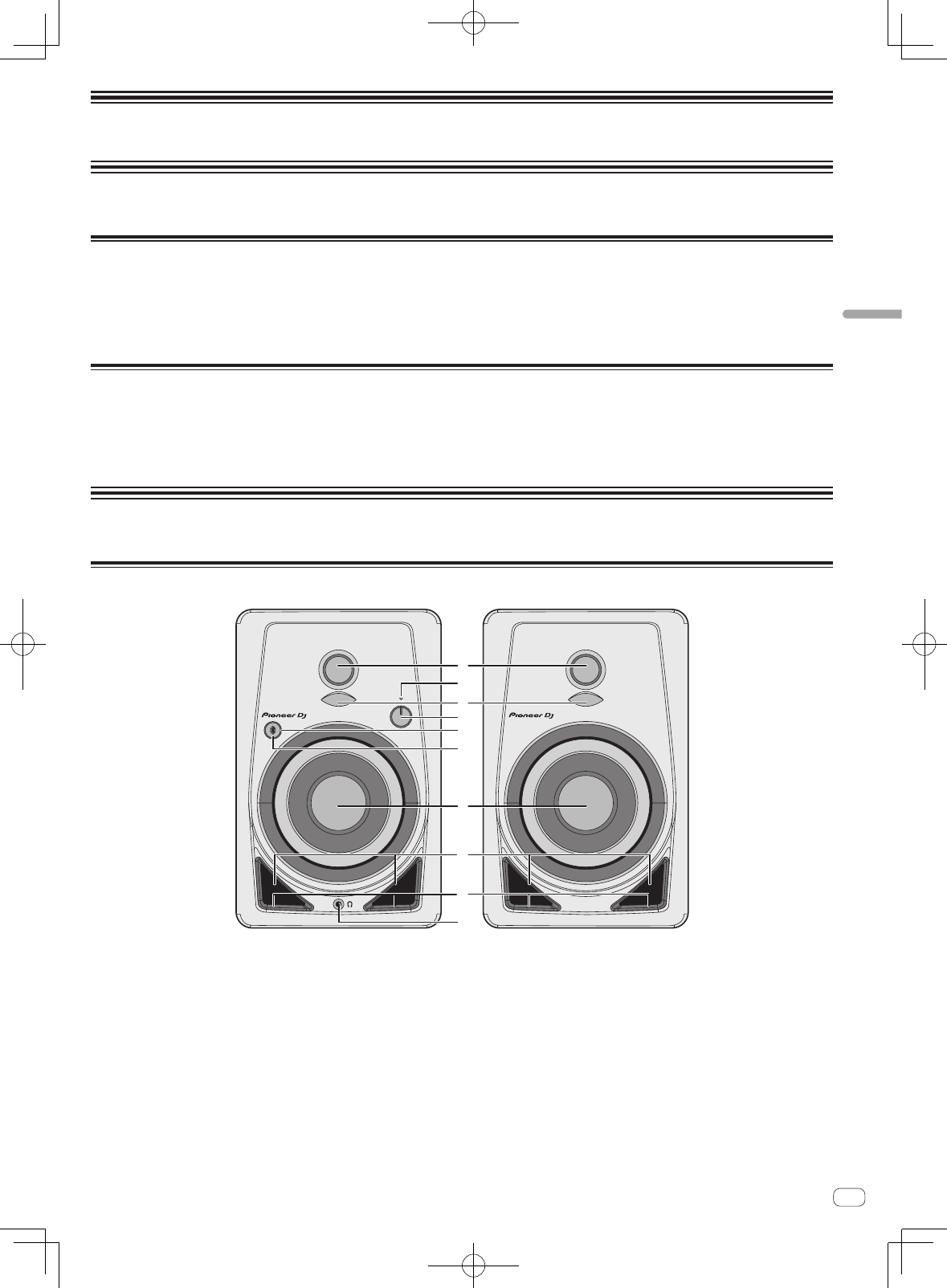
De 3
Deutsch
Vor Gebrauch lesen (wichtig)
Vor der Inbetriebnahme
Merkmale
! Ein Bassreflexrohr an der Vorderseite und die Groove-Technologie erzeugen einen kraftvollen Basston.
! Ein konvexer Diffusor auf einem neu geformten Hornvorsatz verbessert die Richtcharakteristik von Hochfrequenztönen und die Klangdiffusion.
! Kraftvoller Basston und klarere Soundqualität trotz seiner platzsparenden, kompakten Größe.
! Kompatibel mit AAC und Qualcomm® aptX™ für eine hochwertigere Tonwiedergabe über Bluetooth.
! Über die Pairing-Taste an der Vorderseite ist eine Kopplung mit einem Tastendruck möglich.
Überprüfen des Zubehörs
! Netzkabel x1
! Bedienungsanleitung (dieses Dokument)
! Audio-Wandlerkabel (3,5 mm-Stereo-Miniklinkenstecker zu RCA) x1
! Lautsprecherkabel x1
! Polster für die Unterseite x8
Bezeichnung und Funktion der Teile
Frontplatte
1
2
3
4
7
8
9
a
5
6
1 3/4 Zoll-Weichkalottenhochtöner
2 POWER-Anzeige
Die Anzeigen leuchten entsprechend des Einschaltzustands. Die
Anzeige leuchtet im Standby-Betrieb nicht.
3 Diffusoren
Verbessern die Richtcharakteristik von Hochfrequenztönen und die
Klangdiffusion.
4 LEVEL-Regler
Zum Einstellen der Lautstärke.
5 Pairing-Taste
Mit dieser Taste kann eine Kopplung mit einem Bluetooth-Gerät
ausgeführt werden. Mit dieser Taste steuern Sie auch die Pause und
die Wiedergabe während einer Musikwiedergabe über Bluetooth.
Weitere Informationen hierzu finden Sie unter „Wiedergabe von
Musik auf einem Bluetooth-Gerät“ (Seite 6).
6 Pairing-Anzeige (Seite 6)
Blinkt: Die Kopplung wird ausgeführt oder wartet auf eine Verbindung
Leuchtet: Mit dem Bluetooth-Gerät verbunden
7 4 Zoll-Glasfaser-Subwoofer
8 Bassreflexrohr
9 Öffnungen
Reguliert den Luftstrom im Bassreflexrohr zur gleichmäßigen
Abstrahlung tiefer Frequenzen.
a Kopfhörerbuchse
Das ist die 3,5 mm-Stereo-Miniklinkenstecker-Ausgangsbuchse.
Durch den Anschluss von Kopfhörern wird die Ton der Lautsprecher
stumm geschaltet und der Ton wird nur über die Kopfhörer
ausgegeben.
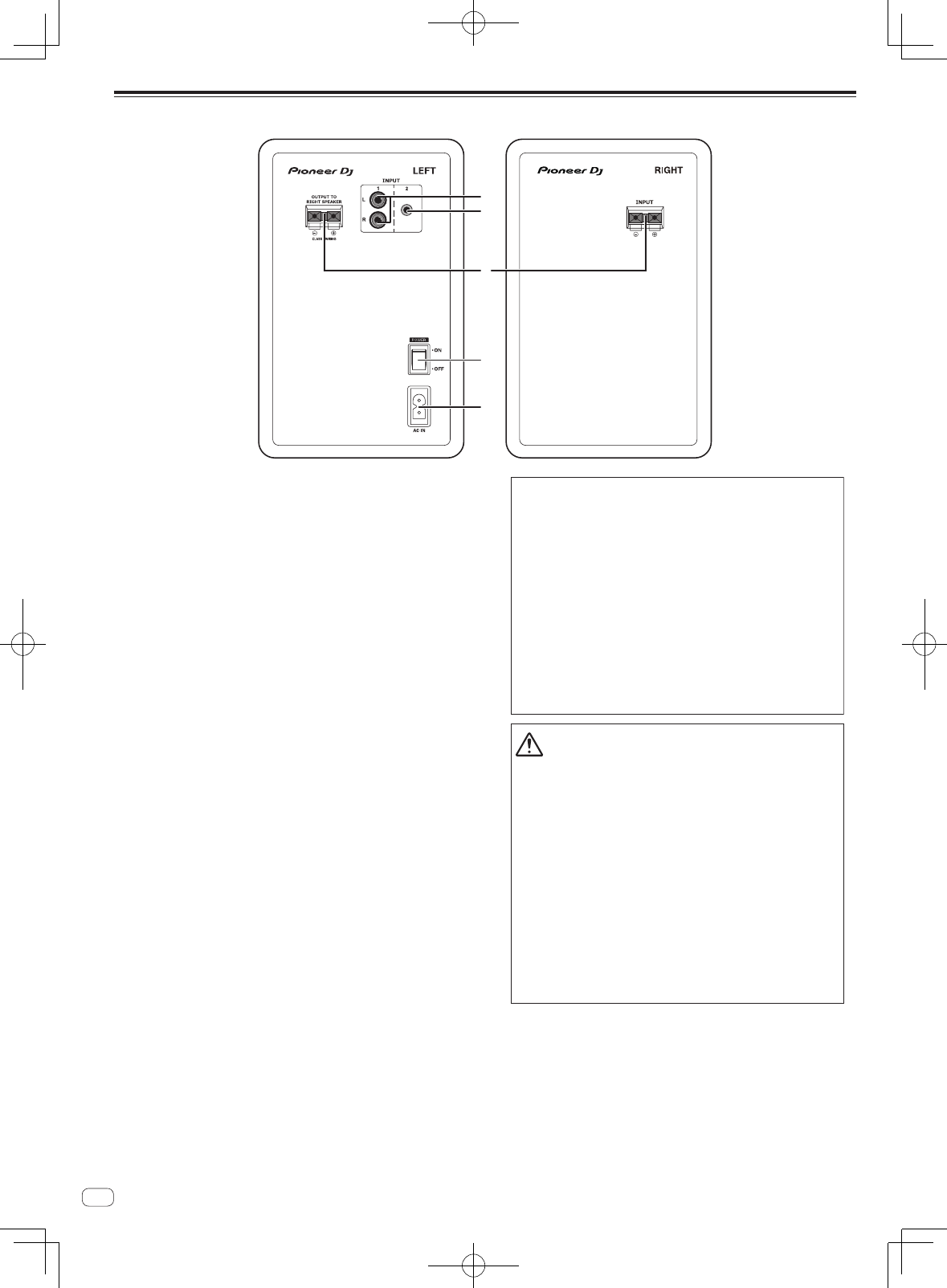
De
4
Rückseite
2
4
5
1
3
1 INPUT 1-Buchsen (Stereo)
Bei diesen Chinchbuchsen (RCA) handelt es sich um unsymmetri-
sche Eingangsbuchsen.
2 INPUT 2-Buchsen (Stereo)
Bei dieser 3,5 mm-Stereo-Miniklinkenstecker-Buchse handelt es sich
um eine unsymmetrische Eingangsbuchse.
3 Buchse für den Lautsprecheranschluss
Verbinden Sie den rechten und linken Lautsprecher mit diesem
mitgelieferten Kabel.
Verbinden Sie diese Lautsprecher nur mit einem Verstärker dieses
Systems. Andernfalls kann es zu Beschädigungen oder Brand
kommen.
4 POWER-Schalter
Schalten Sie die Stromversorgung dieses Geräts ein und aus.
5 AC IN
Stecken Sie das Netzkabel in AC IN und dann in die Steckdose.
Schließen Sie das Netzkabel an, nachdem alle Anschlüsse zwischen
den Geräten vorgenommen wurden.
Verwenden Sie immer das mitgelieferte Netzkabel.
ACHTUNG
Der POWER-Schalter dieses Gerätes trennt das Gerät
nicht vollständig vom Stromnetz. Um das Gerät
vollständig vom Netz zu trennen, muss der
Netzstecker aus der Netzsteckdose gezogen werden.
Daher sollte das Gerät so aufgestellt werden, dass
stets ein unbehinderter Zugang zur Netzsteckdose
gewährleistet ist, damit der Netzstecker in einer
Notsituation sofort abgezogen werden kann. Um
Brandgefahr auszuschließen, sollte der Netzstecker
vor einem längeren Nichtgebrauch des Gerätes,
beispielsweise während des Urlaubs, grundsätzlich
von der Netzsteckdose getrennt werden.
D3-4-2-2-2a*_A1_De
ATTENTION
!Dieses Produkt verfügt über eine automatische Standby-
Funktion. Wenn beim Gebrauch für einen bestimmten
Zeitraum (ca. 30 Minuten) kein Ton ausgegeben wird,
schaltet das Produkt automatisch die POWER-Anzeige
aus und wechselt in den Standby-Betrieb mit niedrigem
Stromverbrauch, egal ob gerade eine Bluetooth-Verbindung
besteht oder nicht.
!Wenn das Produkt in den Standby-Betrieb wechselt, wenn
eine Bluetooth-Verbindung besteht, wird die Bluetooth-
Verbindung getrennt und die Bluetooth-Anzeige wird auch
ausgeschaltet.
!Wenn ein Audiosignal im Standby-Betrieb über die
Eingangsbuchsen empfangen wird, wird automatisch der
normale Betrieb fortgesetzt. Das Gerät schaltet auch in
den normalen Betrieb, wenn die Bluetooth-Pairing-Taste im
Standby-Betrieb gedrückt wird.
!Die automatische Standby-Funktion kann nicht deaktiviert
werden.
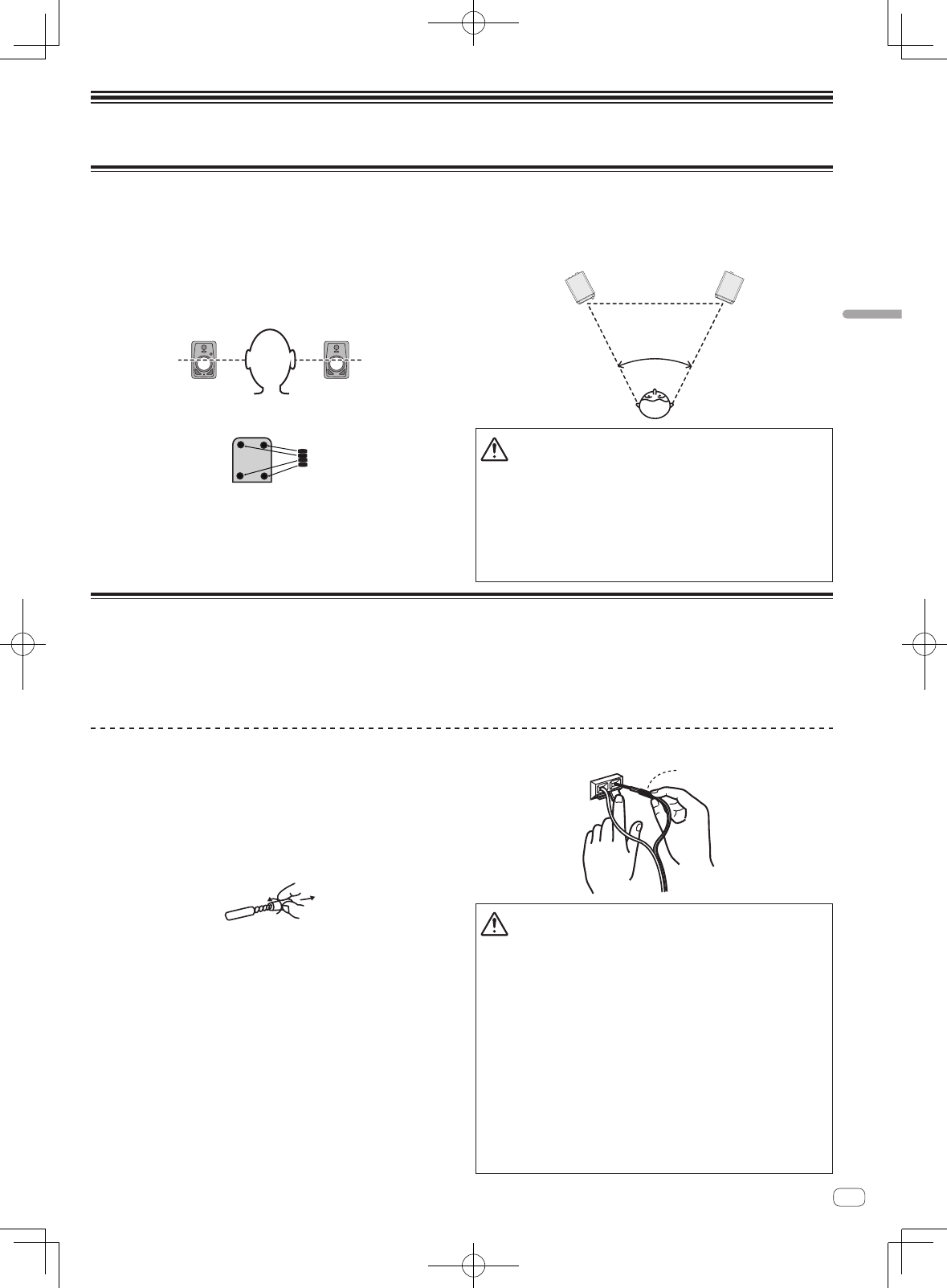
De 5
Deutsch
Installation und Anschlüsse
Installationsverfahren
Der Wiedergabeklang eines Lautsprechers wird durch die akustischen
Verhältnisse im Hörraum beeinflusst. Bitte berücksichtigen Sie vor
Beginn der Installation sorgfältig die Bedingungen am Aufstellungsort,
um eine optimale Hörumgebung zu kreieren.
! Stellen Sie die Lautsprecher auf Ohrenhöhe auf.
! Um einen natürlich wirkenden Stereoeffekt zu erzielen,sollten der
rechte und der linke Lautsprecher an einer symmetrischen Position
jeweils im gleichen Abstand von der Hörposition aufgestellt werden.
! Befestigen Sie die mitgelieferten Polster als Schutz vor Rutschen an
der Unterseite des Geräts.
WARNUNG
Kleine
Teile außerhalb der Reichweite von Kleinkindern
und Kindern aufbewahre
n. Bei unbeabsichtigtem
Ve
rschlucken ist unverzüglich ein Arzt aufzusuchen.
D41-6-4_A1_D
e
! Stellen Sie die Lautsprecher so auf, dass diese nach innen zeigen
und insgesamt einen Winkel von 60 Grad von der Hörposition auf-
weisen, d. h. jeweils in einem Winkel von 30 Grad für den linken und
rechten Lautsprecher.
50 ° bis 60 °
ACHTUNG
Um eine einwandfreie Wärmeabfuhr zu gewährleisten, sollte ein
ausreichender Abstand zwischen den Lautsprechern und Wänden
und anderen Komponenten eingehalten werden (mindestens jeweils
mindestens 15 cm oberhalb und hinter jedem Lautsprecher sowie
auf beiden Seiten). Falls die Lautsprecher zu nah nebeneinander, an
einer Wand oder anderen Komponenten aufgestellt werden, führt
dies möglicherweise zu einem Anstieg der Innentemperatur, der eine
Funktionsstörung oder Beschädigung zur Folge haben kann.
Anschlüsse
! Schalten Sie die Stromversorgung aus und ziehen Sie das Netzkabel
aus der Netzsteckdose, bevor Sie Geräte anschließen oder die
Anschlüsse ändern.
! Beachten Sie die Bedienungsanleitung der angeschlossenen
Komponente.
! Schließen Sie das Netzkabel an, nachdem alle Anschlüsse zwischen
den Geräten vorgenommen wurden.
! Verwenden Sie immer das mitgelieferte Netzkabel.
! Stellen Sie die Lautstärke auf einen geeigneten Pegel, da die
Eingangssignale für die [INPUT 1]-Buchse, [INPUT 2]-Buchse und
Bluetooth gemischt werden.
Kabel anschließen
Verbinden Sie das mitgelieferte Lautsprecherkabel mit den
Lautsprechern.
1 Sie müssen den Anfang des mitgelieferten
Lautsprecherkabels auf ca. 1 cm abisolieren. Entflechten
Sie die freigelegte Isolierung und entfernen Sie diese.
Nachdem Sie die Isolierung entfernt haben, verdrillen Sie sorgfältig die
Kerndrähte.
2 Verbinden Sie das mitgelieferte Lautsprecherkabel
mit den Lautsprecherbuchsen auf der LINKEN und
RECHTEN Seite.
3 Führen Sie die Kerndrähte in die Buchsen ein, indem
Sie auf die Klemme an der Lautsprecherbuchse drücken.
Verbinden Sie das Lautsprecherkabel mit der roten Linie mit der Buchse
+ (rot) und das Lautsprecherkabel ohne die rote Linie mit der Buchse
– (schwarz).
Rot +
Schwarz
−
Mit der roten Linie
ACHTUNG
! Nach dem Anschluss ziehen Sie leicht am Kabel, um sicherzustel-
len, dass der Anfang der Lautsprecherkabel sicher in den Buchsen
befestigt ist. Eine lose Verbindung kann dazu führen, dass die
Audio-Ausgabe unterbrochen wird oder Störgeräusche ausgege-
ben werden.
! Beim Anschluss des Lautsprecherkabels müssen Sie die
Kerndrähte sorgfältig verdrillen. Achten Sie darauf, dass die
Kerndrähte nicht aus den Lautsprecherbuchsen hervorragen.
Kerndrähte, die aus den Lautsprecherbuchsen hervorragen, kön-
nen in Kontakt mit der Rückseite kommen oder sich gegenseitig
berühren. Dadurch kann es zu einer übermäßigen Last auf den
Verstärker kommen, so dass der Betrieb unterbrochen wird oder
es zu einer Fehlfunktion kommt.
! Bei einem Fehler der Polarität (+, –) auf der LINKEN und
RECHTEN Seite beim Anschluss der LINKEN und RECHTEN
Lautsprecherkabel kann der normale Stereosound nicht erreicht
werden.
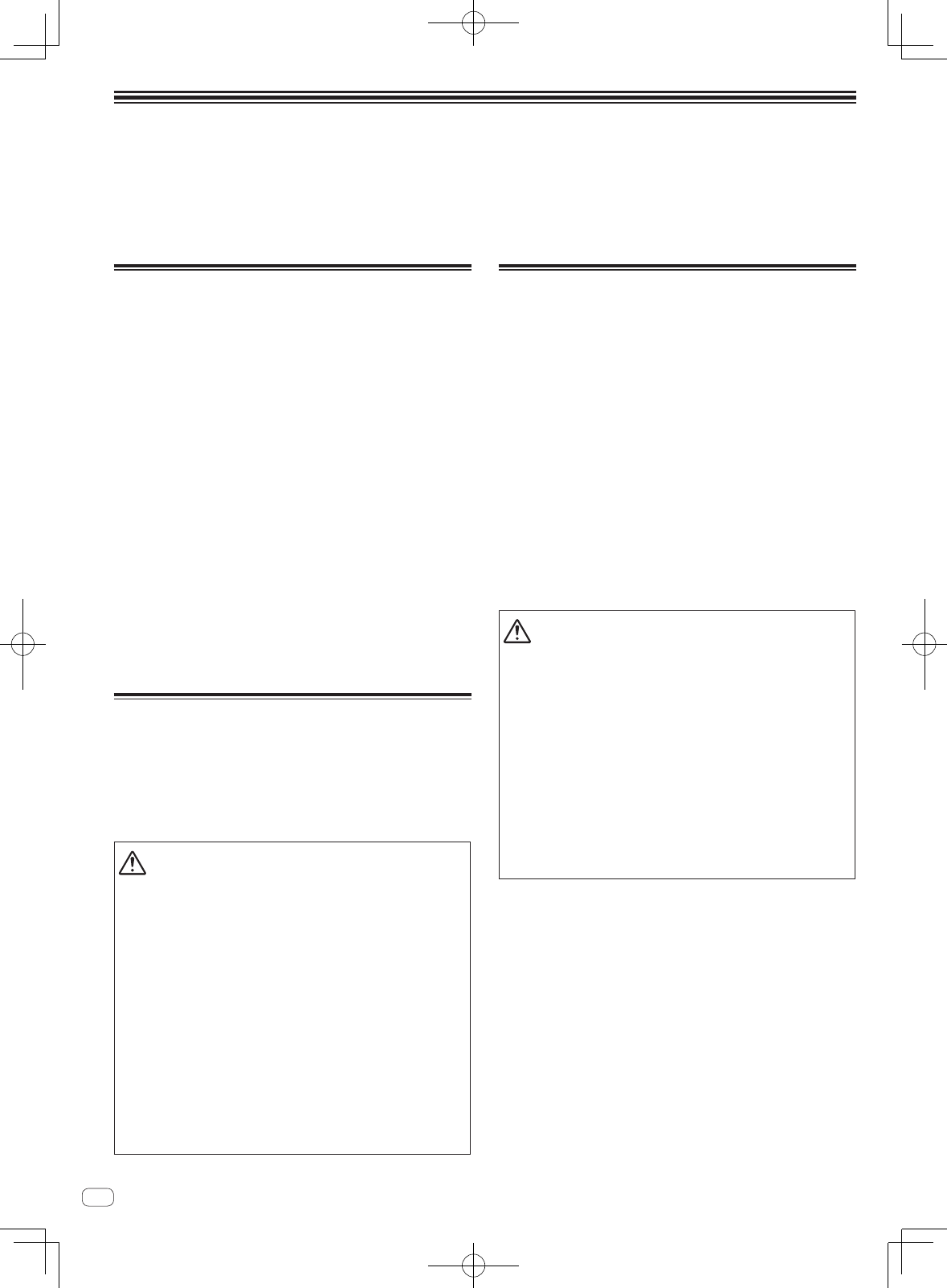
De
6
Wiedergabe von Musik auf einem
Bluetooth-Gerät
Über diese Lautsprecher können Sie drahtlos Tracks hören, die auf einem Bluetooth-Gerät gespeichert sind.
Wenn Sie die Lautsprecher zum ersten Mal benutzen oder ein neues Bluetooth-Gerät mit den Lautsprechern verbinden, müssen Sie die Lautsprecher
und das Bluetooth-Gerät koppeln.
Die Kopplung (gegenseitige Geräteregistrierung) ist das Verfahren, mit dem Sie ein Bluetooth-Gerät und die Lautsprecher verbinden.
Kopplungs- und
Verbindungsverfahren
1 Betätigen Sie den [POWER]-Schalter, um die
Lautsprecher einzuschalten.
! Die Bluetooth-Anzeige blinkt ca. 30 Sekunden lang und die
Lautsprecher wechseln in den Kopplungsmodus.
! Wenn die Bluetooth-Anzeige aus ist, drücken Sie die Pairing-Taste
für mindestens 2 Sekunden, um wieder zum Kopplungsmodus zu
wechseln.
2 Führen Sie die Kopplung auf dem Bluetooth-Gerät
aus.
Führen Sie die Kopplung durch, während sich die Lautsprecher
im Kopplungsmodus befinden. Einzelheiten finden Sie in der
Bedienungsanleitung Ihres Bluetooth-Geräts.
3 Wenn die Bluetooth-Anzeige von einem Blinken
zu einem Leuchten wechselt, ist die Kopplung (die
Verbindung) abgeschlossen.
Wenn die Kopplung nicht innerhalb von 30 Sekunden ausgeführt
werden konnte, hört die Bluetooth-Anzeige auf zu blinken und schaltet
sich aus.
! Ein Bluetooth-Gerät, das schon gekoppelt wurde, kann neu verbun-
den werden, indem die Verbindung auf dem Bluetooth-Gerät durch-
geführt wird. Dazu müssen die Lautsprecher eingeschaltet sein.
Wiedergabe
Wenn Sie Musik von einem verbundenen Bluetooth-Gerät wiederge-
ben, wird die Musik, die vom Bluetooth-Gerät abgespielt wird, von den
Lautsprechern ausgegeben.
! Wenn Sie während der Musikwiedergabe auf dem Bluetooth-Gerät
die Pairing-Taste drücken, können Sie die Pause/die Wiedergabe
steuern (dieselbe Funktion wie die Pause-/Wiedergabe-Taste auf
dem Bluetooth-Gerät).
CAUTION
! Stellen Sie beim Koppeln (beim Verbinden) das Bluetooth-Gerät in
die Nähe der Lautsprecher auf.
! Die Lautstärke kann sehr laut sein, wenn die Wiedergabe nach der
erfolgreichen Verbindung das erste Mal gestartet wird, deshalb
empfehlen wir, vor der Wiedergabe eine niedrigere Lautstärke
einzustellen.
! Es ist möglich, dass die Pause/Wiedergabe je nach verwendeter
Anwendung mit der Pairing-Taste nicht ausgeführt werden kann.
! Die Verbindung mit den Lautsprechern kann bei manchen
Bluetooth-Geräten nicht hergestellt werden.
! Wenn Sie eine Verbindung mit einem anderen Bluetooth-Gerät
herstellen möchten, schalten Sie die Bluetooth-Funktion des
derzeit verbundenen Bluetooth-Geräts aus oder trennen Sie die
Verbindung, bevor Sie die Kopplung ausführen.
! Die Lautsprecher speichern die Kopplungsdaten von bis zu acht
Bluetooth-Lautsprechern und versuchen, sich mit dem letzten
gekoppelten Gerät zu verbinden, wenn die Pairing-Taste in dem
Moment gedrückt wird, in dem keine Verbindung zu einem
Bluetooth-Gerät hergestellt ist.
Vorsichtshinweise zu HF-Wellen
Dieses Gerät arbeitet mit einer Rundfunkwellenfrequenz von 2,4 GHz,
wobei es sich um ein von anderen drahtlosen Systemen ebenfalls
verwendetes Frequenzband handelt (siehe die nachstehende Liste).
Um Rauscheinstreuungen oder Unterbrechungen der Kommunikation
zu vermeiden, sollte dieses Gerät nicht in der Nähe derartiger Geräte
betrieben werden, oder die betreffenden Gerät sollten während des
Gebrauchs dieses Gerätes ausgeschaltet werden.
! Drahtlose Telefone
! Drahtlose Faxgeräte
! Mikrowellenherde
! Drahtlose LAN-Geräte (IEEE802.11b/g)
! Drahtlose AV-Geräte
! Drahtlose Steuerungen für Videospielsysteme
! Mit Mikrowellen arbeitende Geräte des Gesundheitswesens
! Bestimmte Baby-Monitoren
Sonstige, weniger weit verbreitete Geräte, die möglicherweise mit der
gleichen Frequenz arbeiten:
! Diebstahlverhütungsanlagen
! Amateur-Rundfunksender (HAM)
! Logistische Verwaltungsanlagen von Lagerhäusern
! Unterscheidungsanlagen für Züge und Fahrzeuge des Notdienstes
ACHTUNG
! Sollte es zu Rauschen auf Ihrem Fernsehbild kommen, besteht
die Möglichkeit, dass ein Bluetooth®-Gerät oder dieses Gerät
(auch Produkte, die von diesem Gerät unterstützt werden) eine
Signalstörung mit dem Antennen-Eingangsanschluss Ihres
Fernsehers, Videogeräts, Satellitentuners etc. verursacht.
Vergrößern Sie in diesem Fall den Abstand zwischen dem
Antennen-Eingangsanschluss und dem Bluetooth-Gerät oder
diesem Gerät (auch der Produkte, die von diesem Gerät unterstützt
werden).
! Wenn sich ein Hindernis auf dem Übertragungsweg zwischen
diesem Gerät (einschließlich von Produkten, die von diesem Gerät
unterstützt werden) und dem mit Bluetooth drahtloser Technologie
ausgestatteten Gerät befindet (z. B. eine Metalltür, Betonwand
oder Staniolfolie enthaltendes Isolationsmaterial), muss der
Aufstellungsort der Anlage möglicherweise verändert werden, um
Signalrauschen und Unterbrechungen zu vermeiden.

De 7
Deutsch
Betriebsumfang
Dieses Gerät ist ausschließlich für den Heimgebrauch bestimmt. (Je
nach Kommunikationsgerät kann sich der Übertragungsweg ver-
ringern). Bei Betrieb an den folgenden Orten können ungünstige
Bedingungen den Empfang von HF-Wellen unmöglich machen, so dass
Tonunterbrechungen auftreten oder die Tonausgabe vollständig stoppt:
! In Stahlbetongebäuden oder Gebäuden mit Stahl- oder
Eisenrahmen.
! In der Nähe großer Möbelstücke aus Metall.
! In Menschenansammlungen oder in der Nähe eines Gebäudes oder
Hindernisses.
! An einem Ort, der einem Magnetfeld, statischer Elektrizität oder
HFEinstreuungen von einem mit HF-Wellen arbeitenden Gerät
ausgesetzt ist, das das gleiche Frequenzband (2,4 GHz) wie die-
ses Gerät verwendet, z. B. ein drahtloses 2,4-GHz-LAN-Gerät oder
Mikrowellenherd.
! Wenn Sie an einem dicht bevölkerten Ort (Miethaus, Häuserzeile
usw.) wohnen und sich der Mikrowellenherd eines Nachbars in der
Nähe Ihrer Anlage befindet, können HF-Einstreuungen auftreten. In
einem solchen Fall müssen Sie für einen größeren Abstand sorgen,
indem Sie den Aufstellungsort dieses Gerätes verändern. Derartige
HFEinstreuungen treten nur dann auf, wenn der betreffende
Mikrowellenherd in Betrieb ist.
Reflektierte HF-Wellen
Zu den von diesem Gerät empfangenen HFWellen gehören sowohl die
direkt von dem mit Bluetooth drahtloser Technologie ausgestatteten
Gerät übertragenen HFWellen (direkte Wellen) als auch HFWellen, die
aus verschiedenen Richtungen eintreffen, weil sie von Wänden, Möbeln
und Gebäuden reflektiert werden (reflektierte Wellen). Derartige reflek-
tierte Wellen erzeugen (aufgrund von Hindernissen und reflektierenden
Gegenständen) eine Vielzahl weiterer reflektierter Wellen und können
je nach Aufstellungsort zu Schwankungen der Empfangsbedingungen
führen. Falls ein einwandfreier Tonempfang wegen dieses Phänomens
nicht möglich ist, verändern Sie probeweise den Aufstellungsort des mit
Bluetooth drahtloser Technologie ausgestatteten Gerätes geringfügig.
Bitte beachten Sie außerdem, dass Tonunterbrechungen aufgrund
von reflektierten Wellen auftreten können, wenn eine Person den Weg
zwischen diesem Gerät und dem mit Bluetooth drahtloser Technologie
ausgestatteten Gerät kreuzt oder sich diesem Bereich nähert.

De
8
Zusätzliche Informationen
Störungssuche
! Manchmal wird das Problem auch durch ein externes Gerät verursacht. Überprüfen Sie die anderen verwendeten Komponenten und elektrischen
Geräte. Wenn Sie das Problem nicht beheben können, wenden Sie sich an die nächste Pioneer-Kundendienststelle oder an Ihren Händler zum
Ausführen der Reparaturarbeit.
! Dieses Gerät kann möglicherweise aufgrund von statischer Elektrizität oder anderen externen Einflüssen nicht richtig arbeiten. In diesem Fall kann
normaler Betrieb durch Abziehen des Netzsteckers, mindestens 5 Sekunden Warten und erneutes Einstecken wieder hergestellt werden.
Häufige Probleme
Problem Prüfen Abhilfe
Das Gerät schaltet nicht ein. Ist das Netzkabel richtig angeschlossen? Stecken Sie den Netzstecker in eine Netzsteckdose.
Es wird kein Ton vom angeschlossen
Gerät ausgegeben oder der Ton ist leise.
Ist das angeschlossene Gerät richtig eingerichtet? Stellen Sie den externen Eingang des Geräts und die Lautstärke richtig ein.
Ist die Lautstärke auf die richtige Position gestellt? Drehen Sie den [LEVEL]-Regler auf der Vorderseite dieses Geräts im
Uhrzeigersinn, um die Lautstärke zu erhöhen.
Ist die Stromzufuhr eingeschaltet? Drehen Sie den [POWER]-Schalter an der Rückseite des Geräts.
Die POWER-Anzeige (weiß) leuchtet
nicht auf.
Ist die Stromzufuhr eingeschaltet? Drehen Sie den [POWER]-Schalter an der Rückseite des Geräts.
Befinden sich die Lautsprecher im
Standby-Betrieb?
Schalten Sie den [POWER]-Schalter auf der Vorderseite dieses Geräts einmal
aus und nach einigen Sekunden wieder an.
Das Gerät wechselt vom Standby-Betrieb
nicht in den normalen Betrieb. Ist der Eingangssignalpegel zu niedrig? Erhöhen Sie den Eingangssignalpegel.
Verzerrter Ton.
Ist die Lautstärke auf die richtige Position gestellt? Drehen Sie den [LEVEL]-Regler auf der Vorderseite dieses Geräts gegen den
Uhrzeigersinn, um die Lautstärke zu verringern.
Ist der Eingangspegel des angeschlossenen
Geräts richtig eingestellt? Stellen Sie den Ausgangspegel des angeschlossenen Geräts richtig ein.
Es wird ständig Ton in hoher Lautstärke
ausgegeben (Oszillation). Ist die Lautstärke auf die richtige Position gestellt? Drehen Sie den [LEVEL]-Regler auf der Vorderseite dieses Geräts gegen den
Uhrzeigersinn, um die Lautstärke zu verringern.
Es wird nur Ton vom linken Lautsprecher
ausgegeben. Ist das Lautsprecherkabel richtig angeschlossen? Schließen Sie den linken und rechten Lautsprecher richtig an.
Das Gerät wird automatisch ausgeschal-
tet (Standby-Betrieb).
Wird für eine bestimmte Zeit (ca. 30 Minuten) oder
länger kein Ton ausgegeben?
Speisen Sie ein Signal von der Cinch- oder der Stereo-Miniklinkenstecker-
Eingangsbuchse ein.
Oder drücken Sie die Pairing-Taste an der Vorderseite des Geräts.
Ist der Eingangssignalpegel zu niedrig? Erhöhen Sie den Eingangssignalpegel.
Bei einer Verbindung zur INPUT 1- oder INPUT 2-Buchse
Problem Prüfen Abhilfe
Es wird kein Ton vom angeschlossen
Gerät ausgegeben oder der Ton ist leise.
Sind die Verbindungskabel richtig angeschlossen? Schließen Sie die Verbindungskabel richtig an.
Sind Buchsen und Stecker verschmutzt? Reinigen Sie Buchsen und Stecker vor dem Herstellen von Verbindungen.
Der Ton wird nur von einem Lautsprecher
ausgegeben. Ist das Gerät richtig angeschlossen? Schließen Sie das Gerät an die linke und rechte Eingangsbuchse an.
Der Ton wird unterbrochen oder
Rauschen ist zu hören.
Gibt es ein Verbindungsproblem mit den
Verbindungskabeln? Schließen Sie die Verbindungskabel erneut an.
Bei der Verbindung über Bluetooth
Problem Prüfen Abhilfe
Es kann keine Verbindung hergestellt
werden, der Ton wird unterbrochen oder
ein Rauschen ist zu hören.
Befindet sich ein Gerät in der Nähe, das elektro-
magnetische Wellen im 2,4-GHz-Bereich pro-
duziert (Mikrowellenherd, WLAN-Gerät oder ein
anderes Bluetooth-Gerät etc.)?
Stellen Sie entweder das Gerät, das elektromagnetische Wellen erzeugt,
weiter weg von diesem Gerät auf oder beenden Sie dessen Verwendung.
Ist die Entfernung zum Bluetooth-Gerät zu weit?
Oder gibt es eine Wand oder ein Hindernis,
durch das das Signal in dem Bereich dazwischen
blockiert wird?
Stellen Sie dieses Gerät und das verbundene Bluetooth-Gerät näher zuei-
nander auf. Oder ändern Sie die Position des Bluetooth-Geräts oder dieses
Geräts.
Läuft eine andere Anwendung als eine
Anwendung zur Musikwiedergabe auf dem
Bluetooth-Gerät?
Schließen Sie alle Anwendungen außer der Anwendung zur
Musikwiedergabe auf dem Bluetooth-Gerät.
Unterstützt das Bluetooth-Gerät, das Sie verbinden
möchten, A2DP? Benutzen Sie ein Bluetooth-Gerät, das A2DP unterstützt.
Wurde das Pairing mit dem Bluetooth-Gerät
richtig ausgeführt?
Schalten Sie dieses Gerät und das Bluetooth-Gerät aus und wieder ein, und
führen Sie danach die Kopplung erneut aus.
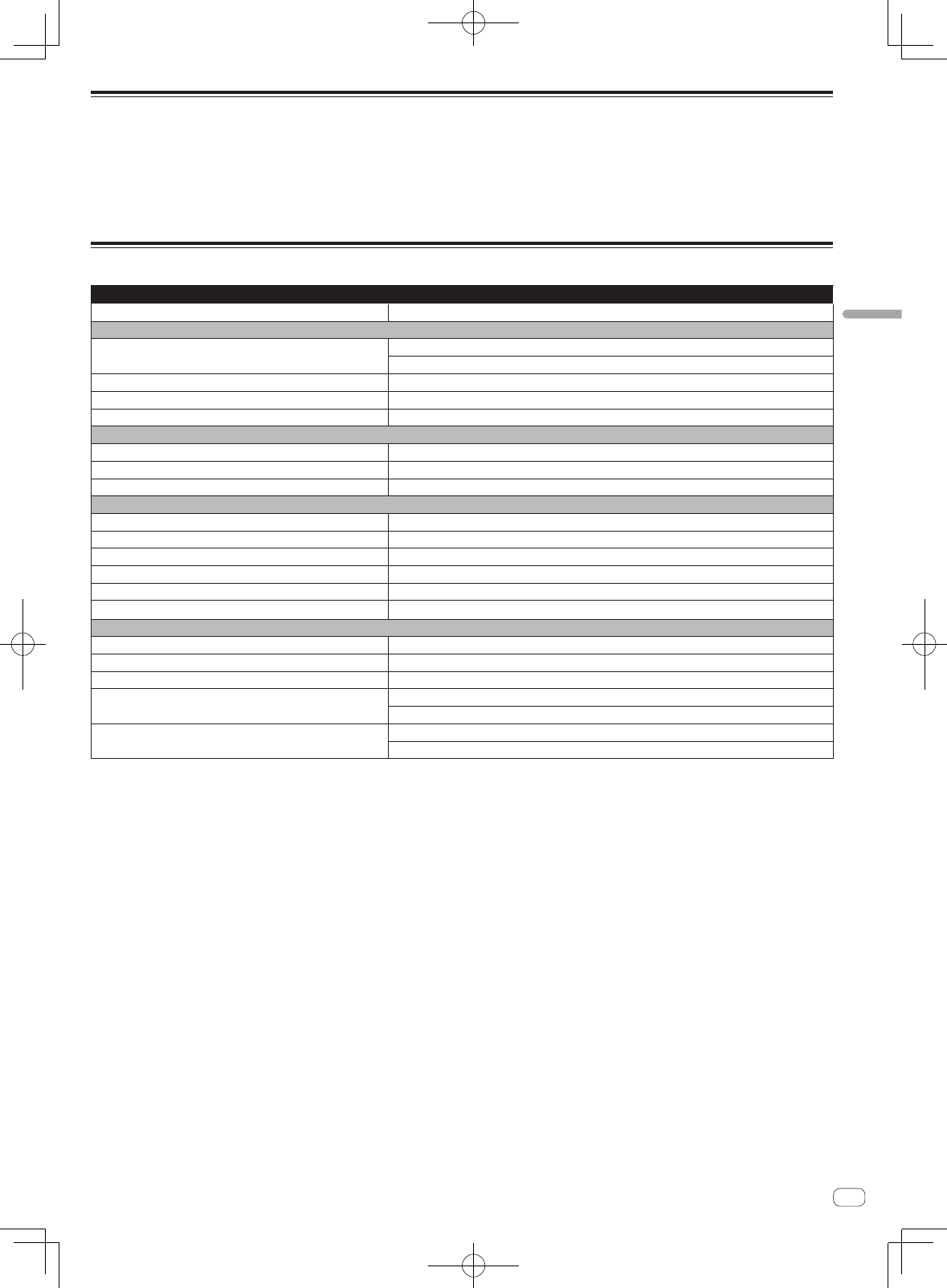
9
Über Markenzeichen und eingetragene Markenzeichen
! “Pioneer DJ” ist ein Markenzeichen der PIONEER CORPORATION und wird unter Lizenz verwendet.
! Die hier erwähnten Produkt- oder Firmennamen sind Marken oder eingetragene Marken der jeweiligen Eigentümer.
! Die Bluetooth®-Wortmarke und Logos sind registrierte Marken der Bluetooth SIG, Inc. und jegliche Verwendung dieser Marken durch die PIONEER
DJ Corporation erfolgt unter Lizenz. Andere Marken und Markennamen sind das Eigentum ihrer jeweiligen Inhaber.
! Qualcomm aptX ist ein Produkt der Qualcomm Technologies International, Ltd. Qualcomm ist eine Marke der Qualcomm Incorporated, die in den
USA und anderen Ländern registriert ist und mit Genehmigung verwendet wird. aptX ist eine Marke der Qualcomm Technologies International,
Ltd., die in den USA und anderen Ländern registriert ist und mit Genehmigung verwendet wird.
Technische Daten
DM-40BT/DM-40BT-W
Modell 2-Wege-Aktivlautsprecher
Verstärkerbereich
Verstärkerausgang Linker Kanal: 21 W/4 W, Klasse AB
Rechter Kanal: 21 W/4 W, Klasse AB
Eingangsbuchsen RCA × 1, 3,5 mm-Stereo-Miniklinkenstecker × 1
Eingangsimpedanz 10 kW
Ausgangsbuchsen Kopfhörer × 1
Lautsprecherbereich
Gehäuse Bassreflex/Vinyllaminiertes MDF
Subwoofer (LF-Treiber) 4 Zoll-Konus (102 cm)
Hochtöner (HF-Treiber) 3/4 Zoll-Weichkalotte (19 mm)
Bluetooth-Bereich
Version Bluetooth Spezifikation Ver. 4.2
Output Bluetooth Spezifikation Klasse 2
Verwendete Frequenz 2,4 GHz
Einstellung FH-SS (Frequenzsprungverfahren)
Unterstützte Bluetooth-Profile A2DP, AVRCP
Unterstützter Kodierer-Dekodierer SBC, AAC, Qualcomm® aptX™, Qualcomm® aptX™ mit niedriger Latenz
Stromversorgungsbereich/Sonstiges
Unterstützte Spannungen 110 V bis 240 V Wechselspannung, 50 Hz/60 Hz
Leistungsaufnahme 35 W
Leistungsaufnahme im Standby-Betrieb 0,3 W
Außenabmessungen B x H x T Linker Kanal: 146 mm × 227 mm × 223 mm
Rechter Kanal: 146 mm × 227 mm × 210 mm
Gewicht Linker Kanal: 2,7 kg
Rechter Kanal: 2,2 kg
! Änderungen der technischen Daten und das Design dieses Geräts ohne vorherige Ankündigung bleiben vorbehalten.
! © 2017 Pioneer DJ Corporation. Alle Rechte vorbehalten.
De
Deutsch
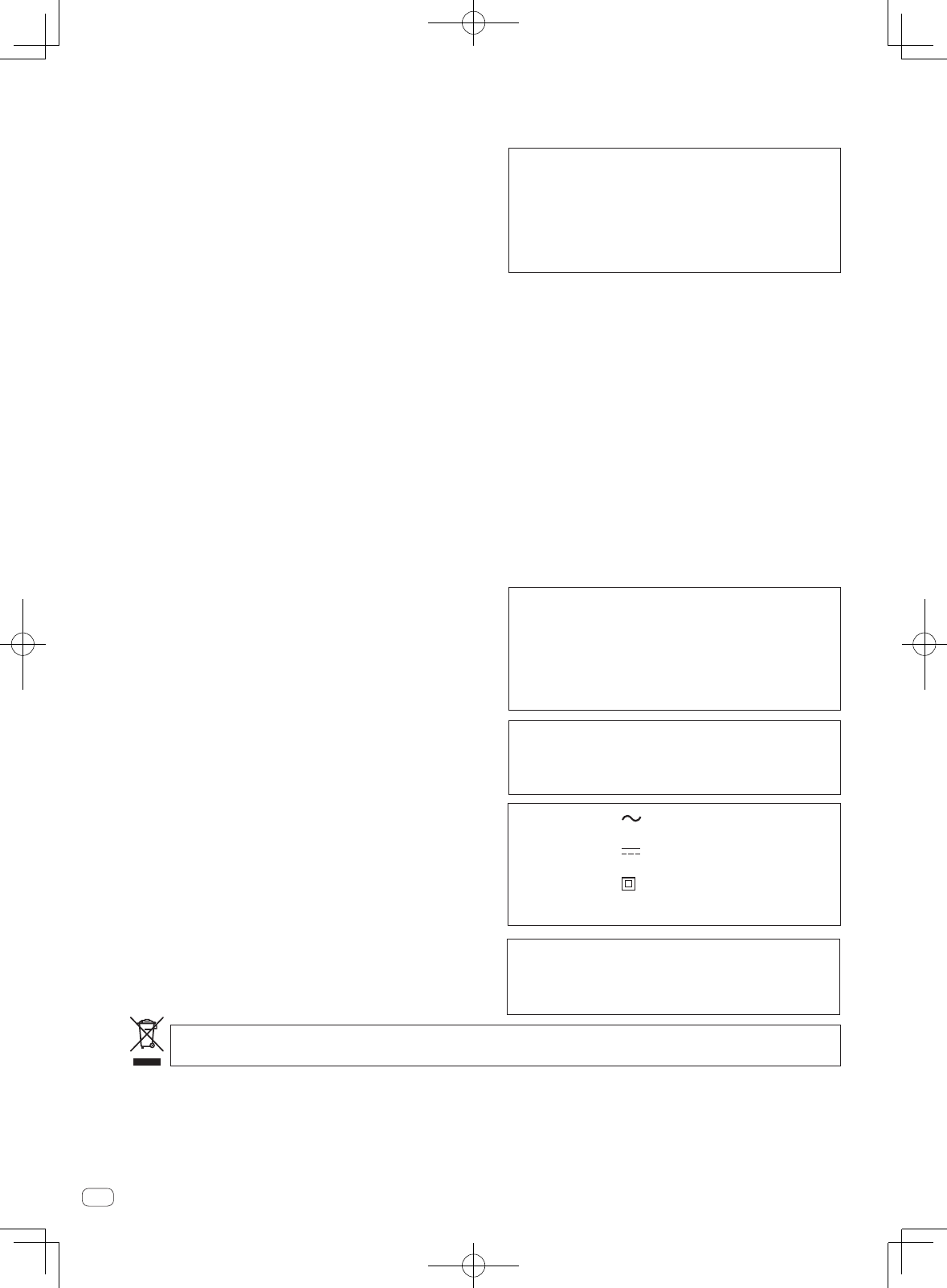
It
2
Vi ringraziamo per avere acquistato questo prodotto Pioneer DJ.
Vi
preghiamo di leggere queste queste istruzioni per l’uso in modo da sapere usare correttamenteil proprio modello.
Dopo aver letto queste istruzioni, riporle in un luogo sicuro per poterle consultare di nuovo al momento del bisogn
o.
ATTENZIONE
PER EVIT
ARE IL RISCHIO DI SCOSSE ELETTRICHE,
NON RIMUOVERE IL COPERCHIO (O IL RETRO). NON
CI SONO P
ARTI INTERNE LA CUI MANUTENZIONE
POSSA ESSERE EFFET
TUATA DALL’UTENTE. IN CASO
DI NECESSITÀ, RIVOLGERSI ESCL
USIVAMENTE A
PERSONALE DI SERVIZIO QU
ALIFICATO.
D3-4-2-1-1_B2_It
ATTENZIONE
Questo apparecchio non è impermeabile.
Per prevenire
pericoli di incendi o folgorazioni, non posizionare nelle
vicinanze di questo apparecchio contenitori pieni di
liquidi (quali vasi da fiori, o simili), e non esporre
l’apparecchio a sgocciolii, schizzi, pioggia o umidità.
D3-4-2-1-3_A1_It
ATTENZIONE
Pe
r evitare il pericolo di incendi, non posizionare
sull’apparecchio dispositivi con fiamme vive (ad
esempio una candela accesa, o simili)
.
D3-4-2-1-7a_A1_It
Condizioni ambientali di funzionamento
Gamma ideale della temperatura ed umidità
dell’ambiente di funzionamento:
da +5 °C a +35 °C, umidità relativa inferiore all‘85 %
(fessure di ventilazione non bloccate
)
Non installare l’apparecchio in luoghi poco ventilati, o
in luoghi esposti ad alte umidità o alla diretta luce del
sole (o a sorgenti di luce artificiale molto forti)
.
D3-4-2-1-7c*_A1_It
AVVER
TENZA PER LA VENTILAZIONE
Installare l’apparecchio avendo cura di lasciare un
certo spazio all’intorno dello stesso per consentire una
adeguata circolazione dell’aria e migliorare la
dispersione del calore (almeno 15 cm sulla parte
superiore, 15 cm sul retr
o, e 15 cm su ciascuno dei lati).
D3-4-2-1-7d*_A1_It
Questo prodotto è destinato esclusivamente all'uso
domestico. Eventuali disfunzioni dovute ad usi diversi
(quali uso prolungato a scopi commerciali, in
ristoranti, o uso in auto o su navi) e che richiedano
particolari riparazioni, saranno a carico dell'utente,
anche se nel corso del periodo di garanzia.
K041_A1_It
Se si vuole eliminare questo prodotto, non gettarlo insieme ai rifiuti domestici. Esiste un sistema di raccolta differenziata in conformità
alle leggi che richiedono appositi trattamenti, recupero e riciclo.
I privati cittadini dei paesi membri dell’UE, di Svizzera e Nor
vegia, possono restituire senza alcun costo i loro prodotti elettronici usati ad appositi
ser
vizi di raccolta o a un rivenditore (se si desidera acquistarne uno simile).
Pe
r i paesi non citati qui sopra, si prega di prendere contatto con le autorità locali per il corretto metodo di smaltimento.
In questo modo
, si è sicuri che il proprio prodotto eliminato subirà il trattamento, il recupero e il riciclo necessari per prevenire gli effetti
potenzialmente negativi sull’ambiente e sulla vita dell’uomo
.
K058b_A1_It
AVVERTIMENTO RIGUARDANTE IL FILO DI
ALIMENTAZIONE
Prendete sempre il filo di alimentazione per la spina.
Non tiratelo mai agendo per il filo stesso e non toccate
mai il filo con le mani bagnati, perchè questo potrebbe
causare cortocircuiti o scosse elettriche. Non collocate
l’unità, oppure dei mobili sopra il filo di alimentazione e
controllate che lo stesso non sia premuto. Non
annodate mai il filo di alimentazione nè collegatelo con
altri fili. I fili di alimentazione devono essere collocati in
tal modo che non saranno calpestati. Un filo di
alimentazione danneggiato potrebbe causare incendi o
scosse elettriche. Controllate il filo di alimentazione
regolarmente. Quando localizzate un eventuale danno,
rivolgetevi al più vicino centro assistenza oppure al
vostro rivenditore per la sostituzione del filo di
alimentazione.
S002*_A1_It
Precauzioni per i modelli DM-40BT/DM-40BT-W
Non collegate questo altoparlante ad un
amplificatore che non sia quello fornito assieme a
questo sistema. Il collegamento con amplificatori di
altro tipo può risultare in malfunzionamenti o
incendi.
SGK006*_A1_It
Non applicare questi diffusori ad un muro o al
soffitto, dato che possono causare ferimenti in caso
di caduta.
SGK007_A1_It
ATTENZIONE
L
’apparecchio è dotato di un certo numero di fessure e
di aperture per la ventilazione, allo scopo di garantirne
un funzionamento affidabile, e per proteggerlo dal
surriscaldament
o. Per prevenire possibili pericoli di
incendi le aperture non devono mai venire bloccate o
coperte con oggetti vari (quali giornali, tovaglie, tende o
tendaggi, ecc.), e l’apparecchio non deve essere
utilizzato appoggiandolo su tappeti spessi o sul letto
.
D3-4-2-1-7b*_A1_It
Il simbolo grafico stampigliato sul prodotto
significa corrente alternata.
Il simbolo grafico stampigliato sul prodotto
significa corrente continua.
Il simbolo grafico stampigliato sul prodotto
significa apparecchio di Classe II.
D3-8-2-4_A1_It
AVVERTENZA
Questo prodotto è stato collaudato in condizioni di
clima moderato.
D3-8-2-1-7b_A1_It
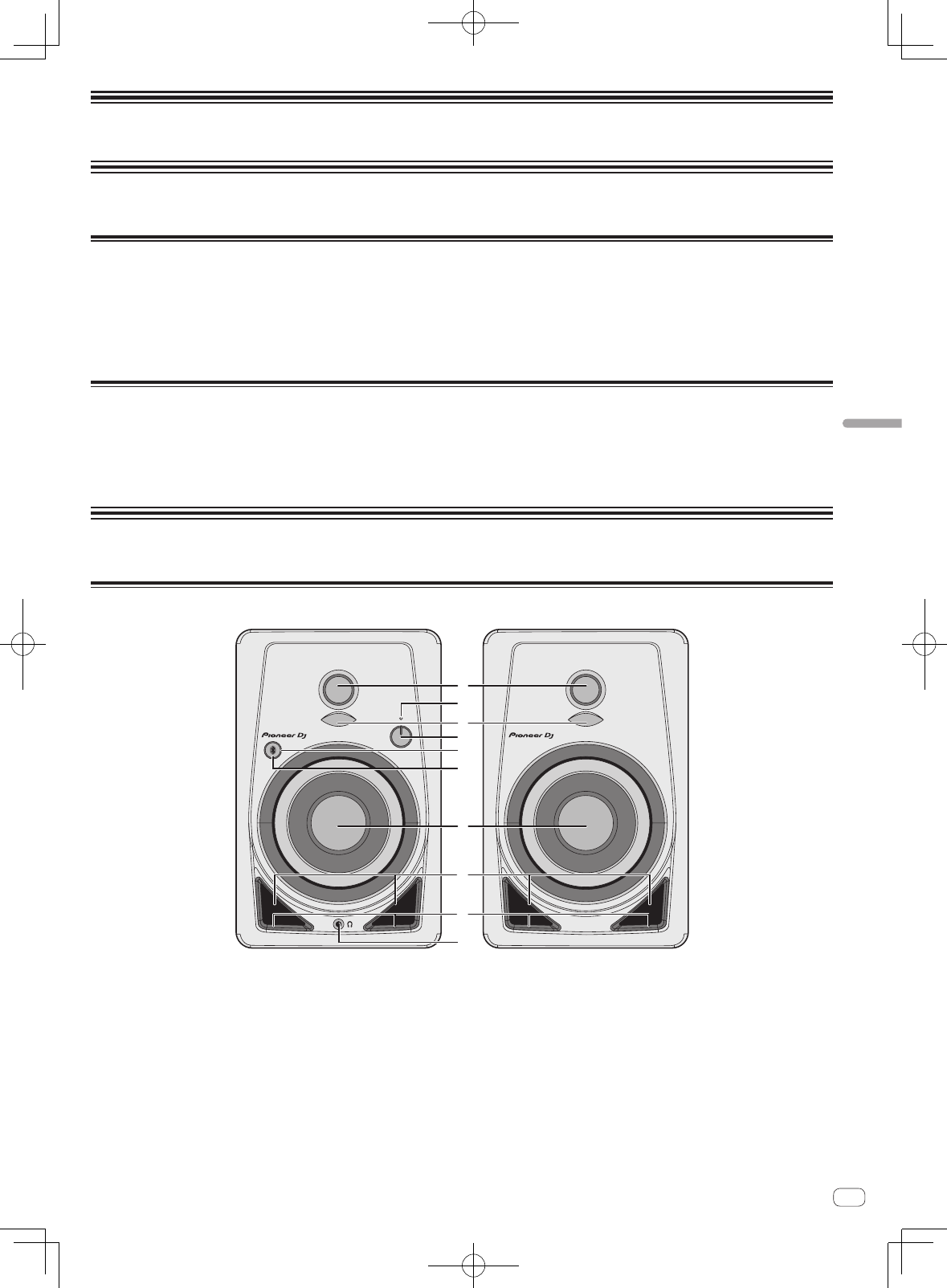
It 3
Italiano
Da leggere prima dell’uso (Importante)
Prima di cominciare
Caratteristiche
! Un condotto bass reflex nella parte anteriore unito alla tecnologia Groove per una grande potenza sonora dei kick.
! La nuova forma a guida d’onda del diffusore convesso migliora la direttività acustica delle alte frequenze e offre una sonorità spaziosa.
! Nonostante le sue dimensioni compatte da scrivania, offre bassi profondi e una qualità sonora più chiara.
! Compatibile con la codifica AAC e la tecnologia Qualcomm® aptX™ per una riproduzione audio di migliore qualità utilizzando l’interfaccia
Bluetooth.
! Un pulsante di accoppiamento sul pannello anteriore consente di eseguire l’accoppiamento con un unico tocco.
Controllo degli accessori
! Cavo di alimentazione x1
! Istruzioni per l’uso (questo documento)
! Cavo adattatore audio (da spina mini stereo da 3,5 mm a RCA) x1
! Cavo diffusore x1
! Cuscinetti per la base x8
Nomi e funzioni delle parti
Pannello anteriore
1
2
3
4
7
8
9
a
5
6
1 Tweeter a cupola morbidi da 3/4 di pollice
2 Indicatore POWER
L’illuminazione è collegata all’attivazione/disattivazione dell’alimen-
tazione. L’indicatore è spento in stato di standby.
3 Diffusori
Migliorano la direttività delle frequenze alte dell’audio e conferiscono
spazialità al suono.
4 Controllo LEVEL
Regola il volume.
5 Pulsante di accoppiamento
Esegue l’accoppiamento con un dispositivo Bluetooth.
Questo pulsante esegue inoltre le operazioni di messa in pausa e
riproduzione durante la riproduzione musicale tramite Bluetooth. Per
dettagli, vedere “Ascolto della musica trasmessa da un dispositivo
Bluetooth” (pagina 6).
6 Indicatore di accoppiamento (pagina 6)
Lampeggiante: Operazione di accoppiamento in corso o in attesa di
collegamento
Acceso: Collegamento stabilito con il dispositivo Bluetooth
7 Woofer in fibra di vetro da 4 pollici
8 Canali bass reflex
9 Scanalature
Regolano il flusso dell’aria dei canali bass reflex per irradiare le
frequenze basse in modo più fluido.
a Terminale per cuffie
Terminale di uscita tipo spina mini stereo da 3,5 mm.
Quando si collegano le cuffie, il suono trasmesso dai diffusori viene
silenziato e l’audio viene trasmesso esclusivamente dalle cuffie.
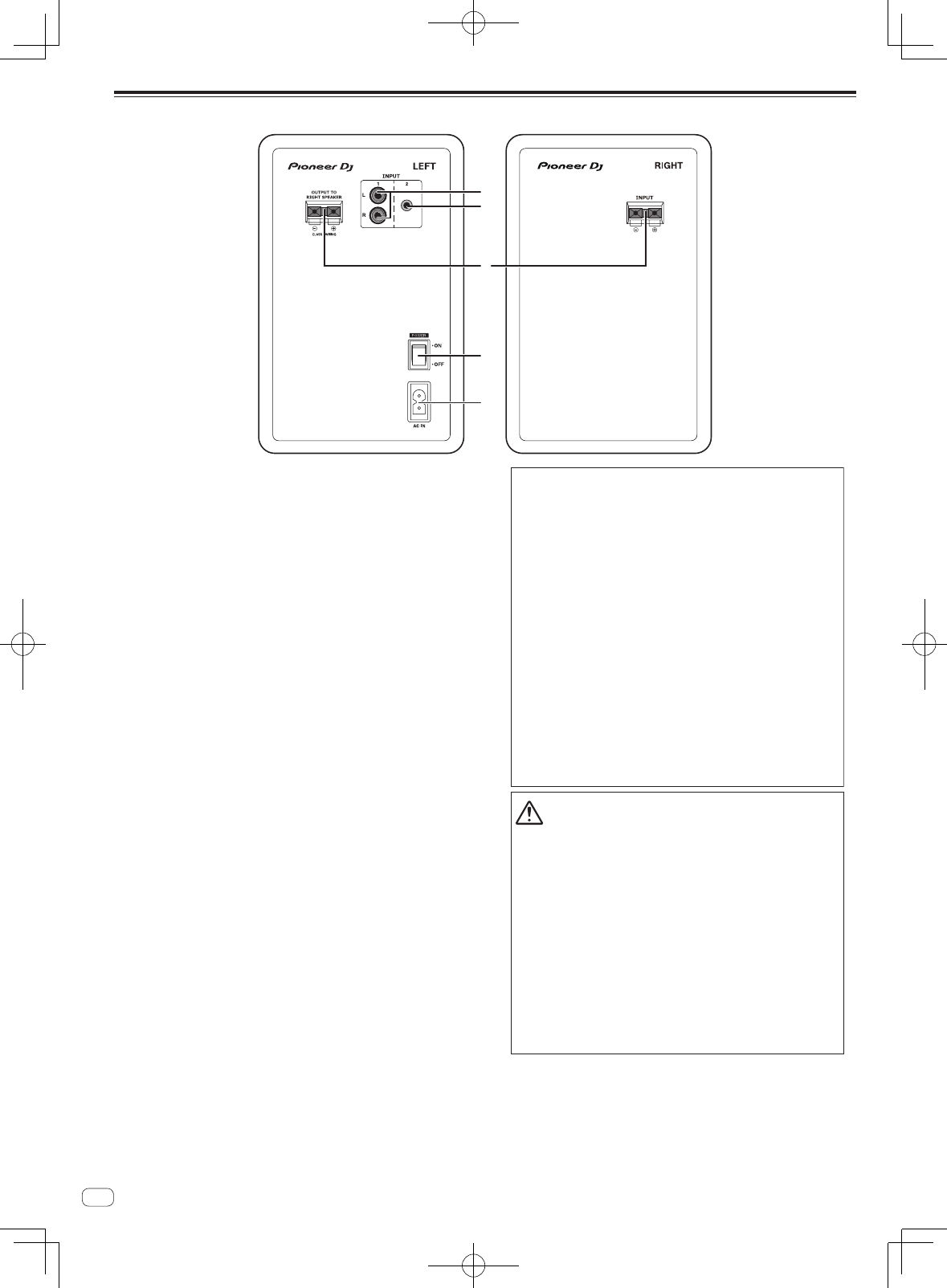
It
4
Pannello posteriore
2
4
5
1
3
1 Terminali INPUT 1 (stereo)
Terminali di ingresso non bilanciati a spinotto RCA.
2 Terminali INPUT 2 (stereo)
Terminale di ingresso non bilanciato tipo spina mini stereo da 3,5
mm.
3 Connettori di collegamento dei diffusori
Collegare i diffusori sinistro e destro utilizzando i cavi acclusi.
Non collegare i diffusori a un amplificatore diverso da quello di que-
sto sistema. Altrimenti, potrebbero verificarsi danni o incendi.
4 Interruttore POWER
Accende e spegne questa unità.
5 AC IN
Collegare il cavo di alimentazione al connettore AC IN e quindi alla
presa di corrente.
Collegare il cavo di alimentazione dopo che tutti i collegamenti fra
dispositivi sono stati fatti.
Usare solo il cavo di alimentazione accluso.
AVVERTENZA
L’interruttore principale (POWER) dell’apparecchio
non stacca completamente il flusso di corrente
elettrica dalla presa di corrente alternata di rete. Dal
momento che il cavo di alimentazione costituisce
l’unico dispositivo di distacco dell’apparecchio dalla
sorgente di alimentazione, il cavo stesso deve essere
staccato dalla presa di corrente alternata di rete per
sospendere completamente qualsiasi flusso di
corrente. Verificare quindi che l’apparecchio sia stato
installato in modo da poter procedere con facilità al
distacco del cavo di alimentazione dalla presa di
corrente, in caso di necessità. Per prevenire pericoli
di incendi, inoltre, il cavo di alimentazione deve
essere staccato dalla presa di corrente alternata di
rete se si pensa di non utilizzare l’apparecchio per
periodi di tempo relativamente lunghi (ad esempio,
durante una vacanza).
D3-4-2-2-2a*_A1_It
ATTENZIONE
!Questo prodotto è dotato di una funzione di standby
automatico. Se l’assenza di audio continua per il periodo
predefinito (circa 30 minuti) durante l’uso, il prodotto
disattiva automaticamente l’indicatore POWER e passa
automaticamente in stato di standby con basso consumo
energetico, indipendentemente da se il collegamento
Bluetooth è attivo.
!Se il prodotto passa in stato di standby con il collegamento
Bluetooth attivo, il collegamento Bluetooth viene disattivato
e l’indicatore Bluetooth si spegne.
!Se dai terminali di ingresso viene ricevuto segnale audio
mentre i diffusori sono in stato di standby, il prodotto si
riaccende automaticamente. Inoltre, il prodotto si riaccende
se durante lo stato di standby si preme il pulsante di
accoppiamento Bluetooth.
!Non è possibile disattivare questa funzione di standby
automatico.
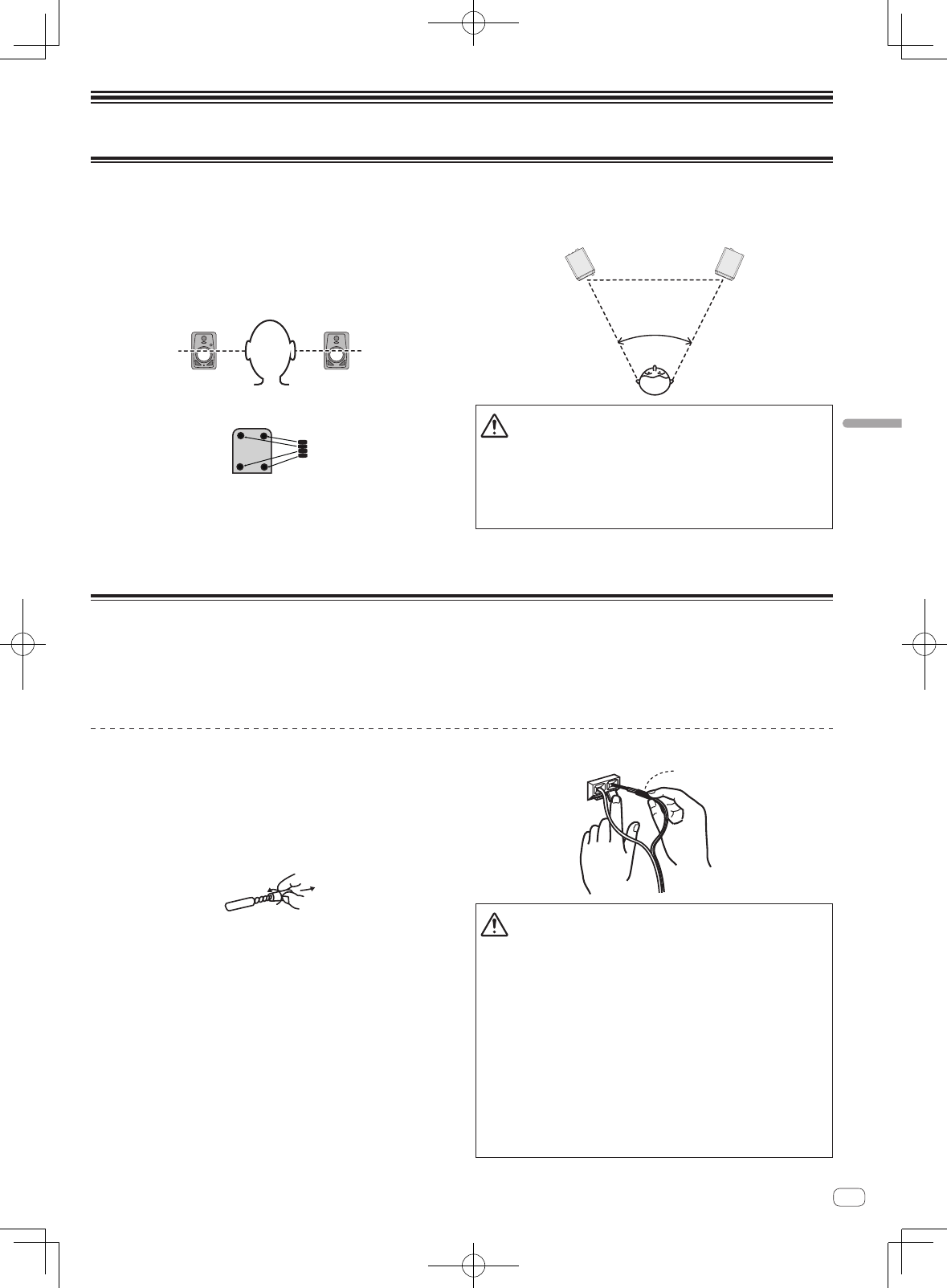
It 5
Italiano
Installazione e collegamenti
Procedura di installazione
La riproduzione di un diffusore viene influenzata dalle condizioni pre-
senti nella stanza di ascolto. Per ottenere condizioni di ascolto ottimali,
tenere in considerazione le caratteristiche di ambiente prima di ini-
ziare l’installazione.
! Posizionare i diffusori a livello degli orecchi.
! Per ottenere un effetto stereo naturale, installare i diffusori di sinistra
e destra in posizioni simmetriche ed equidistanti dalla posizione di
ascolto.
! Applicare i cuscinetti in dotazione nella parte inferiore dell’unità per
prevenire gli scivolamenti.
ATTENZIONE
Conser
vare i piccoli ricambi fuori dalla portata dei
bambini e dei bebé. Se inghiottiti accidentalmente,
recarsi immediatemente dal medico
.
D41-6-4_A1_It
! Installare i diffusori rivolti verso l’interno, con un’angolazione totale
di 60 gradi rispetto alla posizione di ascolto, ottenuta angolando di
30 gradi i diffusori destro e sinistro.
50 ° a 60 °
ATTENZIONE
Per agevolare il corretto raffreddamento, assicurarsi di riservare spa-
zio sufficiente tra i diffusori e le pareti circostanti o gli altri componenti
(minimo 15 cm in alto, indietro, e sul lato destro e sinistro di ciascun
diffusore). Se non si lascia spazio insufficiente tra i diffusori e le pareti
o gli altri componenti, le temperature interne potrebbero salire ecces-
sivamente, provocando malfunzionamenti o danni.
Collegamenti
! Prima di fare o modificare collegamenti, non mancare di spe-
gnere l’apparecchio e di scollegare il cavo di alimentazione.
! Consultare le istruzioni per l’uso del componente da collegare.
! Collegare il cavo di alimentazione dopo che tutti i collegamenti fra
dispositivi sono stati fatti.
! Usare solo il cavo di alimentazione accluso.
! Fare attenzione al volume perché i segnali ricevuti dai terminali
[INPUT 1] e [INPUT 2] e dall’interfaccia Bluetooth vengono missati.
Cavi di collegamento
Collegare i cavi di collegamento dei diffusori acclusi ai diffusori.
1 Incidere leggermente per circa 1 cm l’estremità dei
cavi per diffusori, ruotare e rimuovere il rivestimento
isolante.
Dopo aver rimosso il rivestimento isolante, attorcigliare con cura i fili
conduttori.
2 Collegare i cavi di collegamento dei diffusori acclusi ai
terminali dei diffusori sui lati SINISTRO e DESTRO.
3 Inserire i fili conduttori nei terminali mentre si tiene
premuto il fermo sui terminali dei diffusori.
Collegare il cavo del diffusore rigato di rosso al lato del terminale
+ (rosso) e il cavo del diffusore non rigato di rosso al lato del terminale
– (nero).
Rosso +
Nero
−
Rigato di rosso
ATTENZIONE
! Dopo aver collegato i terminali, tirare delicatamente i cavi dei
diffusori per accertarsi che le estremità dei cavi dei diffusori siano
saldamente collegate ai terminali. Un collegamento non saldo
potrebbe provocare interruzioni della trasmissione dell’audio o
emissione di rumore.
! Quando si collegano i cavi dei diffusori, attorcigliare con cura i
fili conduttori e accertarsi che i fili conduttori non sporgano dai
terminali dei diffusori. Se i fili conduttori sporgono dai terminali dei
diffusori, potrebbero entrare in contatto tra di loro o con il pannello
posteriore. Ciò potrebbe sottoporre l’amplificatore a carico ecces-
sivo, con possibili malfunzionamenti o interruzioni dell’audio.
! Se si provocano errori relativi alla polarità (+, –) sui lati SINISTRO
e DESTRO quando si collegano i cavi dei diffusori SINISTRO e
DESTRO, potrebbe non essere possibile ottenere il normale effetto
stereo.
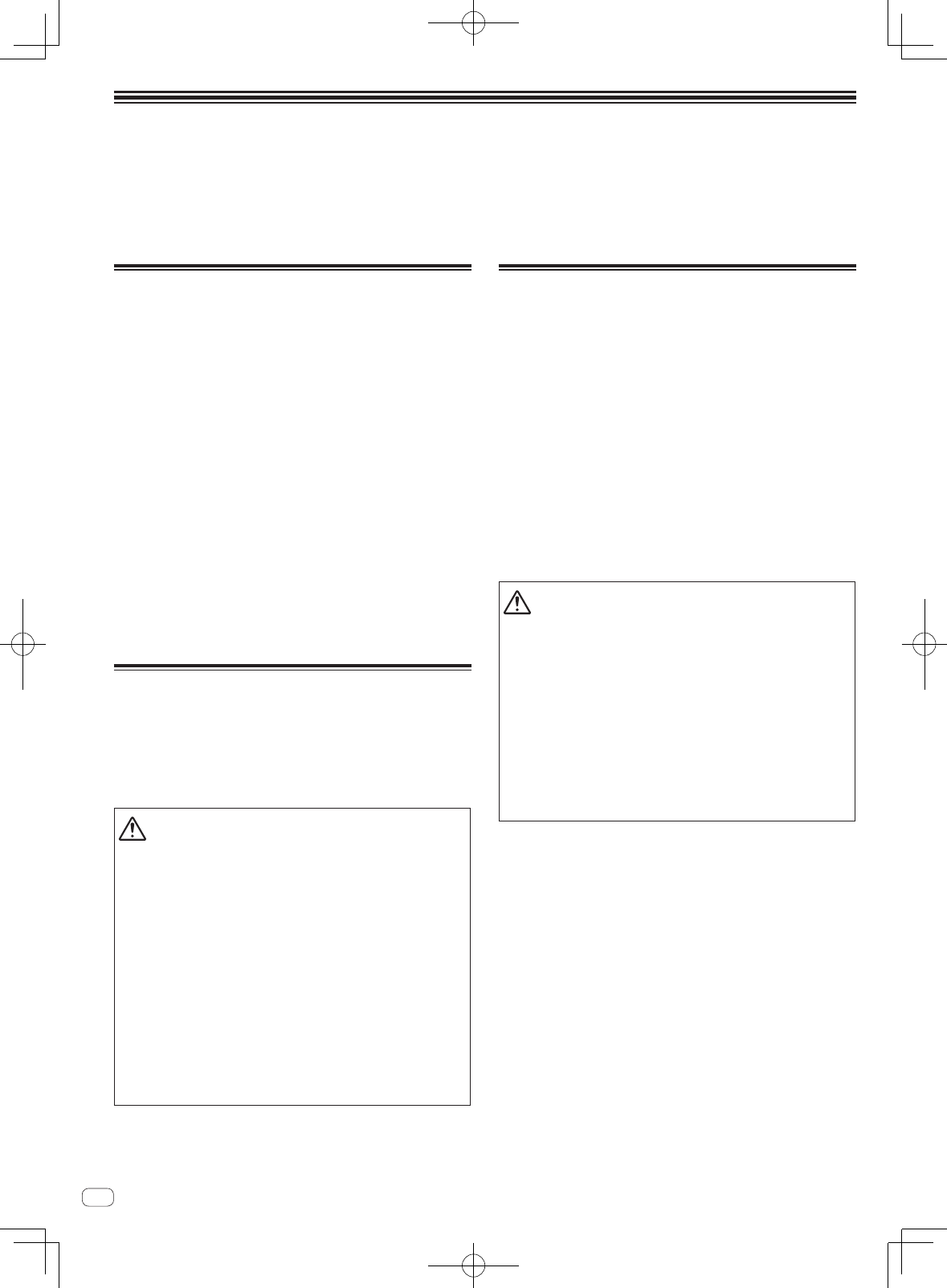
It
6
Ascolto della musica trasmessa da un
dispositivo Bluetooth
Questi diffusori consentono di ascoltare in wireless i brani salvati su un dispositivo Bluetooth.
Quando si utilizzano i diffusori per la prima volta o quando si collega un nuovo dispositivo Bluetooth ai diffusori, è necessario accoppiare i diffusori e il
dispositivo Bluetooth.
L’accoppiamento (la registrazione reciproca dei diffusori) è l’operazione necessaria per collegare il dispositivo Bluetooth ai diffusori.
Procedura di accoppiamento e
collegamento
1 Accendere l’interruttore [POWER] per
collegare l’alimentazione ai diffusori.
! L’indicatore Bluetooth lampeggia per circa 30 secondi e i diffusori
passano in stato di accoppiamento.
! Se l’indicatore Bluetooth è spento, premere il pulsante di accop-
piamento per almeno 2 secondi per passare nuovamente in stato di
accoppiamento.
2 Eseguire l’operazione di accoppiamento sul
dispositivo Bluetooth.
Eseguire l’operazione mentre i diffusori sono in stato di accoppiamento.
Per dettagli, vedere le istruzioni per l’uso del dispositivo Bluetooth.
3 Quando l’indicatore Bluetooth smette di lampeggiare
e rimane acceso costantemente, l’accoppiamento (il
collegamento) è completato.
Se non è possibile eseguire l’accoppiamento entro 30
secondi, l’indicatore Bluetooth smette di lampeggiare e si spegne.
! È possibile collegare un dispositivo Bluetooth già accoppiato
in precedenza eseguendo l’operazione dal lato del dispositivo
Bluetooth, se i diffusori sono accesi.
Riproduzione
Se si riproduce musica sul dispositivo Bluetooth collegato, la musica
viene trasmessa dai diffusori.
! Premendo il pulsante di accoppiamento sul dispositivo
Bluetooth durante la riproduzione della musica è possibile ese-
guire l’operazione di pausa/riproduzione (la stessa funzione eseguita
dal pulsante pausa/riproduzione del dispositivo Bluetooth).
ATTENZIONE
! Durante l’accoppiamento (collegamento), spostare il dispositivo
Bluetooth vicino ai diffusori.
! Al completamento del primo collegamento, l’audio potrebbe
essere emesso a volume eccessivo, pertanto si consiglia di
abbassare il volume prima della riproduzione.
! A seconda dell’applicazione utilizzata, l’operazione di pausa/ripro-
duzione potrebbe non essere possibile.
! A seconda del dispositivo Bluetooth, il collegamento dei diffusori
potrebbe non essere possibile.
! Se si desiderano accoppiare i diffusori a un dispositivo Bluetooth
diverso, disattivare la funzione Bluetooth del dispositivo Bluetooth
correntemente collegato o interrompere il collegamento prima di
eseguire l’operazione di accoppiamento.
! I diffusori memorizzano le informazioni sull’accoppiamento per
un massimo di otto dispositivi Bluetooth e cercano di collegarsi
all’ultimo dispositivo accoppiato se si preme il pulsante di accoppi-
amento quando i diffusori non sono collegati a nessun dispositivo
Bluetooth.
Avvertenza sulle onde radio
Questa unità impiega frequenze radio da 2,4 GHz, una banda di fre-
quenza usata da altri sistemi wireless (vedi la lista più oltre). Per pre-
venire i rumori o l’interruzione della comunicazione, non usare questa
unità vicino a simili dispositivi, oppure accertarsi che questi siano spenti
durante l’uso.
! Telefoni cordless
! Telefax cordless
! Forni a microonde
! Dispositivi LAN wireless (IEEE802.11b/g)
! Dispositivi AV wireless
! Controller wireless per sistemi per il gioco
! Attrezzature sanitarie a base di microonde
! Alcuni monitor piccoli
Altre attrezzature, meno comuni, che possono funzionare sulla stessa
frequenza:
! Sistemi antifurto
! Stazioni per radioamatori (HAM)
! Sistemi di gestione logistica per magazzini
! Sistemi di discriminazione per treni e veicoli di emergenza
ATTENZIONE
! Se l’immagine del televisore è disturbata, è possibile che un dispo-
sitivo Bluetooth® o questa unità (inclusi i prodotti supportati da
questa unità) causino interferenze di segnale col connettore d’in-
gresso dell’antenna del televisore, impianto video, sintonizzatore
satellitare, ecc. In tal caso, aumentare la distanza tra il connet-
tore d’ingresso dell’antenna e il dispositivo Bluetooth o questa
unità (inclusi i prodotti supportati da questa unità).
! Se un oggetto (ad esempio una porta in metallo, un muro in
cemento, o dell’isolamento contenente un foglio fra questa unità
in stagnola) dovesse ostacolare la trasmissione di segnale da
questa unità (compresi i dispositivi che essa supporta) ed il dis-
positivo dotato di tecnologia wireless Bluetooth, potrebbe essere
necessario cambiare la posizione del sistema per evitare i rumori e
le interruzioni.

It 7
Italiano
Modalità di uso
Questa unità è intesa per l’uso domestico. (Le distanze di trasmissione
possono ridursi in certi ambienti di comunicazione.) Nelle seguenti
posizioni, le condizioni di ricezione scadenti o l’impossibilità di ricevere
onde radio possono causare interruzioni parziali o complete dell’audio:
! In edifici in cemento armato o con travature in acciaio o ferro.
! Vicino a mobile in metallo di grandi dimensioni.
! In mezzo ad una folla o vicino ad un edificio o ostacolo.
! In una posizione esposta a campi magnetici, elettricità statica o
interferenze di frequenza radio da attrezzature per la comunicazione
radio che usino la stessa frequenza (2,4 GHz) usata da questa unità,
ad esempio un dispositivo LAN wireless da 2,4 GHz o un forno a
microonde.
! Se vivete in una zona densamente popolata (area di appartamenti,
di centro città, ecc.) e se il forno a microonde del vostro vicino si
trova vicino al vostro sistema, si possono sentire interferenze radio.
Se questo accade, installare questa unità in una posizione diversa.
Quando il forno a microonde non è in uso, non ci saranno interfer-
enze radio.
Onde radio riflesse
Le onde radio ricevute da questa unità includono le onde provenienti
direttamente da dispositivi dotati di tecnologia wireless Bluetooth
(onde dirette) ed onde provenienti da varie direzioni riflesse da pareti,
mobili ed edifici (onde riflesse). Le onde riflesse (da ostacoli ed oggetti
riflettenti) producono a loro volta altre onde riflesse, che causano una
ricezione differente in posizioni differenti. Se l’audio non viene ricevuto
correttamente a causa di questo fenomeno, provare a spostare il dis-
positivo dotato di tecnologia wireless Bluetooth. Tenere anche presente
che l’audio potrebbe interrompersi a causa delle onde riflesse quando
una persona attraversa o si avvicina allo spazio fra questa unità ed il
dispositivo dotato di tecnologia wireless Bluetooth.

It
8
Informazioni aggiuntive
Diagnostica
! A volte il problema risiede in un altro componente. Controllare tutti i componenti ed apparecchi elettronici usati. Se il problema non può venire
eliminato, chiedere assistenza tecnica al più vicino centro assistenza o rivenditore autorizzato Pioneer.
! Questa unità può non funzionare a causa di elettricità statica o altre influenze esterne. In tal caso, essa torna alla normalità scollegando il cavo di
alimentazione, attendendo 5 secondi o più, quindi ricollegando il cavo.
Problemi comuni
Problema Controllare Rimedio
L’apparecchio non è acceso. Il cavo di alimentazione è collegato correttamente? Collegare il cavo di alimentazione ad una presa di c.a.
Non viene emesso alcun suono dai dispo-
sitivi collegati o il volume è basso.
Il dispositivo collegato è configurato
correttamente? Configurare correttamente l’ingresso per il dispositivo esterno e il volume.
Il volume è in posizione corretta? Girare in senso orario il comando [LEVEL] sul pannello anteriore di questa
unità per aumentare il volume.
L’alimentazione è collegata? Premere l’interruttore [POWER] sul pannello posteriore del diffusore.
L’indicatore POWER (bianco) non si
accende.
L’alimentazione è collegata? Premere l’interruttore [POWER] sul pannello posteriore del diffusore.
I diffusori sono in stato di standby? Spegnere l’interruttore [POWER] sul pannello posteriore di questa unità e
quindi riaccenderlo dopo alcuni secondi.
L’unità non si riprende dallo stato di
standby (non si riaccende). Il livello del segnale in ingresso è troppo basso? Aumentare il livello del segnale in ingresso.
Audio distorto.
Il volume è in posizione corretta? Girare in senso antiorario il comando [LEVEL] sul pannello anteriore di
questa unità per ridurre il volume.
Il livello del segnale in ingresso dal dispositivo
collegato è corretto? Regolare il livello di uscita del dispositivo collegato.
Oscillazioni (viene emesso continua-
mente suono rumoroso). Il volume è in posizione corretta? Girare in senso antiorario il comando [LEVEL] sul pannello anteriore di
questa unità per ridurre il volume.
Il suono viene emesso solo dal diffusore
sinistro. I cavi dei diffusori sono collegati correttamente? Collegare correttamente i diffusori destro e sinistro.
I diffusori si spengono (passano in stato
di standby) automaticamente.
Non è stato emesso alcun suono continuamente
per il periodo predefinito (circa 30 minuti) o più?
Inviare segnale ai terminali di ingresso RCA o spina mini stereo.
Oppure premere il pulsante di accoppiamento sul pannello anteriore di
questa unità.
Il livello del segnale in ingresso è basso? Aumentare il livello del segnale in ingresso.
Quando i diffusori sono collegati tramite i terminali INPUT 1 o INPUT 2
Problema Controllare Rimedio
Non viene emesso alcun suono dai dispo-
sitivi collegati o il volume è basso.
I cavi di collegamento sono collegati
correttamente? Collegare correttamente i cavi di collegamento.
I terminali o gli spinotti sono sporchi? Pulire i terminali e gli spinotti prima di procedere con i collegamenti.
Il suono viene emesso solo da un
diffusore. Il dispositivo è collegato correttamente? Collegare il dispositivo ai terminali di ingresso sia destro che sinistro.
Il suono viene interrotto o si avverte
rumore.
Vi è un problema di contatto dei cavi di
collegamento? Ricollegare i cavi di collegamento.
Quando i diffusori sono collegati tramite interfaccia Bluetooth
Problema Controllare Rimedio
Non è possibile stabilire il collegamento
oppure il suono viene interrotto o si
avverte rumore.
Nelle vicinanze vi è un dispositivo che produce
onde elettromagnetiche nella banda di 2,4 GHz
(forno a microonde, dispositivo LAN wireless, altro
dispositivo Bluetooth, ecc.)?
Installare l’unità più lontano dal dispositivo o interrompere l’uso del disposi-
tivo che produce onde elettromagnetiche.
La distanza dal dispositivo Bluetooth è eccessiva?
Oppure tra il prodotto e il dispositivo si frappone
un muro o un ostacolo che blocca il segnale?
Avvicinare il dispositivo Bluetooth collegato e l’unità. Oppure modificare la
posizione del dispositivo Bluetooth rispetto all’unità.
Sul dispositivo Bluetooth è in esecuzione un’ap-
plicazione diversa da quella di riproduzione
musicale?
Sul dispositivo Bluetooth chiudere tutte le applicazioni tranne quella di
riproduzione musicale.
Il dispositivo Bluetooth che si desidera collegare
supporta i profili A2DP? Utilizzare un dispositivo Bluetooth che supporti i profili A2DP.
L’accoppiamento col dispositivo Bluetooth è stato
eseguito correttamente?
Spegnere e riaccendere questa unità e il dispositivo Bluetooth, quindi ese-
guire nuovamente l’accoppiamento.
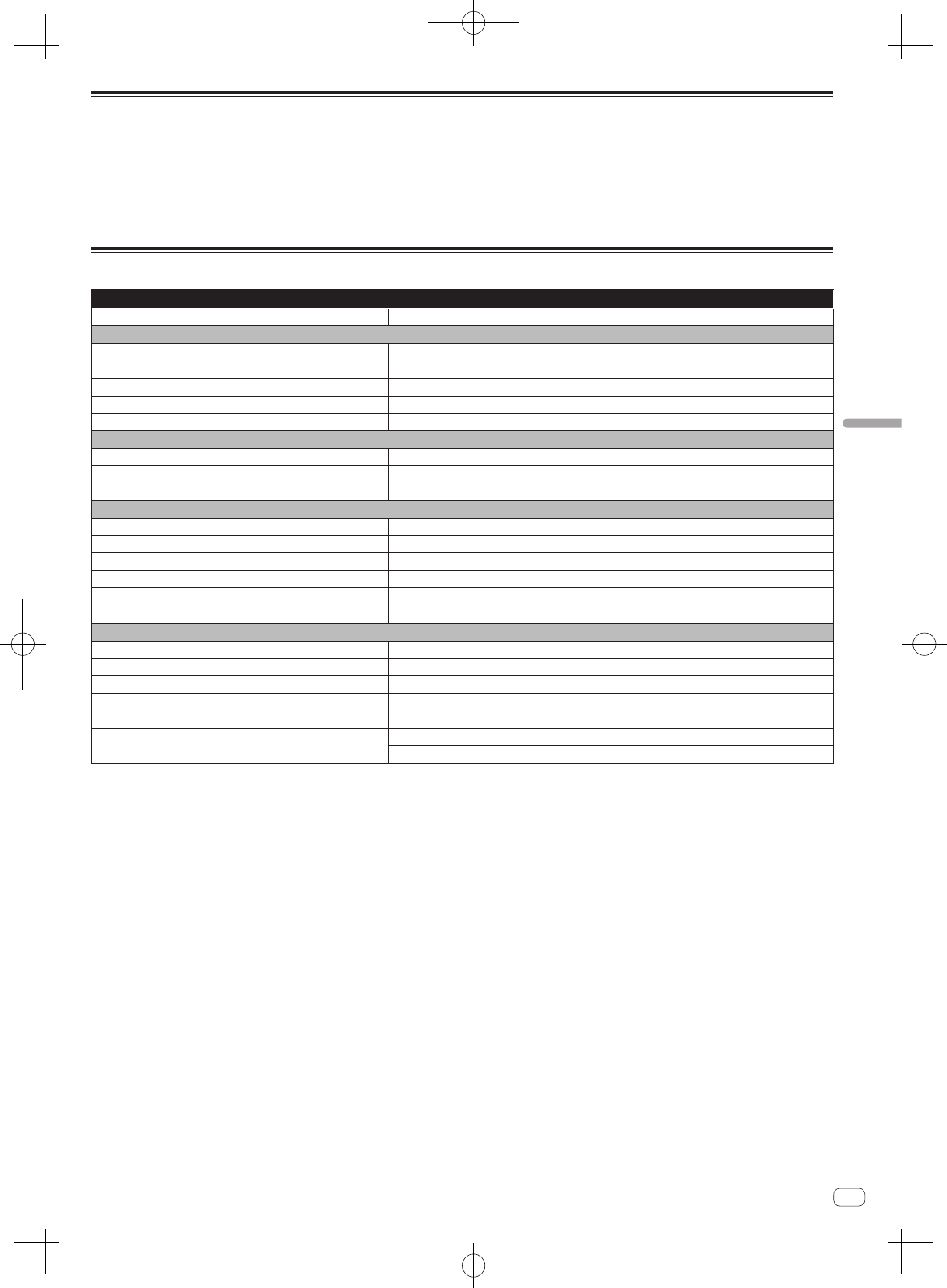
9
It
Italiano
A proposito del marchi di fabbrica o marchi di fabbrica depositati
! “Pioneer DJ” è un marchio di PIONEER CORPORATION e viene riportato su licenza.
! I nomi delle aziende e dei prodotti menzionati sono marchi di fabbrica o marchi di fabbrica depositati dei rispettivi proprietari.
! Il marchio nominale e i loghi Bluetooth® sono marchi registrati di proprietà di Bluetooth SIG, Inc. e sono utilizzati su licenza da PIONEER DJ
Corporation. Tutti gli altri marchi e nomi commerciali sono di proprietà dei rispettivi titolari.
! Qualcomm aptX è un prodotto di Qualcomm Technologies International, Ltd. Qualcomm è un marchio di Qualcomm Incorporated, registrato negli
Stati Uniti e in altri Paesi ed è utilizzato su licenza. aptX è un marchio di Qualcomm Technologies International, Ltd., registrato negli Stati Uniti e in
altri Paesi ed è utilizzato su licenza.
Dati tecnici
DM-40BT/DM-40BT-W
Modello Diffusore attivo a 2 vie
Sezione amplificatore
Potenza amplificatore C. Sx: 21 W/4 W, Classe AB
C. Dx: 21 W/4 W, Classe AB
Terminali di ingresso RCA × 1, spina mini stereo da 3,5 mm × 1
Impedenza di ingresso 10 kW
Terminali di uscita Cuffie × 1
Sezione diffusori
Cassa Tipo bass reflex/MDF in vinile laminato
Woofer (driver LF) Cono da 4 pollici (102 mm)
Tweeter (driver HF) Cupola morbida da 3/4 di pollice (19 mm)
Sezione Bluetooth
Versione Bluetooth versione specifica 4.2
Uscita Bluetooth Classe specifica 2
La frequenza utilizzata 2,4 GHz
Modulazione FH-SS (Espansione di spettro mediante il salto di frequenza)
Profili Bluetooth di supporto A2DP, AVRCP
Codificatore di supporto SBC, AAC, Qualcomm® aptX™, Qualcomm® aptX™ Bassa Latenza
Sezione alimentazione / altro
Tensioni supportate CA da 110 V a 240 V, 50 Hz/60 Hz
Consumo di corrente 35 W
Consumo di corrente in sospensione (in stato di standby) 0,3 W
Dimensioni esterne L × A × P C. Sx: 146 mm × 227 mm × 223 mm
C. Dx: 146 mm × 227 mm × 210 mm
Peso C. Sx: 2,7 kg
C. Dx: 2,2 kg
! I dati tecnici ed il design di questo prodotto sono soggetti a modifiche senza preavviso.
! © 2017 Pioneer DJ Corporation. Tutti i diritti riservati.
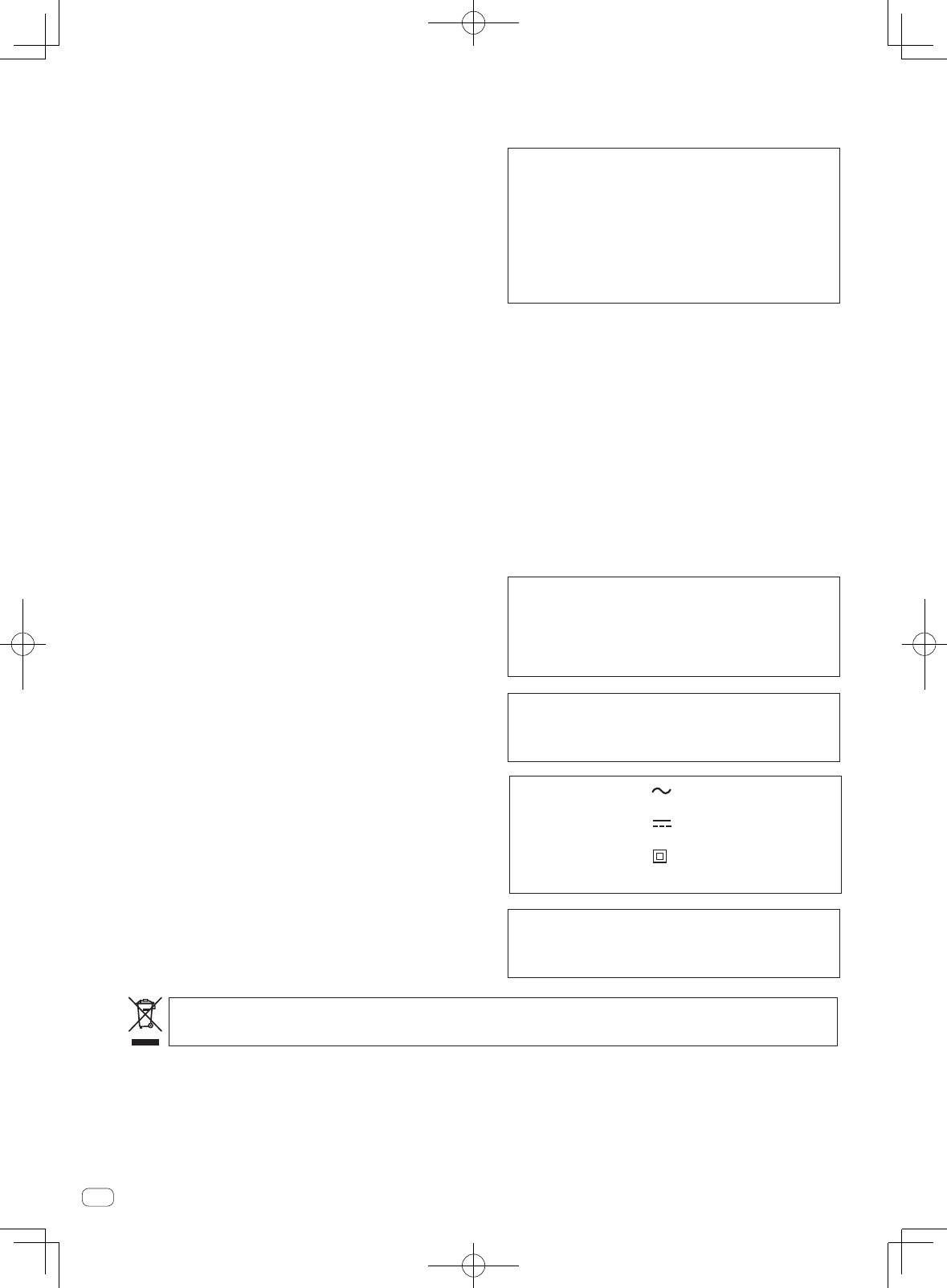
Nl
2
Hartelijk dank voor uw aankoop van dit Pioneer DJ product.
Lees deze gebruiksaanwijzing aandachtig door om bekend te raken met de juiste bedieningvan uw apparaat.
Na het doorlezen van de gebruiksaanwijzing dient u deze te bewaren op een veilige plaats, voor latere naslag.
LET OP
OM HET GEVAAR VOOR EEN ELEKTRISCHE SHOCK TE
VOORKOMEN, DEKSEL (OF RUG) NIET
VERWIJDEREN. AAN DE BINNENZIJDE BEVINDEN
ZICH GEEN ELEMENTEN DIE DOOR DE GEBRUIKER
KUNNEN BEDIEND WORDEN. ENKEL DOOR
GEKWALIFICEERD PERSONEEL TE BEDIENEN.
D3-4-2-1-1_B2_Nl
WAARSCHUWIN
G
Dit apparaat is niet waterdicht. Om brand of een
elektrische schok te voor
komen, mag u geen voorwerp
dat vloeistof bevat in de buurt van het apparaat zetten
(bijvoorbeeld een bloemenvaas) of het apparaat op
andere wijze blootstellen aan waterdruppels,
opspattend water
, regen of vocht.
D3-4-2-1-3_A1_Nl
WAARSCHUWIN
G
Om brand te voor
komen, mag u geen open vuur (zoals
een brandende kaars) op de apparatuur zette
n.
D3-4-2-1-7a_A1_Nl
Gebruiksomgeving
Te
mperatuur en vochtigheidsgraad op de plaats van
gebruik:
+5 °C tot +35 °C, minder dan 85 % RH
(ventilatieopeningen niet afgedekt
)
Zet het apparaat niet op een slecht geventileerde plaats
en stel het apparaat ook niet bloot aan hoge
vochtigheid of direct zonlicht (of sterke kunstmatige
verlichting)
.
D3-4-2-1-7c*_A1_Nl
BELANGRIJKE INFORMATIE BETREFFENDE
DE VENTILATI
E
Let er bij het installeren van het apparaat op dat er
voldoende vrije ruimte rondom het apparaat is om een
goede doorstroming van lucht te waarborgen
(tenminste 15 cm boven
, 15 cm achter en 15 cm aan de
zijkanten van het apparaat).
D3-4-2-1-7d*_A1_Nl
Dit apparaat is bestemd voor normaal huishoudelijk
gebruik. Indien het apparaat voor andere doeleinden
of op andere plaatsen wordt gebruikt (bijvoorbeeld
langdurig gebruik in een restaurant voor zakelijke
doeleinden, of gebruik in een auto of boot) en als
gevolg hiervan defect zou raken, zullen de reparaties
in rekening gebracht worden, ook als het apparaat
nog in de garantieperiode is.
K041_A1_Nl
Deponeer dit product niet bij het gewone huishoudelijk afval wanneer u het wilt verwijderen. Er bestaat een speciaal wettelijk
voorgeschreven verzamelsysteem voor de juiste behandeling, het opnieuw bruikbaar maken en de recycling van gebruikte
elektronische producten.
In de lidstaten van de EU, Zwitserland en Noor
wegen kunnen particulieren hun gebruikte elektronische producten gratis bij de daarvoor
bestemde ver
zamelplaatsen of een verkooppunt (indien u aldaar een gelijkwaardig nieuw product koopt) inleveren.
Indien u zich in een ander dan bovengenoemd land bevindt kunt u contact opnemen met de plaatselijke overheid voor informatie ov
er de juiste
ver
wijdering van het product.
Zodoende zorgt u er
voor dat het verwijderde product op de juiste wijze wordt behandeld, opnieuw bruikbaar wordt gemaakt, t gerecycleerd en het
niet schadelijk is voor de gezondheid en het milieu.
K058b_A1_Nl
WAARSCHUWING NETSNOER
Pak het netsnoer beet bij de stekker. Trek de stekker er
niet uit door aan het snoer te trekken en trek nooit aan
het netsnoer met natte handen aangezien dit
kortsluiting of een elektrische schok tot gevolg kan
hebben. Plaats geen toestel, meubelstuk o.i.d. op het
netsnoer, en klem het niet vast. Maak er nooit een
knoop in en en verbind het evenmin met andere
snoeren. De netsnoeren dienen zo te worden geleid dat
er niet per ongeluk iemand op gaat staan. Een
beschadigd netsnoer kan brand of een elektrische
schok veroorzaken. Kontroleer het netsnoer af en toe.
Wanneer u de indruk krijgt dat het beschadigd is, dient
u bij uw dichtstbijzijnde onderhoudscentrum of uw
dealer een nieuw snoer te kopen. S002*_A1_Nl
Voorzorgen voor de DM-40BT/DM-40BT-W
Verbind deze luidspreker niet met een andere dan de
bijgeleverde versterker. Het verbinden met een
andere versterker resulteert in een onjuist
funktioneren en mogelijk brand.
SGK006*_A1_Nl
Bevestig de luidspreker niet aan de muur of het
plafond, want dan kan de luidspreker letsel
veroorzaken als deze zou vallen.
SGK007_A1_Nl
WAARSCHUWING
De gleuven en openingen in de behuizing van het
apparaat zijn aangebracht voor de ventilatie, zodat een
betrouwbare werking van het apparaat wordt verkregen
en oververhitting wordt voorkomen. Om brand te
voorkomen, moet u ervoor zorgen dat deze openingen
nooit geblokkeerd worden of dat ze afgedekt worden
door voorwerpen (kranten, tafelkleed, gordijn e.d.) of
door gebruik van het apparaat op een dik tapijt of een
bed. D3-4-2-1-7b*_A1_Nl
Het grafische symbool op het product betekent
wisselstroom.
Het grafische symbool op het product betekent
gelijkstroom.
Het grafische symbool op het product betekent
apparatuur van klasse II. D3-8-2-4_A1_Nl
LET OP
Dit product is beoordeeld onder omstandigheden van
een gematigd klimaat.
D3-8-2-1-7b_A1_Nl
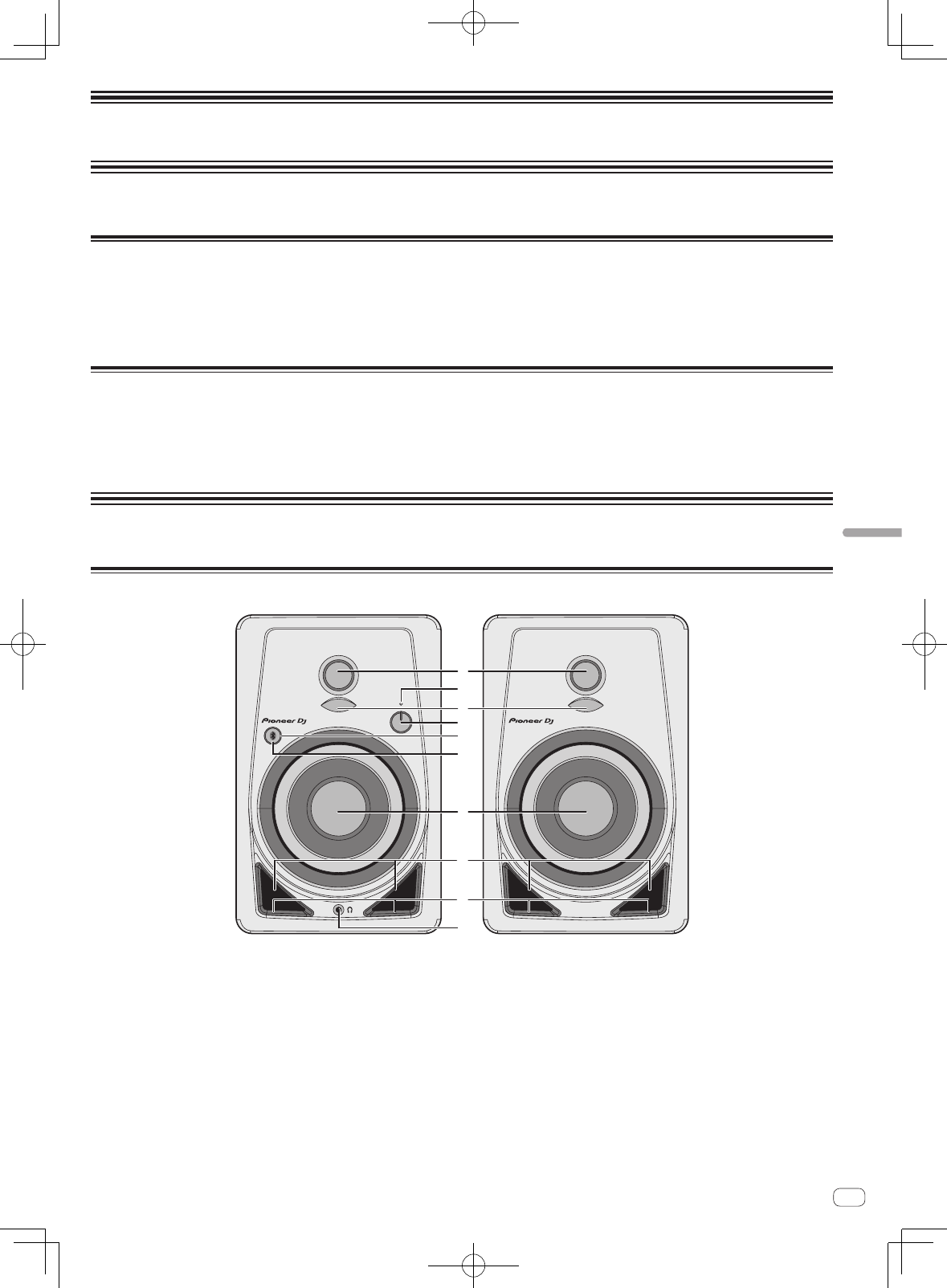
Nl 3
Nederlands
Lees dit voor gebruik (Belangrijk)
Alvorens te beginnen
Kenmerken
! Krachtig kickgeluid dankzij een basreflexkanaal aan de voorkant en de groeftechnologie.
! Betere directionaliteit van hoge frequenties en ruimtelijk geluid door een convexe diffusor op een nieuw gevormde golfpijp.
! Rijk basgeluid en heldere geluidskwaliteit in een compact tafelbladformaat.
! Compatibel met AAC en Qualcomm® aptX™ voor weergave van hogere geluidskwaliteit via Bluetooth.
! Via een koppeltoets op het voorpaneel is koppelen met één toets mogelijk.
De accessoires controleren
! Stroomsnoer x1
! Handleiding (dit document)
! Audioconversiekabel (3,5 mm-stereoministekker naar RCA) x1
! Luidsprekerdraad x1
! Bodemkussen x8
Namen en functies van de onderdelen
Voorpaneel
1
2
3
4
7
8
9
a
5
6
1 3/4 inch-tweeters met zachte conus
2 POWER-indicator
De verlichting is aan het aan- en uitzetten gekoppeld. De indicator is
uit in stand-by.
3 Diffusors
Zorgen voor betere directionaliteit van hoge frequenties en een
ruimtelijk geluid.
4 LEVEL instelling
Hiermee stelt u het volume in.
5 Koppeltoets
Maakt de koppeling met een Bluetooth-apparaat.
Deze knop wordt ook gebruikt voor pauzeren en afspelen tijdens
muziekweergave via Bluetooth.
Raadpleeg voor details het gedeelte “Naar de muziek van een
Bluetooth-apparaat luisteren” (pagina 6).
6 Koppelindicator (pagina 6)
Knippert: Koppelen wordt uitgevoerd of wacht op verbinding
Verlicht: Verbonden met Bluetooth-apparaat
7 4 inch-glasvezelwoofers
8 Basreflexkanalen
9 Groeven
Regelen de luchtstroom van de basreflexkanalen om lage frequen-
ties ongehinderd weer te geven.
a Hoofdtelefoonaansluiting
Dit is een uitgangsaansluiting voor een 3,5 mm-stereoministekker.
Als u een hoofdtelefoon aansluit, wordt het geluid van de luidspre-
kers gedempt en alleen geluid via de hoofdtelefoon weergegeven.
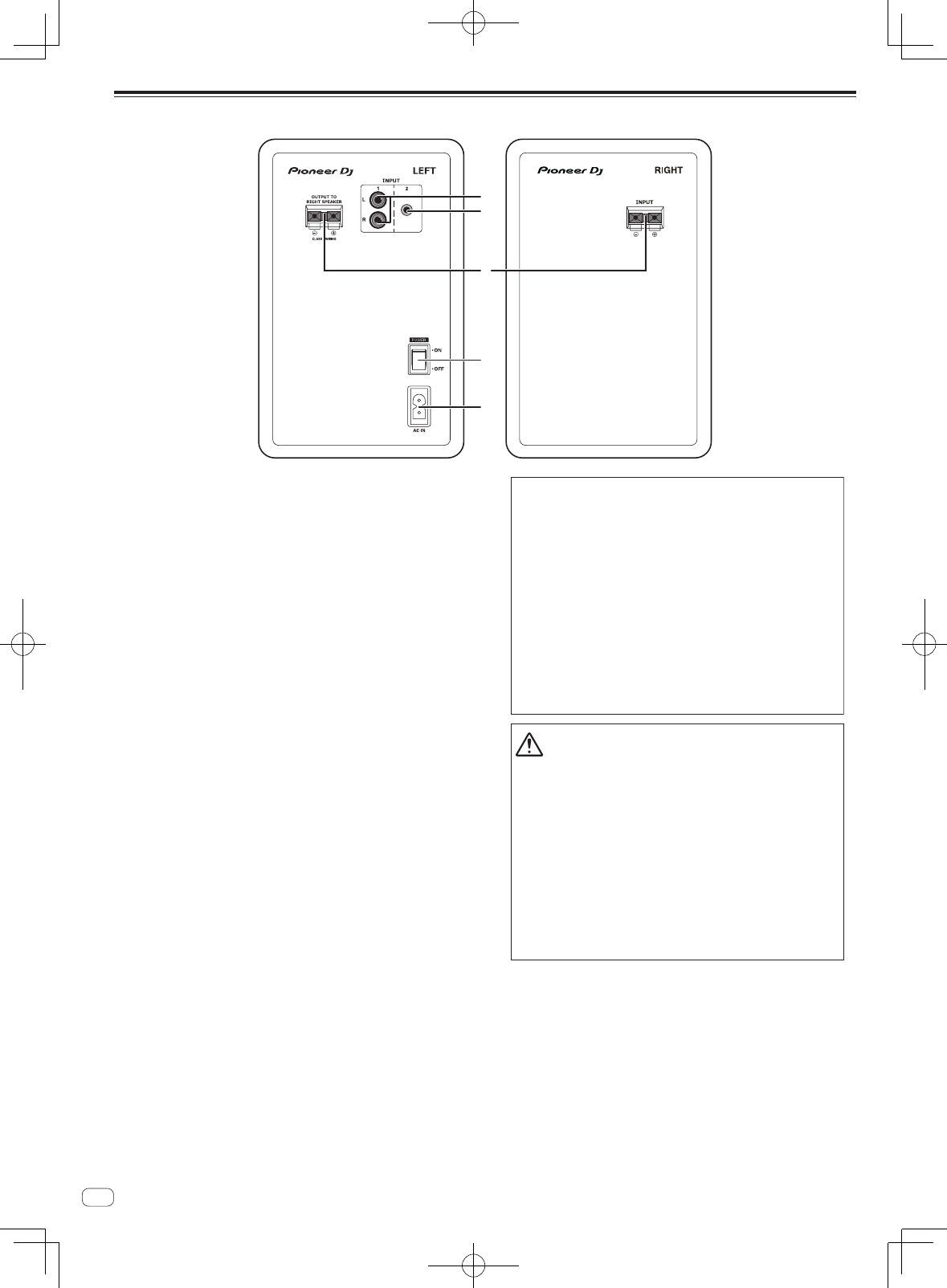
Nl
4
Achterpaneel
2
4
5
1
3
1 INPUT 1-aansluitingen (stereo)
Dit zijn ongebalanceerde ingangen voor een RCA-penaansluiting.
2 INPUT 2-aansluitingen (stereo)
Dit is een ongebalanceerde ingang voor
een 3,5 mm-stereoministekker.
3 Connectors voor luidsprekeraansluiting
Sluit de linker en rechter luidspreker aan met de meegeleverde
kabel.
Sluit deze luidsprekers niet op een andere versterker aan dan die van
dit systeem. Dat kan beschadiging of brand veroorzaken.
4 POWER-schakelaar
Voor aanzetten en uitschakelen van dit apparaat.
5 AC IN
Sluit het netsnoer aan op AC IN en vervolgens op het stopcontact.
Sluit het netnoer pas aan nadat alle aansluitingen tussen de appara-
tuur volledig zijn gemaakt.
Gebruik het meegeleverde netsnoer.
LET OP
De POWER schakelaar van dit apparaat koppelt het
apparaat niet volledig los van het lichtnet. Aangezien
er na het uitschakelen van het apparaat nog een
kleine hoeveelheid stroom blijft lopen, moet u de
stekker uit het stopcontact halen om het apparaat
volledig van het lichtnet los te koppelen. Plaats het
apparaat zodanig dat de stekker in een noodgeval
gemakkelijk uit het stopcontact kan worden gehaald.
Om brand te voorkomen, moet u de stekker uit het
stopcontact halen wanneer u het apparaat langere
tijd niet denkt te gebruiken (bijv. wanneer u op
vakantie gaat).
D3-4-2-2-2a*_A1_Nl
WAARSCHUWING
!Dit product is voorzien van een automatische stand-byfunctie.
Als gedurende een bepaalde tijd (ongeveer 30 minuten)
geen geluid wordt weergegeven, gaat de indicator POWER
automatisch uit en schakelt het product over naar de
stand-bystand met laag stroomverbruik, ongeacht of er een
Bluetooth-verbinding is.
!Als het product overschakelt naar de stand-bystand wanneer
er een Bluetooth-verbinding is, wordt de Bluetooth-verbinding
verbroken en gaat de Bluetooth-indicator ook uit.
!Als in de stand-bystand via de ingangsaansluitingen een
audiosignaal wordt ingevoerd, wordt het product automatisch
aangezet. Voorts wordt het product aangezet als tijdens de
stand-bystand de Bluetooth-koppeltoets wordt ingedrukt.
!Deze automatische stand-byfunctie kan niet worden
uitgeschakeld.
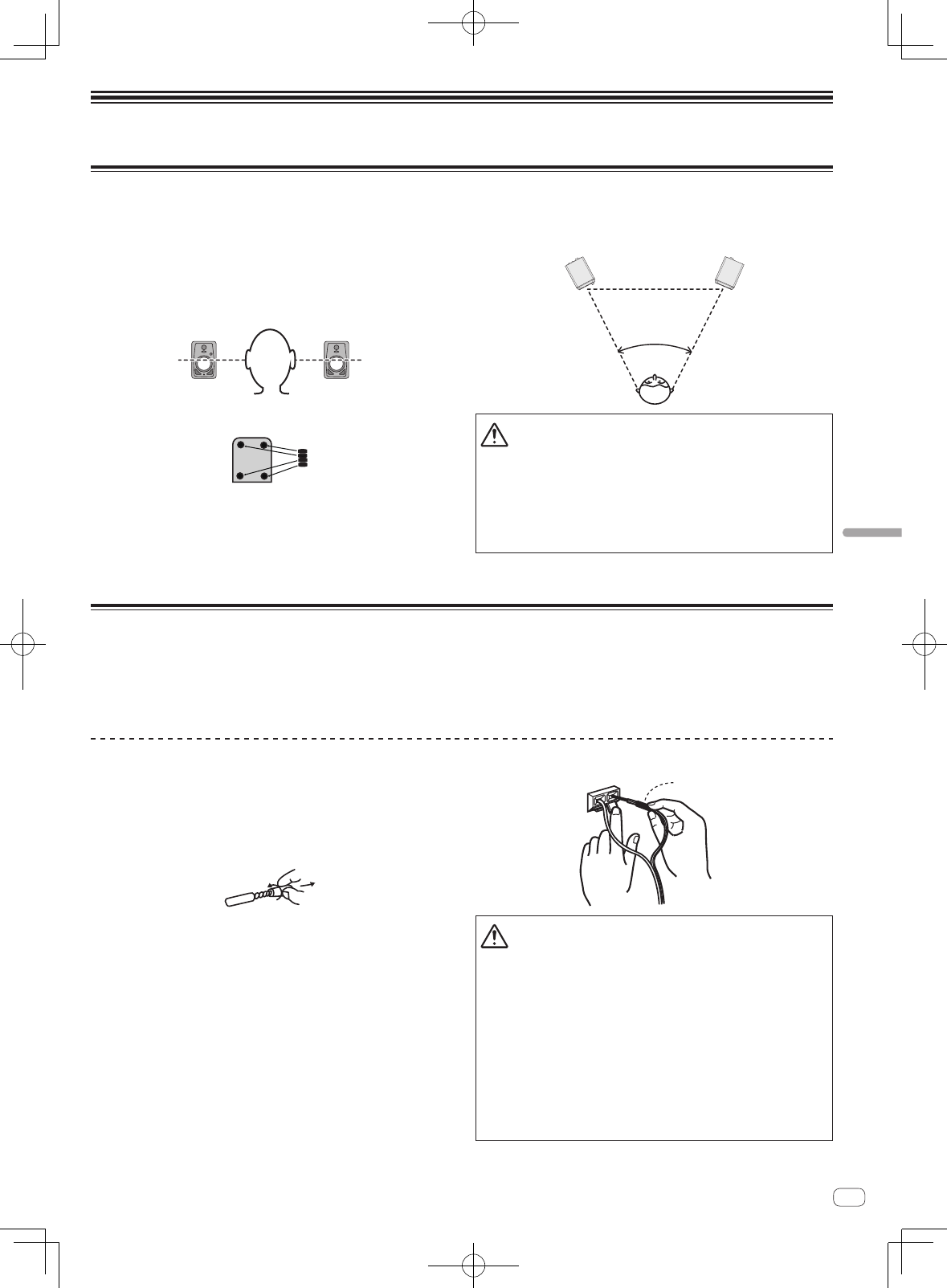
Nl 5
Nederlands
Installatie en aansluitingen
Installatieprocedure
Het weergavegeluid van luidsprekers wordt beïnvloed door de omstan-
digheden in de luisterruimte. Om een optimale luisteromgeving te
creëren, moet u terdege rekening houden met de omstandigheden op de
installatieplaats voordat u met de feitelijke installatie begint.
! Plaats de luidsprekers op oorniveau.
! Voor een natuurlijk stereo-effect moeten de linker en de rechter
luidspreker symmetrisch en op gelijke afstand van de luisterplaats
worden opgesteld.
! Bevestig de meegeleverde kussens aan de onderkant van het toestel
om glijden te voorkomen.
WAARSCHUWING
Berg kleine onderdelen op buiten het bereik van
kinderen en peuters. R
aadpleeg onmiddellijk een arts
indien kleine onderdelen per ongeluk worden ingeslikt.
D41-6-4_A1_N
l
! Installeer de luidsprekers naar binnen gericht zodat de hoek op de
luisterpositie in totaal 60 graden bedraagt, 30 graden elk voor de
linker en de rechter luidspreker.
50 ° tot 60 °
WAARSCHUWING
Voor een goede koeling moet u ervoor zorgen dat er voldoende ruimte
is tussen de luidsprekers en eventuele muren of andere componenten
in de buurt (minimaal 15 cm vrije ruimte boven, achter, en rechts en
links van elke luidspreker). Wanneer er onvoldoende ruimte is tussen
de luidspreker en de muur of andere componenten, kan de interne
temperatuur te hoog oplopen met een defect of beschadiging tot
gevolg.
Aansluitingen
! Schakel altijd eerst de stroom uit en trek de stekker uit het stopcon-
tact alvorens u enige aansluiting maakt of verbreekt.
! Zie tevens de gebruiksaanwijzingen van de aan te sluiten apparatuur.
! Sluit het netnoer pas aan nadat alle aansluitingen tussen de appara-
tuur volledig zijn gemaakt.
! Gebruik alleen het bijgeleverde netsnoer.
! Wees voorzichtig wat het volume betreft omdat de ingangssignalen
van de aansluitingen [INPUT 1], [INPUT 2] en Bluetooth gemengd
worden.
De kabels aansluiten
Sluit de meegeleverde luidsprekerdraad op de luidsprekers aan.
1 Strip ongeveer 1 cm van het uiteinde van de
meegeleverde luidsprekerdraad, en draai en verwijder
de isolatie.
Draai of vlecht de kerndraden goed nadat u de isolatie hebt verwijderd.
2 Sluit de meegeleverde luidsprekerdraad aan op de
luidsprekeraansluitingen aan de LINKER en de RECHTER
kant.
3 Duw de klem van de luidsprekeraansluiting naar
beneden en steek de kerndraad in de aansluiting.
Sluit de luidsprekerdraad met de rode lijn aan op de + aansluiting
(rood), en de luidsprekerdraad zonder de rode lijn op de – aansluiting
(zwart).
Rood +
Zwart
−
Met de rode lijn
WAARSCHUWING
! Trek na het aansluiten lichtjes aan de luidsprekerdraad om te
controleren of deze met het uiteinde stevig in de aansluitingen
vastzit. Een losse aansluiting kan leiden tot onderbrekingen in de
geluidsweergave of ruis.
! Draai de kerndraden goed in elkaar bij het aansluiten van de
luidsprekerdraad, en zorg ervoor dat de kerndraden niet uit de
luidsprekeraansluitingen naar buiten steken. Als de kerndraden uit
de luidsprekeraansluiting naar buiten steken, kunnen ze het ach-
terpaneel of elkaar raken. Daardoor kan de versterker bovenmatig
belast worden en stoppen of defect raken.
! Als de polariteit (+, –) van de LINKER en RECHTER kant verkeerd
is bij het aansluiten van de LINKER en RECHTER luidsprekerdraad,
kan geen normaal stereo-effect meer worden verkregen.
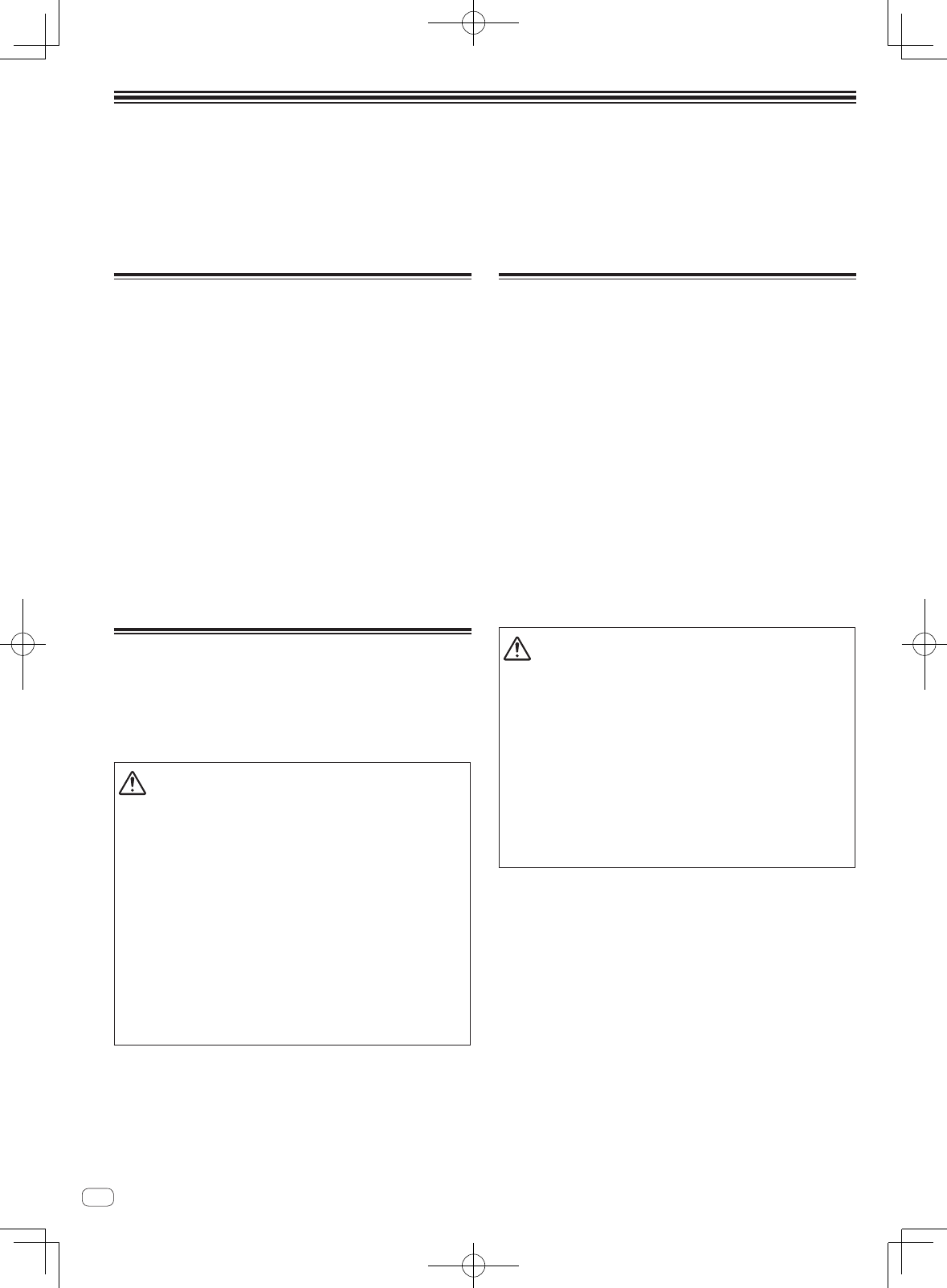
Nl
6
Naar de muziek van een Bluetooth-apparaat
luisteren
Met deze luidsprekers kunt u draadloos naar muziekstukken luisteren die op een Bluetooth-apparaat zijn opgeslagen.
Wanneer u de luidsprekers voor het eerst gebruikt of een nieuw Bluetooth-apparaat op de luidsprekers aansluit, dient u de luidsprekers en het
Bluetooth-apparaat te koppelen.
Koppelen (wederzijdse registratie van de apparaten) is een vereiste handeling om een Bluetooth-apparaat en de luidsprekers te verbinden.
Waarschuwing betreffende
radiogolven
Dit apparaat maakt gebruik van een radiogolffrequentie van 2,4 GHz, wat
een band is die ook wordt gebruikt door andere draadloze systemen (zie
de onderstaande lijst). Om ruis of onderbrekingen in de communicatie
te voorkomen, dient u dit apparaat niet in de buurt van dergelijke appa-
ratuur te gebruiken, of u dient ervoor te zorgen dat die apparatuur tijdens
het gebruik van dit apparaat uitgeschakeld is.
! Draadloze telefoons
! Draadloze faxmachines
! Magnetrons
! Draadloze LAN-apparaten (IEEE802.11b/g)
! Draadloze AV-apparatuur
! Draadloze regelaars voor spelsystemen
! Gezondheidsapparaten op basis van microgolven
! Bepaalde babyphones
Andere, minder bekende apparatuur die op dezelfde frequentie
werkzaam kan zijn:
! Antidiefstalsystemen
! Amateurradiostations (HAM)
! Logistieke beheersystemen in magazijnen
! Discriminatiesystemen voor trein- of noodhulpvoertuigen
WAARSCHUWING
! Als er ruis verschijnt in het televisiebeeld, is het mogelijk dat een
Bluetooth®-apparaat of dit toestel (met inbegrip van producten
die door dit toestel worden ondersteund) signaalinterferentie
veroorzaakt met de antenne-ingangsaansluiting van uw televisie,
videospeler, satellietontvanger, e.d. Vergroot in dat geval de
afstand tussen de antenne-ingangsaansluiting en het Bluetooth-
apparaat of dit toestel (met inbegrip van producten die door dit
toestel worden ondersteund).
! Als er iets is dat de baan blokkeert tussen dit apparaat (inclusief de
apparatuur die door dit apparaat wordt ondersteund) en de appa-
ratuur uitgerust met Bluetooth draadloze technologie (zoals een
metalen deur, een betonwand of isolatie waarin aluminiumfolie is
verwerkt), kan het zijn dat u de plaats van uw systeem moet veran-
deren om signaalruis en andere onderbrekingen te voorkomen.
Procedure voor koppelen en
verbinden
1 Zet de [POWER]-schakelaar aan om de luidsprekers
aan te zetten.
! De Bluetooth-indicator knippert ongeveer 30 seconden en de luid-
sprekers schakelen over naar de koppelstand.
! Als de Bluetooth-indicator uitgaat, druk dan minstens 2 seconden op
de koppeltoets om weer over te schakelen naar de koppelstand.
2 Voer het koppelen uit op het Bluetooth-apparaat.
Doe dit terwijl de luidsprekers in de koppelstand staan.
Zie voor details de handleiding van uw Bluetooth-apparaat.
3 Als de Bluetooth-indicator stopt met knipperen en
blijft branden, is het koppelen (verbinden) voltooid.
Als het koppelen niet binnen 30 seconden wordt uitgevoerd, stopt de
Bluetooth-indicator met knipperen en gaat de indicator uit.
! Een Bluetooth-apparaat dat al gekoppeld is, kan verbonden worden
door het verbinden op het Bluetooth-apparaat uit te voeren als de
luidsprekers zijn ingeschakeld.
Weergeven
Als u muziek op een verbonden Bluetooth-apparaat afspeelt, wordt
de op het Bluetooth-apparaat afgespeelde muziek via de luidsprekers
weergegeven.
! Als u tijdens de muziekweergave op het Bluetooth-apparaat op de
koppeltoets drukt, kunt u pauzeren/afspelen (zelfde functie als de
knop voor pauzeren/afspelen van het Bluetooth-apparaat).
ATTENTION
! Verplaats het Bluetooth-apparaat tijdens het koppelen (verbinden)
dicht bij de luidsprekers.
! Er kan luid geluid worden weergegeven wanneer voor de eerste
keer wordt afgespeeld na het verbinden; daarom raden we aan om
vóór het afspelen het volume te verlagen.
! Afhankelijk van de gebruikte applicatie is het mogelijk dat pau-
zeren/afspelen met de koppeltoets niet werkt.
! Afhankelijk van het Bluetooth-apparaat kan mogelijk geen verbind-
ing worden gemaakt met de luidsprekers.
! Als u de luidsprekers met een ander Bluetooth-apparaat wilt kop-
pelen, zet dan de Bluetooth-functie van het momenteel verbonden
Bluetooth-apparaat uit of verbreek de verbinding voordat u het
koppelen uitvoert.
! De luidsprekers bewaren de koppelgegevens van maximaal acht
Bluetooth-apparaten, en proberen verbinding te maken met het
laatst gekoppelde apparaat als de koppeltoets wordt ingedrukt
wanneer er geen verbinding is met een Bluetooth-apparaat.

Nl 7
Nederlands
Omvang van de werking
Het gebruik van dit apparaat is beperkt tot thuisgebruik. (Zendafstanden
kunnen kleiner zijn afhankelijk van de communicatieomgeving.) Op
de volgende plaatsen kan het geluid worden onderbroken of volledig
wegvallen als gevolg van slechte omstandigheden of het niet kunnen
ontvangen van radiogolven:
! In gebouwen met gewapend beton of woningen gemaakt met stalen
of ijzeren dragende delen.
! In de buurt van metalen meubilair.
! In een menigte mensen of in de buurt van een gebouw of een
obstakel.
! Op een plaats die is blootgesteld aan het magnetische veld, statische
elektriciteit of radiogolveninterferentie van radiocommunicatieap-
paratuur die gebruik maakt van dezelfde frequentieband (2,4 GHz)
als dit apparaat, zoals een 2,4 GHz draadloos LAN-apparaat of een
magnetron.
! Wanneer u in een dichtbevolkt woongebied woont (appartement,
rijtjeshuis, enz.) en de magnetron van uw buren in de buurt van
uw systeem is geplaatst, kunt u last hebben van radiogolveninter-
ferentie. Wanneer dit gebeurt, zet u het apparaat op een andere
plaats. Wanneer de magnetron niet wordt gebruikt, is er geen
radiogolveninterferentie.
Reflecties van radiogolven
Dit apparaat ontvangt de radiogolven die rechtstreeks afkomstig zijn
van de apparatuur uitgerust met Bluetooth draadloze technologie
(directe golven) en de golven die vanuit verschillende richtingen komen
als gevolg van weerkaatsingen tegen muren, meubilair en gebouwen
(weerkaatste golven). De weerkaatste golven (als gevolg van obstakels
en reflecterende voorwerpen) produceren opnieuw een verscheidenheid
aan weerkaatste golven alsmede een variatie in ontvangstomstan-
digheden, afhankelijk van de locatie. Wanneer het geluid als gevolg van
dit fenomeen niet meer correct kan worden ontvangen, dient u de plaats
van de apparatuur uitgerust met Bluetooth draadloze technologie iets te
veranderen. Houd er rekening mee dat het geluid tevens onderbroken
kan worden als gevolg van weerkaatste golven wanneer een persoon
door de ruimte tussen dit apparaat en de apparatuur uitgerust met
Bluetooth draadloze technologie loopt of deze nadert.

Nl
8
Aanvullende informatie
Verhelpen van storingen
! Soms ligt de oorzaak van het probleem bij een ander apparaat. Controleer daarom ook de andere componenten en elektrische apparatuur die
gebruikt wordt. Als u het probleem niet kunt verhelpen, verzoekt u dan uw dichtstbijzijnde officiële Pioneer onderhoudsdienst of uw vakhandelaar
om het apparaat te laten repareren.
! Dit apparaat kan soms niet goed werken vanwege statische elektriciteit of andere externe invloeden. In dat geval kunt u de normale werking herstel-
len door de stekker uit het stopcontact te trekken en die na ongeveer 5 seconden of langer weer aan te sluiten.
Algemeen
Probleem Controle Oplossing
De stroom wordt niet ingeschakeld. Is het netsnoer naar behoren aangesloten? Steek de netsnoerstekker in het stopcontact.
Er wordt geen geluid uit het aangesloten
apparaat weergegeven of het geluid is
zwak.
Is het aangesloten apparaat juist ingesteld? Stel de externe ingang van het apparaat en het volume juist in.
Staat het volume in de juiste stand? Draai de regelaar [LEVEL] op het voorpaneel van dit toestel met de wijzers
van de klok mee om het volume te verhogen.
Is de stroom ingeschakeld? Zet de schakelaar [POWER] op het achterpaneel van dit toestel aan.
De indicator POWER (wit) licht niet op.
Is de stroom ingeschakeld? Zet de schakelaar [POWER] op het achterpaneel van dit toestel aan.
Staan de luidsprekers in de stand-bystand? Zet de schakelaar [POWER] op het achterpaneel van dit toestel een keer uit
en na een paar seconden weer aan.
Het toestel komt niet uit de stand-bystand
(gaat niet aan). Is het ingangssignaalniveau laag? Verhoog het ingangssignaalniveau.
Vervorming in het geluid.
Staat het volume in de juiste stand? Draai de regelaar [LEVEL] op het voorpaneel van dit toestel tegen de wijzers
van de klok in om het volume te verlagen.
Is het niveau voor de ingang van het aangesloten
apparaat juist ingesteld? Stel het uitgangsniveau van het aangesloten apparaat juist in.
Er is oscillatie (er wordt voortdurend luid
geluid uitgevoerd). Staat het volume in de juiste stand? Draai de regelaar [LEVEL] op het voorpaneel van dit toestel tegen de wijzers
van de klok in om het volume te verlagen.
Er klinkt alleen geluid uit de linker
luidspreker. Is de luidsprekerdraad juist aangesloten? Sluit de linker en rechter luidspreker juist aan.
De stroom wordt automatisch uitgescha-
keld (stand-bystand).
Is er gedurende een bepaalde tijd (ongeveer
30 minuten) of langer geen geluid geweest?
Voer een signaal in via de RCA- of stereoministekker-ingangsaansluiting.
Of druk op de koppeltoets op het voorpaneel van dit toestel.
Is het ingangssignaalniveau laag? Verhoog het ingangssignaalniveau.
Indien verbonden met de aansluiting INPUT 1 of INPUT 2
Probleem Controle Oplossing
Er wordt geen geluid uit het aangesloten
apparaat weergegeven of het geluid is
zwak.
Zijn de aansluitsnoeren goed aangesloten? Zorg dat de aansluitsnoeren juist zijn aangesloten.
Zijn de aansluitbussen en de stekkers vuil? Maak de aansluitbussen en de stekkers schoon voordat u aasluitingen gaat
maken.
Er klinkt alleen geluid uit één luidspreker. Is het apparaat juist aangesloten? Sluit het apparaat aan op zowel de linker als de rechter ingangsaansluiting.
Het geluid wordt onderbroken of er is ruis
hoorbaar.
Is er een contactprobleem met de
verbindingskabels? Sluit de verbindingskabels weer aan.
Indien verbonden via Bluetooth
Problème Vérification Solution
Kan geen verbinding maken of het geluid
wordt onderbroken of er is ruis hoorbaar.
Is er in de buurt apparatuur die elektromagne-
tische golven in de 2,4 GHz-band produceert
(magnetron, draadloos LAN-apparaat, ander
Bluetooth-apparaat, e.d.)?
Installeer dit toestel uit de buurt van die apparatuur of stop de andere appa-
ratuur die elektromagnetische golven afgeeft.
Is de afstand vanaf het Bluetooth-apparaat te
groot? Of wordt het signaal geblokkeerd door een
muur of ander obstakel in de tussenruimte?
Plaats dit toestel en het verbonden Bluetooth-apparaat dichter bij elkaar. Of
wijzig de positie van het Bluetooth-apparaat of dit toestel.
Wordt op het Bluetooth-apparaat een andere
applicatie dan de applicatie voor muziekweergave
uitgevoerd?
Sluit andere applicaties dan de applicatie voor muziekweergave op het
Bluetooth-apparaat.
Ondersteunt het Bluetooth-apparaat dat u wilt
verbinden A2DP? Gebruik een Bluetooth-apparaat dat A2DP ondersteunt.
Is het koppelen met het Bluetooth-apparaat cor-
rect uitgevoerd?
Zet de stroom van dit toestel en het Bluetooth-apparaat uit en weer aan, en
voer het koppelen opnieuw uit.
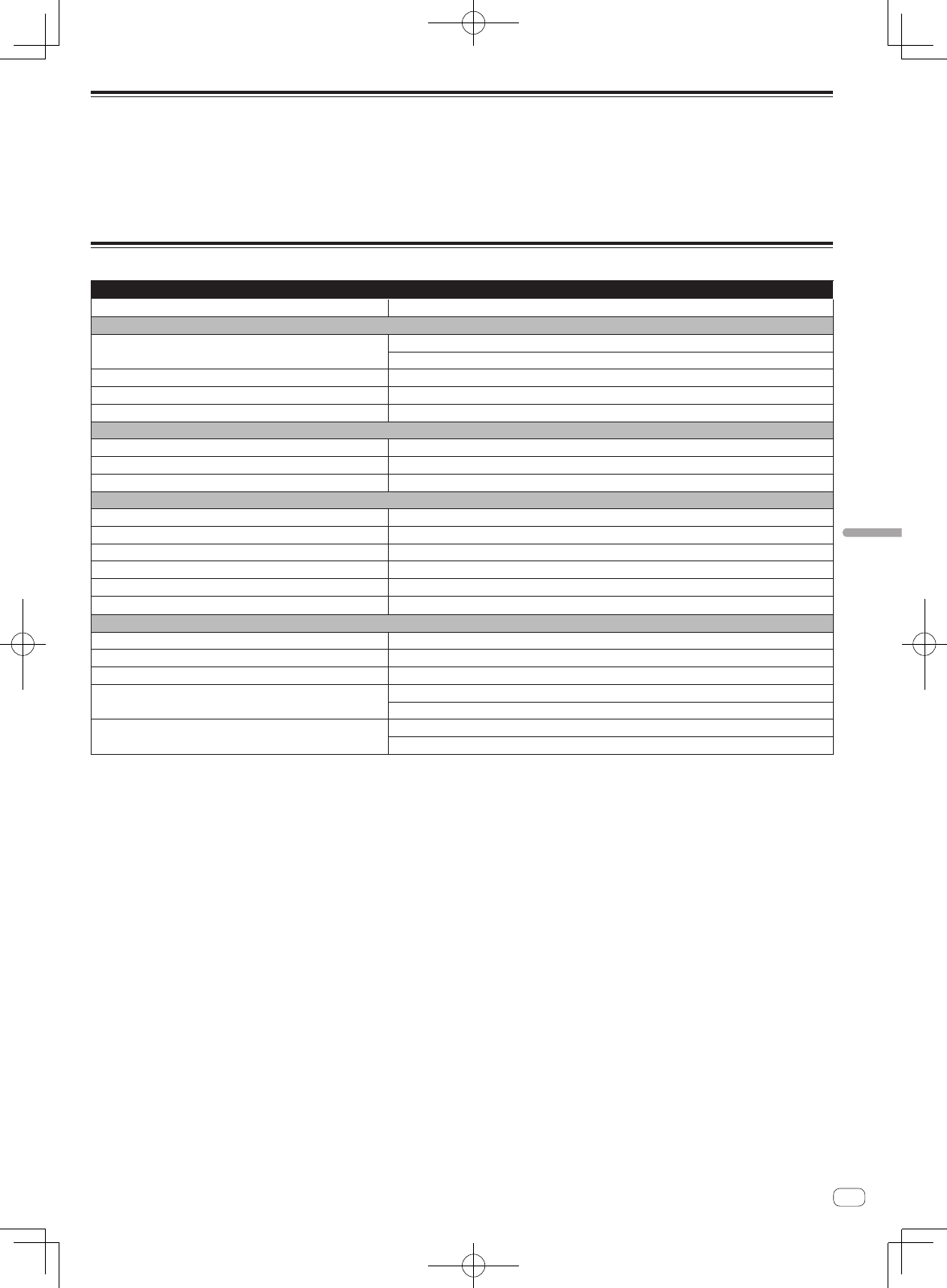
9
ver handelsmerken en gedeponeerde handelsmerken
! “Pioneer DJ” is een handelsmerk van PIONEER CORPORATION en wordt in licentie gebruikt.
! De hierin vermelde namen van bedrijven en hun producten zijn de handelsmerken of geregistreerde handelsmerken van hun respectieve eigenaars.
! De naam Bluetooth® en de logo’s daarvan zijn geregistreerde handelsmerken van Bluetooth SIG, Inc. en PIONEER DJ Corporation gebruikt deze
onder licentie. Andere handelsmerken en handelsnamen zijn eigendom van hun respectieve eigenaars.
! Qualcomm aptX is een product van Qualcomm Technologies International, Ltd. Qualcomm is een handelsmerk van Qualcomm Incorporated, gere-
gistreerd in de Verenigde Staten en andere landen, gebruikt met toestemming. aptX is een handelsmerk van Qualcomm Technologies International,
Ltd., geregistreerd in de Verenigde Staten en andere landen, gebruikt met toestemming.
Specificaties
DM-40BT/DM-40BT-W
Model Actieve 2-wegluidspreker
Versterker
Versterkeruitgang Linker kanaal: 21 W/4 W, klasse AB
Rechter kanaal: 21 W/4 W, klasse AB
Ingangsaansluitingen RCA × 1, 3,5 mm-stereoministekker × 1
Ingangsimpedantie 10 kW
Uitgangsaansluitingen Hoofdtelefoon × 1
Luidspreker
Behuizing Basreflextype/vinyl-gelamineerd MDF
Woofer (LF-driver) 4 inch (102 mm) conus
Tweeter (HF-driver) 3/4 inch (19 mm) zachte conus
Bluetooth-gedeelte
Versie Bluetooth Specificatie versie 4.2
Uitvoer Bluetooth Specificatie klasse 2
Gebruikte frequentie 2,4 GHz
Modulatie FH-SS (Frequency Hopping Spread Spectrum)
Ondersteunde Bluetooth-profielen A2DP, AVRCP
Ondersteunde codec SBC, AAC, Qualcomm® aptX™, Qualcomm® aptX™ Low Latency
Voeding / andere
Bruikbare spanning 110 V tot 240 V wisselstroom, 50 Hz/60 Hz
Stroomverbruik 35 W
Stroomverbruik tijdens wachten (stand-bystand) 0,3 W
Buitenafmetingen B × H × D Linker kanaal: 146 mm × 227 mm × 223 mm
Rechter kanaal: 146 mm × 227 mm × 210 mm
Gewicht Linker kanaal: 2,7 kg
Rechter kanaal: 2,2 kg
! De technische gegevens en het ontwerp van dit product kunnen vanwege voortgaande verbetering zonder voorafgaande kennisgeving worden
gewijzigd.
! © 2017 Pioneer DJ Corporation. Alle rechten voorbehouden.
Nl
Nederlands
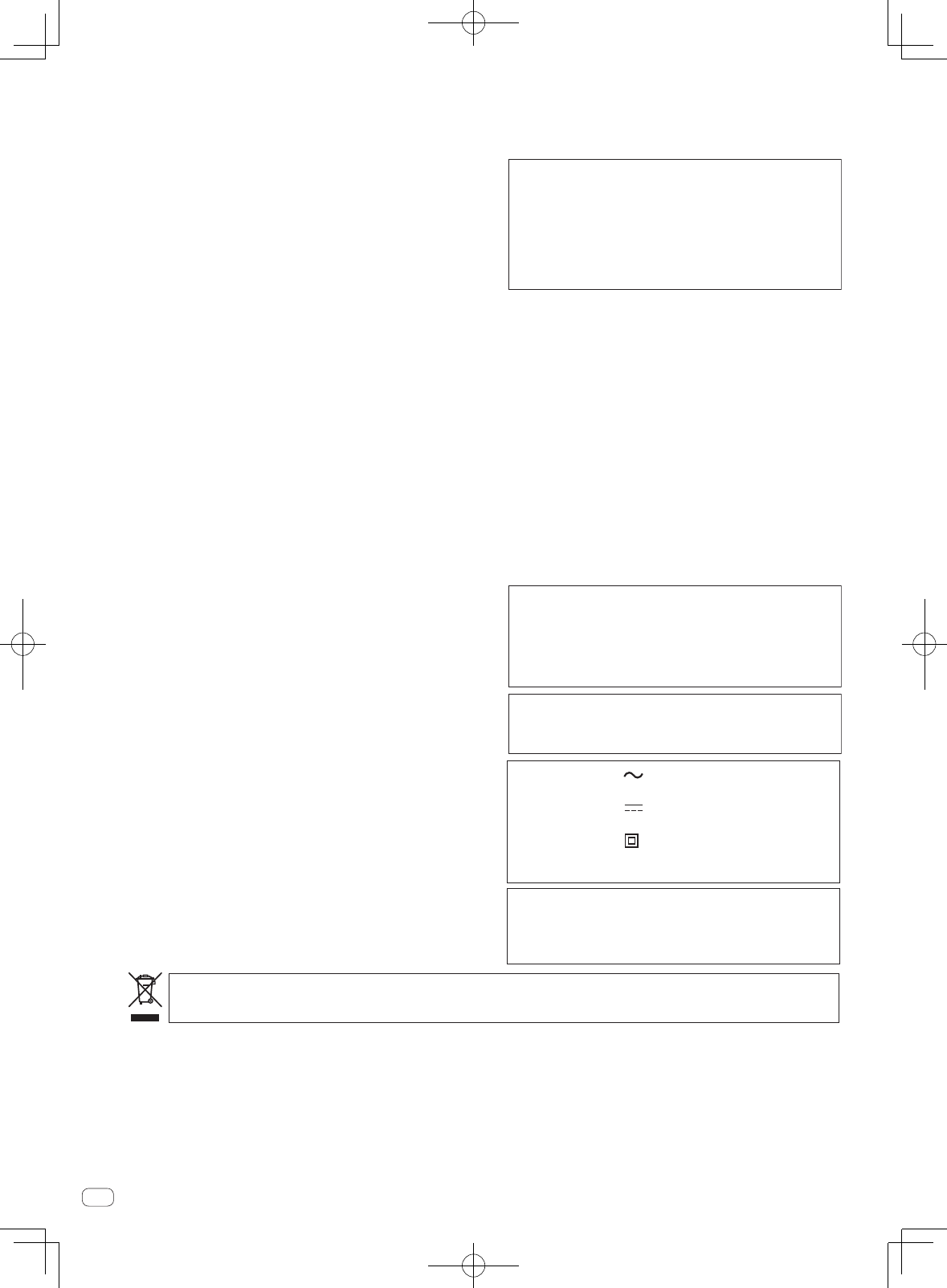
Es
2
Le damos las gracias por la adquisición de este producto Pioneer DJ.
Lea a fondo estas instrucciones de utilización para que aprenda a utilizar correctamente su modelo.
Después de haber terminado de leer estas instrucciones, guárdelas en un lugar seguro para, en caso de ser necesario,
consultarlas en el futuro.
PRECAUCIÓN
PARA PREVENIR EL PELIGRO DE CHOQUE ELÉCTRICO
NO REMOVER LA TAPA NI LAS PARTES DENTRO NO
UTILIZADAS, LLAMAR UNA PERSONA CUALIFICADA.
D3-4-2-1-1_B2_Es
ADVERTENCIA
Este aparato no es impermeable. Para evitar el riesgo
de incendio y de descargas eléctricas, no ponga ningún
recipiente lleno de líquido (como pueda ser un vaso o
un florero) cerca del aparato ni lo exponga a goteo,
salpicaduras, lluvia o humedad.
D3-4-2-1-3_A1_Es
ADVERTENCIA
Para evitar el peligro de incendio, no ponga nada con
fuego encendido (como pueda ser una vela) encima del
aparato.
D3-4-2-1-7a_A1_Es
Entorno de funcionamiento
Temperatura y humedad del entorno de funcionamiento
+5 °C a +35 °C; menos del 85 % de humedad relativa
(rejillas de refrigeración no obstruidas)
No instale este aparato en un lugar mal ventilado, ni en
lugares expuestos a alta humedad o a la luz directa del
sol (o de otra luz artificial potente).
D3-4-2-1-7c*_A1_Es
PRECAUCIÓN PARA LA VENTILACIÓN
Cuando instale este aparato, asegúrese de dejar
espacio en torno al mismo para la ventilación con el fin
de mejorar la disipación de calor (por lo menos 15 cm
encima, 15 cm detrás, y 15 cm en cada lado).
D3-4-2-1-7d*_A1_Es
Este producto es para tareas domésticas generales.
Cualquiera avería debida a otra utilización que tareas
domésticas (tales como el uso a largo plazo para
motivos de negocios en un restaurante o el uso en un
coche o un barco) y que necesita una reparación
hará que cobrarla incluso durante el período de
garantía.
K041_A1_Es
Si desea deshacerse de este producto, no lo mezcle con los residuos generales de su hogar. De conformidad con la legislación
vigente, existe un sistema de recogida distinto para los productos electrónicos que requieren un procedimiento adecuado de
tratamiento, recuperación y reciclado.
Las viviendas privadas en los estados miembros de la UE, en Suiza y Noruega pueden devolver gratuitamente sus productos electr
ónicos usados
en las instalaciones de recolección previstas o bien en las instalaciones de minoristas (si adquieren un producto similar nuevo
).
En el caso de los países que no se han mencionado en el párrafo anterior
, póngase en contacto con sus autoridades locales a fin de conocer el
método de eliminación correcto
.
Al actuar siguiendo estas instrucciones, se asegurará de que el producto de desecho se somete a los procesos de tratamient
o, recuperación y
reciclaje necesarios, con lo que se previenen los efectos negativos potenciales para el entorno y la salud humana.
K058b_A1_Es
PRECAUCIONES CONCERNIENTES A LA
MANIPULACIÓN DEL CABLE DE
ALIMENTACIÓN
Tome el cable de alimentación por la clavija. No
extraiga la clavija tirando del cable. Nunca toque el
cable de alimentación cuando sus manos estén
mojadas, ya que esto podría causar cortocircuitos o
descargas eléctricas. No coloque la unidad, algún
mueble, etc., sobre el cable de alimentación.
Asegúrese de no hacer nudos en el cable ni de unirlo a
otros cables. Los cables de alimentación deberán ser
dispuestos de tal forma que la probabilidad de que
sean pisados sea mínima. Una cable de alimentación
dañado podrá causar incendios o descargas eléctricas.
Revise el cable de alimentación está dañado, solicite el
reemplazo del mismo al centro de servicio más
cercano, o a su distribuidor.
S002*_A1_Es
Precauciones para el DM-40BT/DM-40BT-W
No conecte este altavoz a ningún amplificador que
no sea el suministrado con este sistema. La
conexión a cualquier otro amplificador puede
resultar en fallas de funcionamiento o aun incendio.
SGK006*_A1_Es
No fije estos altavoces a una pared ni al techo, ya que
podrían caerse y ocasionar lesiones.
SGK007_A1_Es
ADVERTENCIA
Las ranuras y aberturas de la caja del aparato sirven
para su ventilación para poder asegurar un
funcionamiento fiable del aparato y para protegerlo
contra sobrecalentamiento. Para evitar el peligro de
incendio, las aberturas nunca deberán taparse ni
cubrirse con nada (como por ejemplo, periódicos,
manteles, cortinas) ni ponerse en funcionamiento el
aparato sobre una alfombra gruesas o una cama.
D3-4-2-1-7b*_A1_Es
El símbolo gráfico colocado en el producto
significa corriente alterna.
El símbolo gráfico colocado en el producto
significa corriente continua.
El símbolo gráfico colocado en el producto
significa equipo de Clase II.
D3-8-2-4_A1_Es
PRECAUCIÓN
Este producto se evalúa en un entorno climático
moderado.
D3-8-2-1-7b_A1_Es
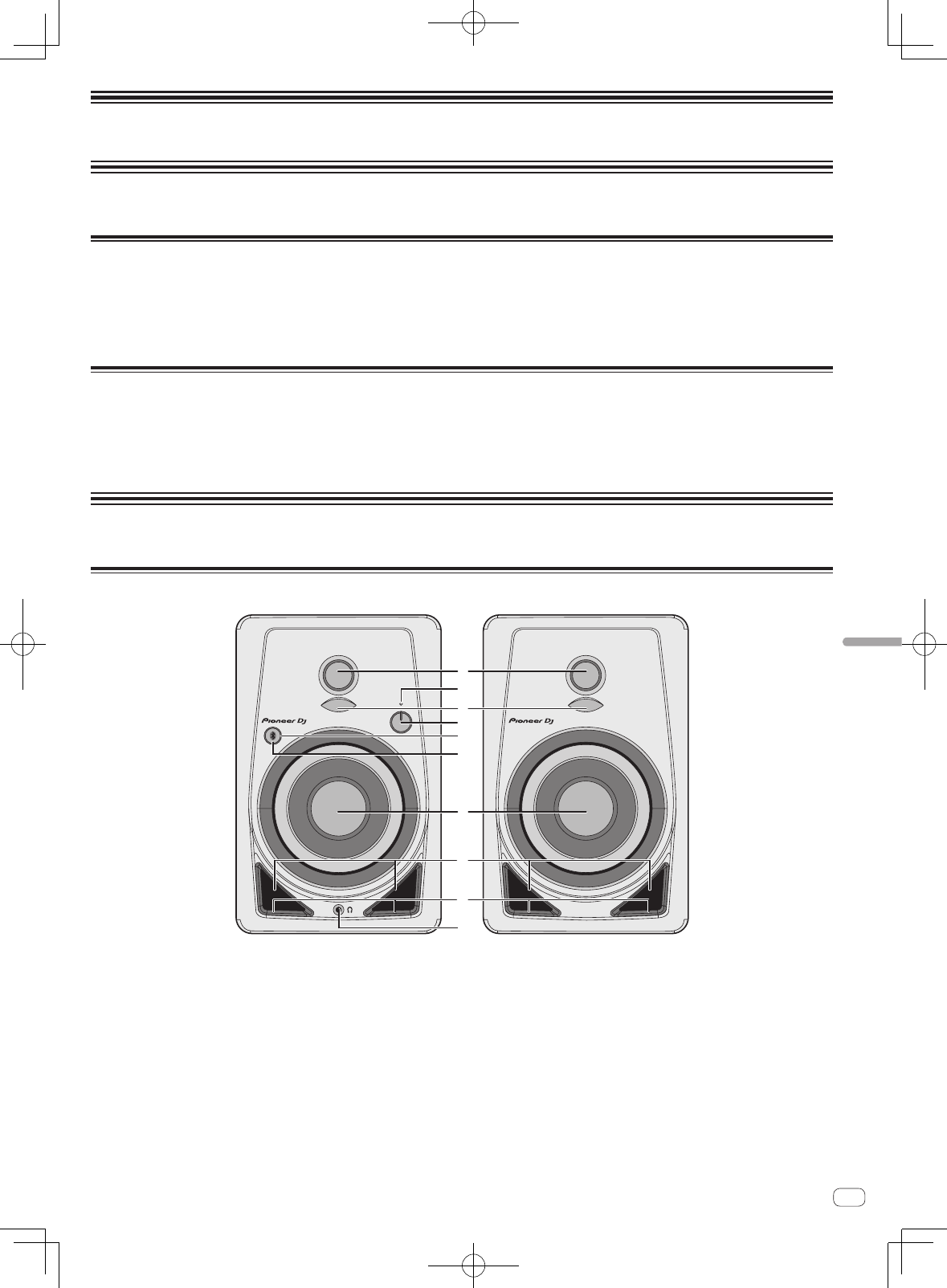
Es 3
Español
Léalo antes de usar (Importante)
Antes de empezar a usar la unidad
Características
! Un conducto reflector de bajos en la parte frontal y la tecnología Groove crean un potente sonido grave.
! Un difusor convexo en una nueva guía de ondas mejora la directividad del sonido y proporciona un sonido espacioso.
! Se consigue un sonido rico en bajos y una calidad de sonido más nítida a pesar de su tamaño de sobremesa compacto.
! Compatible con AAC y Qualcomm® aptX™ para una reproducción de sonido de mayor calidad mediante Bluetooth.
! Un botón de emparejamiento en el panel frontal permite emparejar dispositivos con un solo toque.
Comprobación de los accesorios
! Cable de alimentación x1
! Manual de Instrucciones (este manual)
! Cable del convertidor de audio (mini-clavija estéreo de 3,5 mm a RCA) x1
! Cable del altavoz x1
! Almohadilla para la parte inferior x8
Nomenclatura y funciones de las partes
Panel frontal
1
2
3
4
7
8
9
a
5
6
1 Tweeters de cúpula blanda de 3/4 pulgada
2 Indicador POWER
La iluminación está vinculada al encendido/apagado. El indicador
está apagado en espera.
3 Difusores
Mejoran la directividad del sonido de altas frecuencias y proporcio-
nan un sonido espacioso.
4 Control LEVEL
Ajusta el volumen.
5 Botón de emparejamiento
Realiza el emparejamiento con un dispositivo Bluetooth.
El botón también permite ejecutar las operaciones de pausa y repro-
ducción durante la reproducción de música mediante Bluetooth.
Para más información, consulte «Cómo escuchar música de un
dispositivo Bluetooth» (página 6).
6 Indicador de emparejamiento (página 6)
Si parpadea: la operación de emparejamiento está en curso o en
espera de conexión
Si está encendido: conexión establecida con el dispositivo Bluetooth
7 Altavoces de graves de fibra de vidrio de 4 pulgadas
8 Conductos de reflejo de graves
9 Ranuras
Ajuste el flujo de aire de los conductos de reflejo de graves para
irradiar bajas frecuencias sin contratiempos.
a Terminal de auriculares
Este es un terminal de salida de tipo de mini-clavija estéreo de 3,5 mm.
La conexión de los auriculares silencia la salida de sonido de los
altavoces y hace que solo se emita sonido desde los auriculares.
8
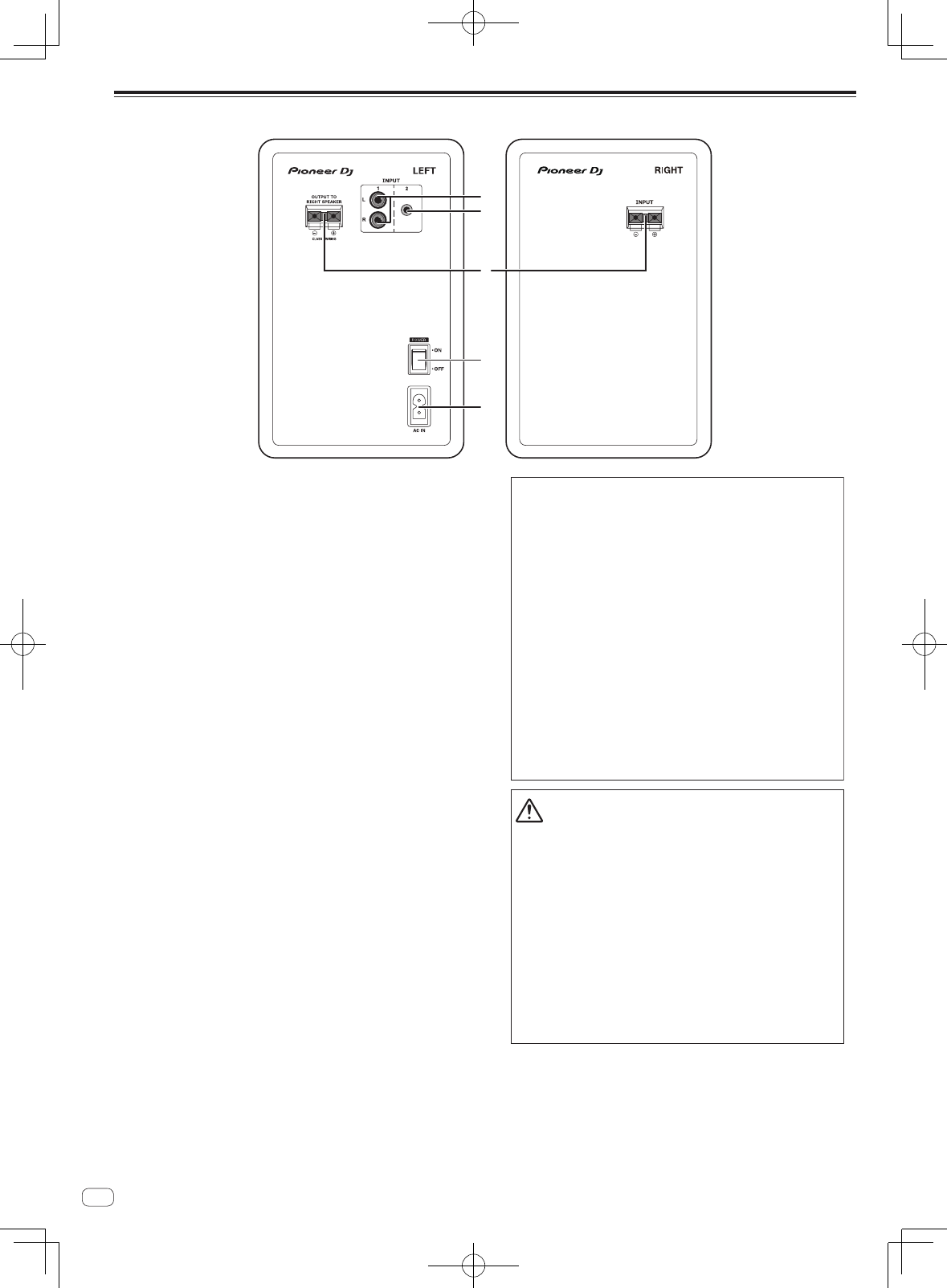
Es
4
Panel trasero
2
4
5
1
3
1 Terminales INPUT 1 (estéreo)
Se trata de terminales de entrada no equilibrados de tipo de clavija
RCA.
2 Terminales INPUT 2 (estéreo)
Este es un terminal de entrada de tipo de mini-clavija estéreo de 3,5
mm.
3 Conectores para la conexión del altavoz
Conecte los altavoces izquierdo y derecho usando el cable que se
incluye.
No conecte esos altavoces a un amplificador que no sea el de este
sistema. Si lo hace se puede provocar un incendio.
4 Conmutador POWER
Conecta y desconecta la alimentación de esta unidad.
5 AC IN
Conecte el cable de alimentación a AC IN y conecte la clavija de
alimentación a la toma de corriente.
Conecte el cable de alimentación después de terminar las conexio-
nes entre los aparatos.
Asegúrese de usar el cable de alimentación incluido.
PRECAUCIÓN
El interruptor de la alimentación POWER de este
aparato no corta por completo toda la alimentación
de la toma de corriente de CA. Puesto que el cable de
alimentación hace las funciones de dispositivo de
desconexión de la corriente para el aparato, para
desconectar toda la alimentación del aparato deberá
desenchufar el cable de la toma de corriente de CA.
Por lo tanto, asegúrese de instalar el aparato de
modo que el cable de alimentación pueda
desenchufarse con facilidad de la toma de corriente
de CA en caso de un accidente. Para evitar correr el
peligro de incendio, el cable de alimentación también
deberá desenchufarse de la toma de corriente de CA
cuando no se tenga la intención de utilizarlo durante
mucho tiempo seguido (por ejemplo, antes de irse de
vacaciones).
D3-4-2-2-2a*_A1_Es
AVISO
!Este producto se proporciona con una función de espera
automática. Si el estado en el que no se emite ningún
sonido se prolonga durante el período establecido
(aproximadamente 30 minutos) durante el uso, el producto
apaga automáticamente el indicador POWER y entra en
un estado de espera con un bajo consumo de energía,
independientemente de si hay una conexión Bluetooth.
!Si el producto entra en el estado de espera habiendo una
conexión Bluetooth, la conexión Bluetooth se desconecta y el
indicador Bluetooth también se apaga.
! Cuando se recibe una señal de audio de los terminales
de entrada en el estado de espera, el producto entra
automáticamente en el estado encendido. Además, el
producto también entra en el estado encendido si se pulsa el
botón de emparejamiento por Bluetooth estando en espera.
!Esta función de espera automática no se puede deshabilitar.
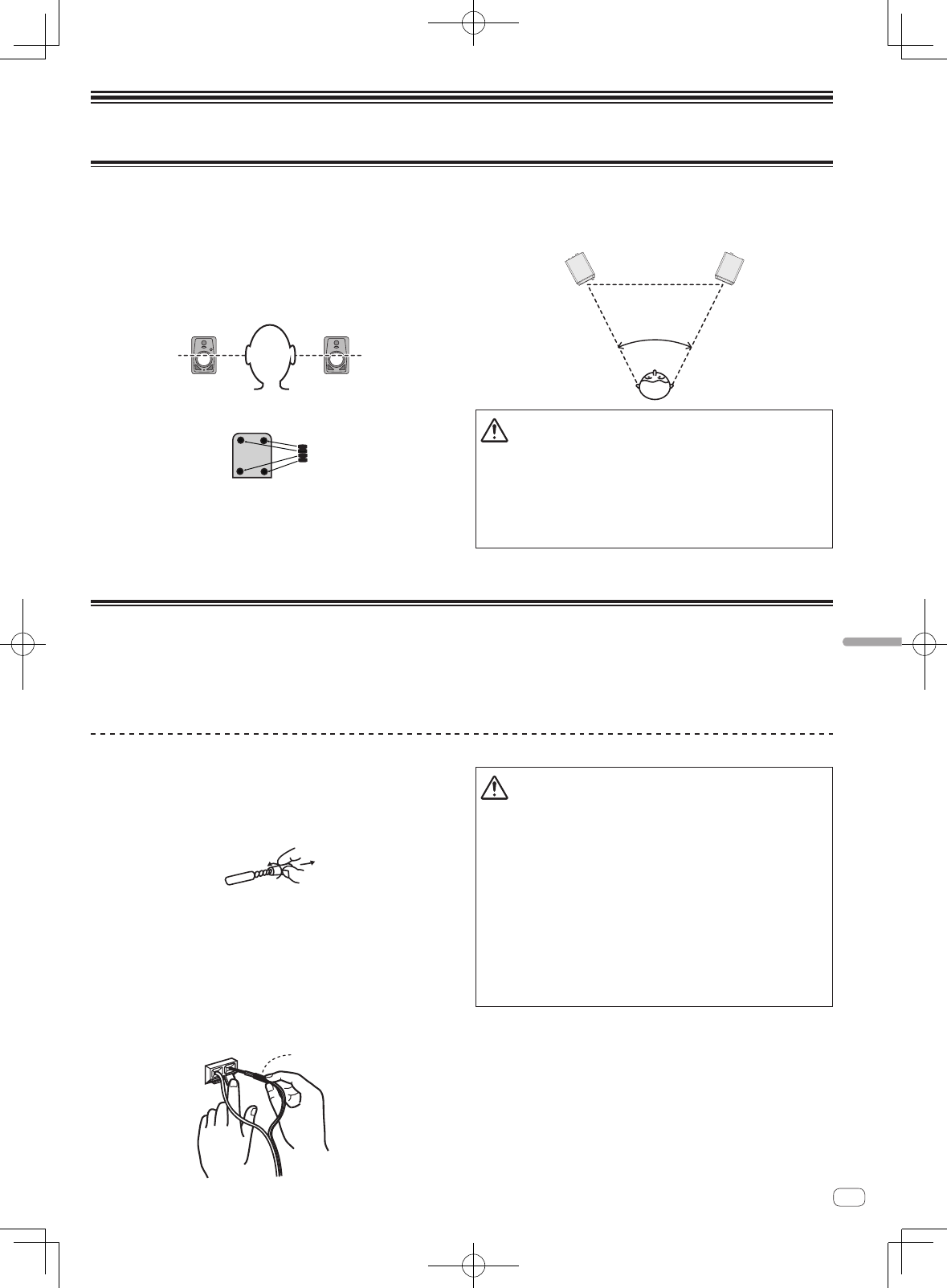
Es 5
Español
Instalación y conexiones
Procedimiento de instalación
El sonido de reproducción de un altavoz queda ligeramente afectado por
las condiciones de la sala de audición. Para producir las mejores condi-
ciones para la audición, tenga debidamente en cuenta las condiciones
del lugar de instalación antes de comenzar la instalación.
! Coloque los altavoces al nivel de los oídos.
! Para obtener un efecto estéreo natural, los altavoces derecho e
izquierdo deben instalarse simétricamente y en posiciones equidis-
tantes de la posición de audición.
! Fije las almohadillas suministradas en la parte inferior de la unidad
para evitar que resbale.
ADVERTENCIA
Guarde las piezas pequeñas fuera del alcance de los
niños. Si las ingirieran accidentalmente, póngase de
inmediato en contacto con un médico
.
D41-6-4_A1_Es
! Instale los altavoces orientados hacia dentro con un ángulo total de
60 grados desde la posición de escucha, 30 grados para cada uno de
los altavoces, izquierdo y derecho.
50 ° a 60 °
AVISO
Para favorecer una refrigeración adecuada asegúrese de que haya
suficiente espacio entre los altavoces, las paredes cercanas y otros
componentes (mínimo de 15 cm o más por encima, detrás, a la dere-
cha y a la izquierda de cada altavoz). Si deja un espacio insuficiente
entre el altavoz y las paredes u otros componentes, puede provocar
que aumente la temperatura interior, lo que puede provocar un mal
funcionamiento o daños.
Conexiones
! Asegúrese de desconectar la alimentación y desenchufar el cable
de alimentación de la toma de corriente siempre que haga o cambie
conexiones.
! Consulte el manual de instrucciones del componente que va a ser
conectado.
! Conecte el cable de alimentación después de terminar las conexio-
nes entre los aparatos.
! Asegúrese de usar el cable de alimentación incluido.
! Tenga cuidado con el volumen porque las señales de entrada del ter-
minal [INPUT 1], del terminal [INPUT 2] y del Bluetooth se mezclan.
Conexión de los cables
Conecte a los altavoces el cable de altavoces que se incluye.
1 Pele 1 cm de la punta del cable que se incluye y
retuerza y retire el aislante expuesto.
Tras retirar el aislante, retuerza los cables.
2 Conecte el cable del altavoz que se incluye con
los terminales del altavoz de los lados IZQUIERDO y
DERECHO.
3 Inserte los cables en los terminales mientras presiona
la pinza del terminal del altavoz.
Conecte el cable del altavoz con la línea roja en el lado del terminal
+ (rojo) y el cable del altavoz sin la línea roja en el lado del terminal
– (negro).
Rojo +
Negro
−
Con la línea roja
AVISO
! Tras conectar los terminales, tire ligeramente del cable del altavoz
para asegurarse de que las puntas del cable del altavoz se hayan
conectado de forma segura con los terminales. Una conexión floja
puede hacer que la salida de audio se interrumpa o se emita ruido.
! Cuando conecte el cable del altavoz, retuerza a fondo los cables
y asegúrese de que no sobresalgan de los terminales del altavoz.
Los cables que sobresalgan de los terminales del altavoz pueden
entrar en contacto con el panel trasero o entre ellos. Esto puede
provocar una carga excesiva en el amplificador, lo que puede
hacer que no funcione o puede provocar una avería.
! Si se comete una equivocación con las polaridades (+, –) en los
lados IZQUIERDO y DERECHO cuando se conecta el cable del
altavoz IZQUIERDO y DERECHO, es posible que ya no se obtenga
el efecto de estéreo normal.
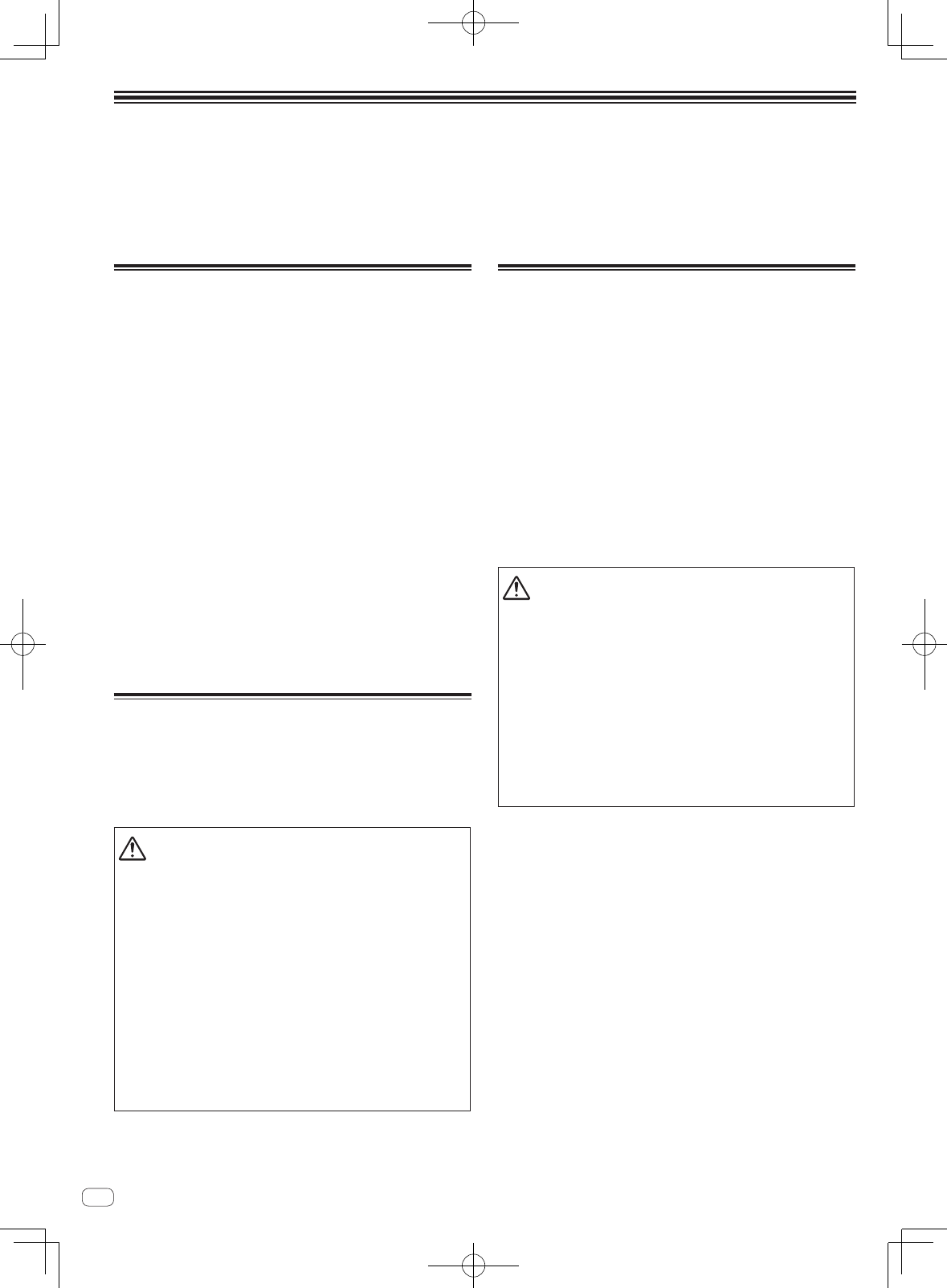
Es
6
Cómo escuchar música de un dispositivo
Bluetooth
Estos altavoces permiten disfrutar inalámbricamente de las pistas guardadas en un dispositivo Bluetooth.
Al utilizar los altavoces por primera vez o al conectar un nuevo dispositivo Bluetooth a los altavoces, hay que emparejar los altavoces y el dispositivo
Bluetooth.
El emparejamiento (registro mutuo de dispositivos) es la operación necesaria para conectar un dispositivo Bluetooth y los altavoces.
Procedimiento de emparejamiento
y conexión
1 Encienda el interruptor [POWER] para encender los
altavoces.
! El indicador Bluetooth parpadeará durante aproximadamente 30
segundos y los altavoces entrarán en estado de emparejamiento.
! Si el indicador Bluetooth está apagado, pulse el botón de empareja-
miento durante al menos 2 segundos para volver a cambiar al estado
de emparejamiento.
2 Realice la operación de emparejamiento en el
dispositivo Bluetooth.
Realice la operación mientras los altavoces estén en estado de
emparejamiento.
Para más información, consulte el manual de instrucciones del disposi-
tivo Bluetooth.
3 Cuando el indicador Bluetooth cambie de estar
parpadeando a estar encendido, se habrá completado el
emparejamiento (o conexión).
Si no se ha podido realizar el emparejamiento en 30 segundos, el indica-
dor Bluetooth pasará de parpadear a apagarse.
! Un dispositivo Bluetooth que ya se ha emparejado se puede conec-
tar realizando la operación de conexión en el lado del dispositivo
Bluetooth si los altavoces están encendidos.
Reproducción
Al reproducir música en un dispositivo Bluetooth conectado, la música
reproducida en el dispositivo Bluetooth se emite por los altavoces.
! Si pulsa el botón de emparejamiento durante la reproducción de
música en el dispositivo Bluetooth, podrá ejecutar la operación de
pausa/reproducción (la misma función que la del botón de pausa/
reproducción del dispositivo Bluetooth).
ATTENTION
! Al realizar el emparejamiento (conexión), acerque el dispositivo
Bluetooth a los altavoces.
! El sonido puede emitirse a un volumen alto al reproducir por prim-
era vez tras realizar la conexión, por lo que recomendamos bajar el
volumen antes de reproducir sonido.
! Según la aplicación que se utilice, puede que no funcione la oper-
ación de pausa/reproducción con el botón de emparejamiento.
! Puede que no sea posible establecer una conexión con los altavo-
ces según cuál sea el dispositivo Bluetooth.
! Si desea emparejar los altavoces con otro dispositivo Bluetooth,
desactive la función Bluetooth del dispositivo Bluetooth que esté
ahora conectado o desconecte la conexión antes de realizar el
emparejamiento.
! Los altavoces guardan la información de emparejamiento de
hasta ocho dispositivos Bluetooth, e intentan conectarse al último
dispositivo emparejado si se pulsa el botón de emparejamiento sin
conexión con un dispositivo Bluetooth.
Precauciones con las ondas de radio
Esta unidad emplea una frecuencia de onda de radio de 2,4 GHz, que es
una banda utilizada por otros sistemas inalámbricos (consulte la lista
siguiente). Para evitar ruidos o interrupciones de la comunicación, no
emplee esta unidad cerca de estos dispositivos, o compruebe que tales
dispositivos estén apagados durante la utilización.
! Teléfonos inalámbricos
! Facsímiles inalámbricos
! Hornos de microondas
! Dispositivos LAN inalámbricos (IEEE802.11b/g)
! Equipos audiovisuales inalámbricos
! Controladores inalámbricos para sistemas de juegos
! Equipos médicos por microondas
! Algunos monitores para niños
Otros equipos menos comunes que puedan utilizar la misma frecuencia:
! Sistemas antirrobo
! Emisoras de radioaficionados (HAM)
! Sistemas de gestión logística de almacenes
! Sistemas de discriminación para trenes o vehículos de emergencia
CAUTION
! En caso de que aparezca ruido en la imagen de su televisor, es
posible que un dispositivo Bluetooth® o esta unidad (incluidos
productos compatibles con esta unidad) causen interferencias en
las señales con el conector de entrada de la antena del televisor,
vídeo, sintonizador de satélite, etc. En tal caso, aumente la distan-
cia entre el conector de la entrada de la antena y el dispositivo
Bluetooth o esta unidad (incluyendo productos compatibles con
esta unidad).
! Si hay algo que obstruya el paso entre esta unidad (incluyendo los
productos compatibles con esta unidad) y el dispositivo habilitado
con tecnología inalámbrica Bluetooth (como pueda ser una puerta
metálica, un muro de hormigón o papel de aluminio aislante), es
posible que tenga que cambiar la ubicación del sistema para evitar
ruidos en la señal e interrupciones.
Para los usuarios de México
La operación de este equipo está sujeta a las siguientes dos condicio-
nes: (1) es posible que este equipo o dispositivo no cause interferencia
perjudicial y (2) este equipo o dispositivo debe aceptar cualquier interfer-
encia, incluyendo la que pueda causar su operación no deseada.